COWBOY FOOTBALL EVOLVES

PAGE 26



AUTO GROUP CHICKASHA • DUNCAN • OKC 800-752-2360 ByfordAutoGroup.com BYFORD BUICK GMC – CHICKASHA • 2900 S. Hwy. 81 n BYFORD CHEVY BUICK GMC – DUNCAN • 1909 N. Hwy. 81 BYFORD CHRYSLER DODGE JEEP RAM – DUNCAN •307 N. Hwy. 81 n BYFORD MOTORS – OKC • I-240 & Shields How to get around the car buying maze. Byford Auto Group.
In honor of four of our employees who have had recent and ongoing battles with cancer, Emrick’s will donate $50 to Coaches vs. Cancer for each OSU employee or alumni interstate move. Please mention this ad when you call our office.

THERE HAVE BEEN A LOT OF HEADLINES

surrounding OSU Athletics this spring. We crowned three individual national champions, MADE A RUN AT NATIONAL TITLE NUMBER 52 AND WE USHERED IN A NEW ERA IN MEN’S BASKETBALL. March was a pretty productive month.
One of the signs of a good coach is how well his or her team performs at crunch time. And while we certainly don’t need more validation of the skills of John Smith , there are some folks in the wrestling world who think he TURNED IN ONE OF THE BEST COACHING JOBS OF HIS CAREER THIS SPRING. OSU was the runner-up at the recently completed NCAA WRESTLING NATIONAL TOURNAMENT and TWO MORE COWBOYS WERE CROWNED INDIVIDUAL NATIONAL CHAMPS ( Dean Heil AND Alex Dieringer).
Greetings OSU fans,
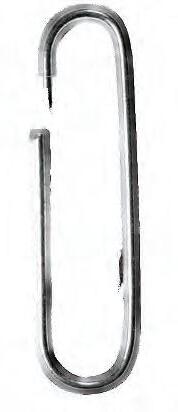
THE STANDARDS OF OUR WRESTLING PROGRAM ARE HIGH with banners always a goal. But this group of Cowboys improved throughout the season and overcame the loss of two starters, and probably a pile of points at the NCAAs, to finish second.
Speaking of coaches, Dave Smith keeps making progress with our track and cross country programs. THE LATEST SUCCESS STORY CAME at the NCAA INDOOR TRACK AND FIELD NATIONAL CHAMPIONSHIPS. The Cowgirls finished 10th, SETTING A NEW HIGH-WATER MARK FOR THE PROGRAM. And Kaela Edwards’ INDIVIDUAL TITLE IN THE MILE RUN was the FOURTH INDIVIDUAL CHAMPIONSHIP IN OSU HISTORY. Smith also led the men’s team to its SECOND BIG 12 INDOOR TRACK AND FIELD CHAMPIONSHIP IN THE PAST THREE YEARS.
One week after the NCAA wrestling concluded, WE CELEBRATED THE ARRIVAL OF NEW MEN’S BASKETBALL COACH Brad Underwood. It seems pretty obvious from the outset that COACH UNDERWOOD AND OKLAHOMA STATE FIT TOGETHER. He has tremendous respect for the history of our program and many of the same coaching philosophies that have been the foundation of Cowboy Basketball for decades.
THE HISTORY AND ATMOSPHERE OF Gallagher-Iba Arena AND Gallagher Hall before it are part of what attracted Coach Underwood to Oklahoma State. He’s like all of us. HE KNOWS WHAT OSU BASKETBALL CAN BE. AND HE ALSO KNOWS THE HISTORY AND ATMOSPHERE COMES FROM THE FANS.
WE HOPE YOU WILL JOIN US IN MAKING NEW MEMORIES IN GALLAGHER-IBA ARENA.
MIKE HOLDER DIRECTOR, INTERCOLLEGIATE ATHLETICS

4 PHOTO / BRUCE WAERFIELD
SPRING 2016
GO POKES!
PLAY BOOK
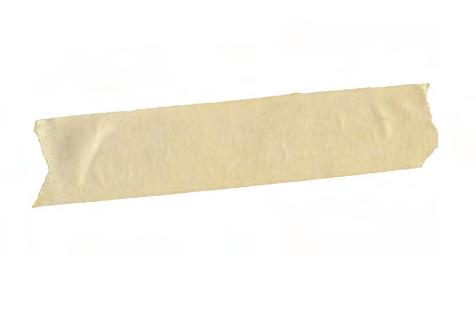



ALL-TIME GREAT
COWGIRL Brittney Martin was named the BIG 12 CONFERENCE PLAYER OF THE YEAR this past season, along with co-defensive POY. She was also a FIRST-TEAM ACADEMIC ALL-BIG 12 PERFORMER.
The senior from Syracuse, Utah, became the first player to lead the league in scoring, rebounding and steals in the same season. Martin averaged 20.4 points, 11.2 rebounds and 2.8 steals per contest (including 20 doubledoubles) on her way to garnering several All-America honors.
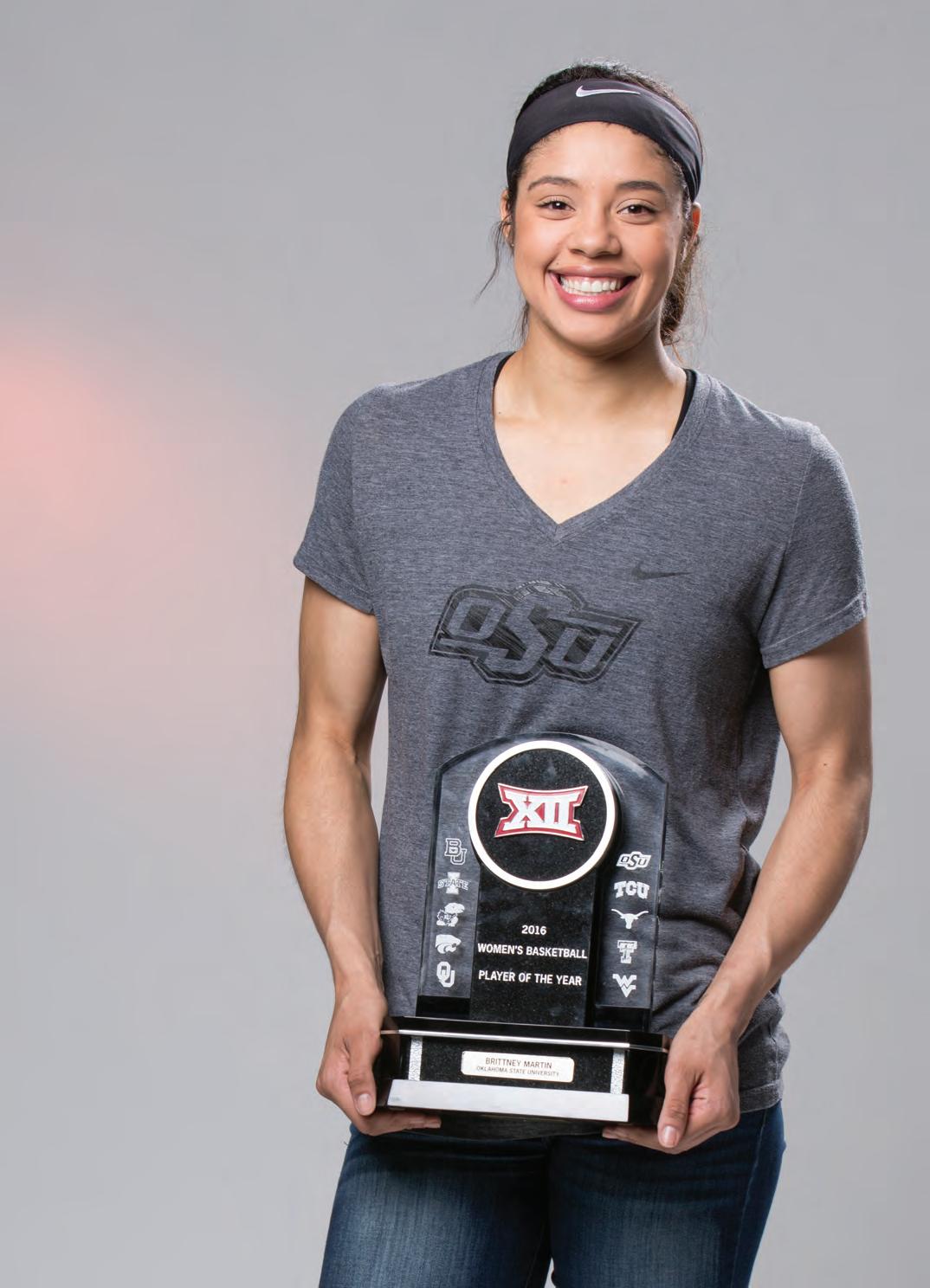
Brittney Martin
5
2016 VOL.9 SPRING the
COVER PHOTOGRAPHY BY BRUCE WATERFIELD
STUDENT-ATHLETE 16 Orange County to Orange Country COVER STORY 26 The Eye of the Beholder STUDENT-ATHLETE 34 Track Shoes & Tiaras 50 Mr. Iba’s Last All-American 58 Things We Learned From Tommy Moore 62 The Wizardry of Walton 74 Downhill Slide DEPARTMENTS FEATURES 20 The 150 72 The Honor Roll A WALK IN THE PARK 82 Wrav!ngs
PHOTO / BRUCE WATERFIELD
A LEGEND’S LEGACY
Several prominent members of HENRY IBA’s family were on hand for the introduction of BRAD UNDERWOOD as the NEW OKLAHOMA STATE MEN’S BASKETBALL COACH on March 23. Underwood is a member of the Iba coaching tree through his former mentor, JACK HARTMA N , who coached at Kansas State. Hartman played for Oklahoma A&M.
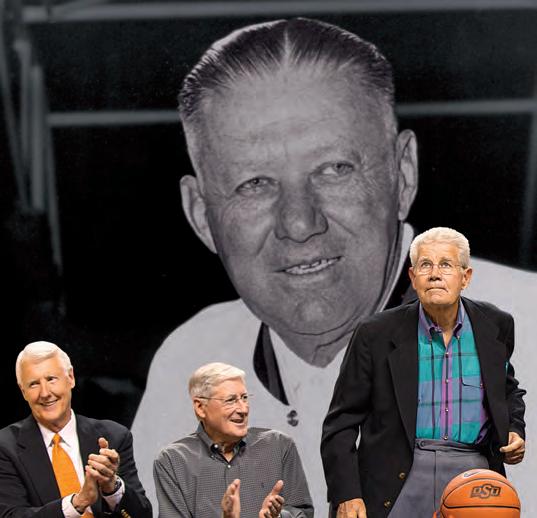
Mr. Iba’s nephews SKIP (OSU PLAYER 1963-66), GENE (OSU GRADUATE ASSISTANT 1966-68) and son MOE (OSU PLAYER 1958-62) enjoyed a standing ovation from the Cowboy fans in attendance at the arena that bears the Iba name.
POSSE POKES
POSSE MAGAZINE STAFF
VICE PRESIDENT OF ENROLLMENT MANAGEMENT / MARKETING KYLE WRAY
EDITOR-IN-CHIEF / SENIOR ASSOCIATE ATHLETIC DIRECTOR KEVIN KLINTWORTH
SENIOR ASSOCIATE ATHLETIC DIRECTOR / EXTERNAL AFFAIRS JESSE MARTIN
ART DIRECTOR / DESIGNER PAUL V. FLEMING
LEAD DESIGNER DAVE MALEC / DESIGNER SHELBY ALLYN HOLCOMB
PHOTOGRAPHER / PRODUCTION ASSISTANT BRUCE WATERFIELD
ASSISTANT EDITOR CLAY BILLMAN
CONTRIBUTING PHOTOGRAPHERS GARY LAWSON, CLAY BILLMAM, WESLEY HITT
CONTRIBUTING WRITERS RYAN CAMERON, JOHN HELSLEY, GENE JOHNSON, WADE M c WHORTER, AUSTIN CHAPPELL, CLAY BILLMAN, KEVIN KLINTWORTH
ATHLETICS ANNUAL GIVING (POSSE) DEVELOPMENT STAFF
ASSISTANT ATHLETIC DIRECTOR / POSSE DIRECTOR ELLEN AYRES
PREMIUM SERVICES DIRECTOR KARYL HENRY
PUBLICATIONS COORDINATOR CLAY BILLMAN
ASSISTANT DIRECTOR, ANNUAL GIVING JOE NELSON
COORDINATOR, ANNUAL GIVING STEPHANIE BOESE
ATHLETICS MAJOR GIFT DEVELOPMENT STAFF
SENIOR ASSOCIATE ATHLETIC DIRECTOR / DEVELOPMENT LARRY REECE
DIRECTOR OF DEVELOPMENT / ATHLETICS MATT GRANTHAM
PROJECT MANAGER SHAWN TAYLOR
OSU POSSE
1 02 ATHLETICS CENTER
S TILLWATER, OK 74078-5070
4 05.744.7301 P
4 05.744.9084 F
OK STATEPOSSE.COM
O KSTATEPOSSE
PO SSE@OKSTATE.EDU
@O SUPOSSE
AD VERTISING 405.744.7301
EDITORIAL 405.744.1706
At Oklahoma State University, compliance with NCAA, Big 12 and institutional rules is of the utmost importance. As a supporter of OSU, please remember that maintaining the integrity of the University and the Athletic Department is your first responsibility. As a donor, and therefore booster of OSU, NCAA rules apply to you. If you have any questions, feel free to call the OSU Office of Athletic Compliance at 405-744-7862. Additional information can also be found by clicking on the Compliance tab of the Athletic Department web-site at www.okstate.com
Remember to always “Ask Before You Act.”
Respectfully,
BEN DYSON
ASSISTANT ATHLETIC DIRECTOR FOR COMPLIANCE
Donations received may be transferred to Cowboy Athletics, Inc. in accordance with the Joint Resolution among Oklahoma State University, the Oklahoma State University Foundation, and Cowboy Athletics, Inc.
POSSE magazine is published four times a year by Oklahoma State University Athletic Department and the POSSE, and is mailed to current members of the POSSE. Magazine subscriptions available by membership in the POSSE only. Membership is $150 annually. Postage paid at Stillwater, OK, and additional mailing offices. Oklahoma State University, in compliance with Title VI and VII of the Civil Rights Act of 1964, Executive Order 11246 as amended, and Title IX of the Education Amendments of 1972 (Higher Education Act), the Americans with Disabilities Act of 1990, and other federal and state laws and regulations, does not discriminate on the basis of race, color, national origin, sex, age, sexual orientation, gender identity, religion, disability, or status as a veteran, in any of its policies, practices or procedures. This provision includes, but is not limited to admissions, employment, financial aid, and educational services. The following have been designated to handle inquiries regarding non-discrimination policies: Director of Equal Opportunity, 408 Whitehurst, OSU, Stillwater, OK 74078-1035; Phone 405-744-9154; email: eeo@okstate.edu. This publication, issued by Oklahoma State University as authorized by the Senior Associate Athletic Director, POSSE, was printed by Royal Printing Company at a cost of $1.115 per issue.
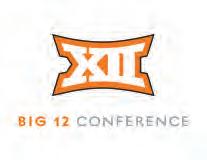
6
POSSE magazine is published four times a year by Oklahoma State University, 121 Cordell North Stillwater, OK 74078. The magazine is produced by OSU Athletics and University Marketing, and is mailed to current members of the POSSE Association. Membership starts at $150/year and includes benefits such as the POSSE Magazine and member auto decals. POSSE annual funds contribute to student-athlete scholarships and operating expenses, which are critical to helping our teams stay competitive. Gifts of all sizes
all areas of athletics. Postage
at
OK, and additional mailing offices.
8.175M/April 2016/#6407.
impact
paid
Stillwater,
PHOTO / BRUCE WATERFIELD
MOE IBA GENE IBA SKIP IBA
forthe LABEL
When you purchase licensed products, a portion of your purchase price goes to support scholarships and other university programs.

Oklahoma State University: Live Orange
@OSUGear
@OSUGear
Get information on new retailers, merchandise and promotions.

HELP OSU BY BUYING ONLY LICENSED PRODUCTS. LOOK
HIRE CALLING
The OSU athletic department, as well as thousands of orangeclad fans, welcomed new men’s basketball head coach Brad
Underwood to the Cowboy family on March 23 on GallagherIba Arena’s Eddie Sutton Court . In attendance were current and former Cowboy basketball standouts as well as members of legendary coach Henry Iba’s family, along with campus dignitaries.
Underwood arrives at OSU following a three-year stint at Stephen F. Austin that ranks as one of the best starts to a head coaching career in college basketball history. The 1986 graduate of Kansas State played for former Oklahoma A&M football and basketball standout Jack Hartman, a disciple of Mr. Iba.
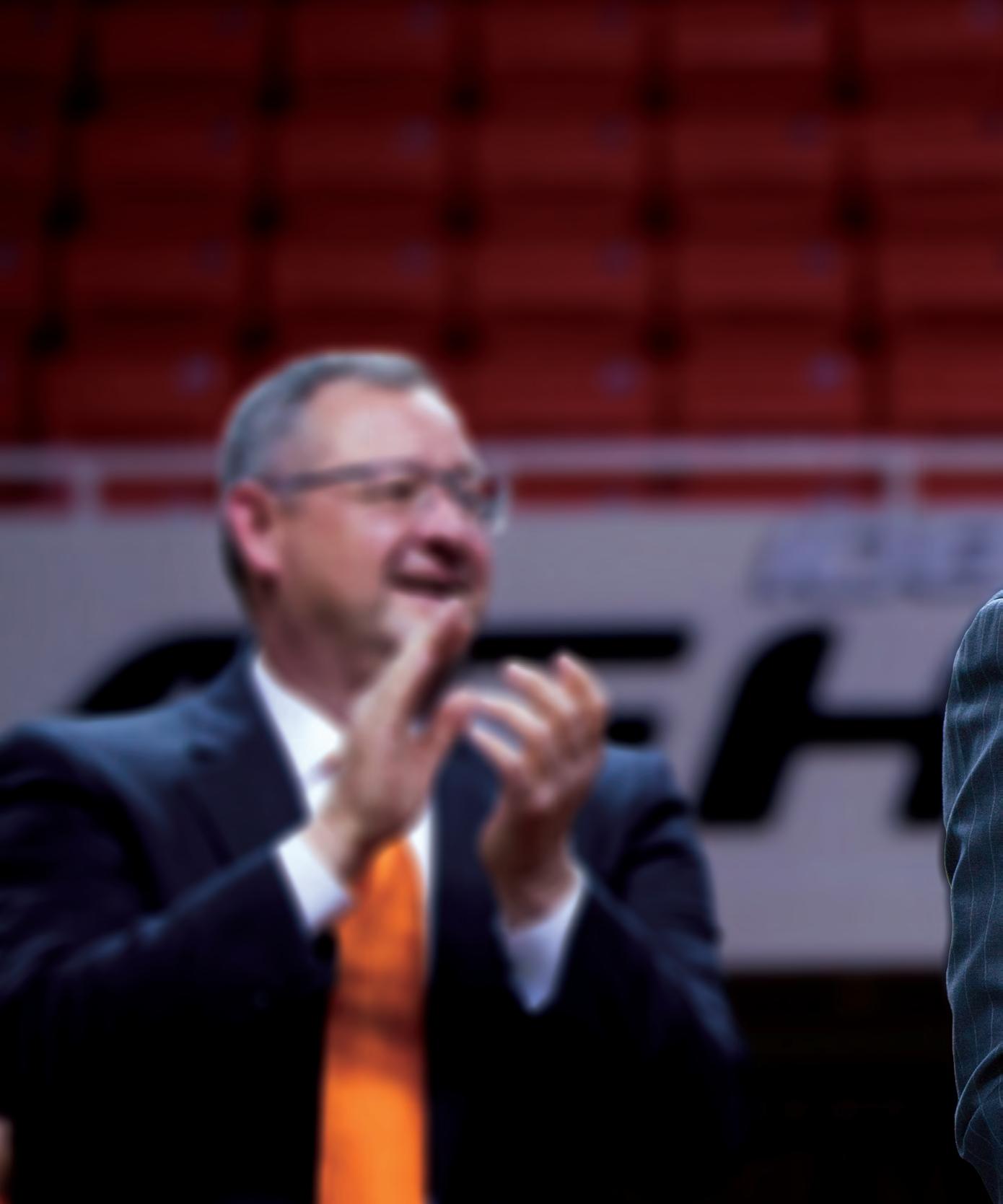
8
PHOTOGRAPHY BY BRUCE WATERFIELD
SPRING 2016
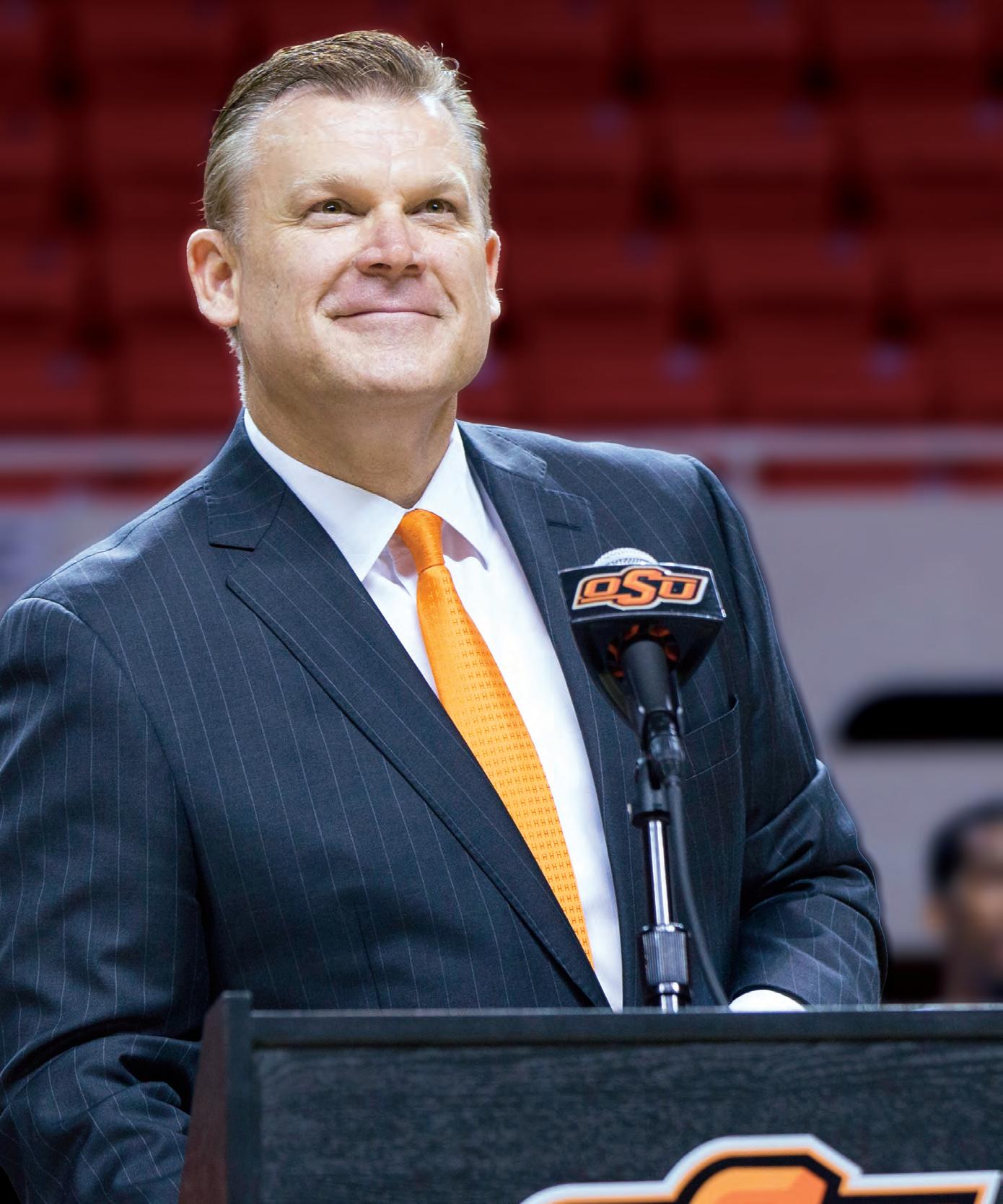
9
Did You See It?
2016 BIG 12 CHAMPIONSHIP
3/26/16 VS. BAYLOR

10
PHOTOGRAPHY BY BRUCE WATERFIELD
SPRING 2016
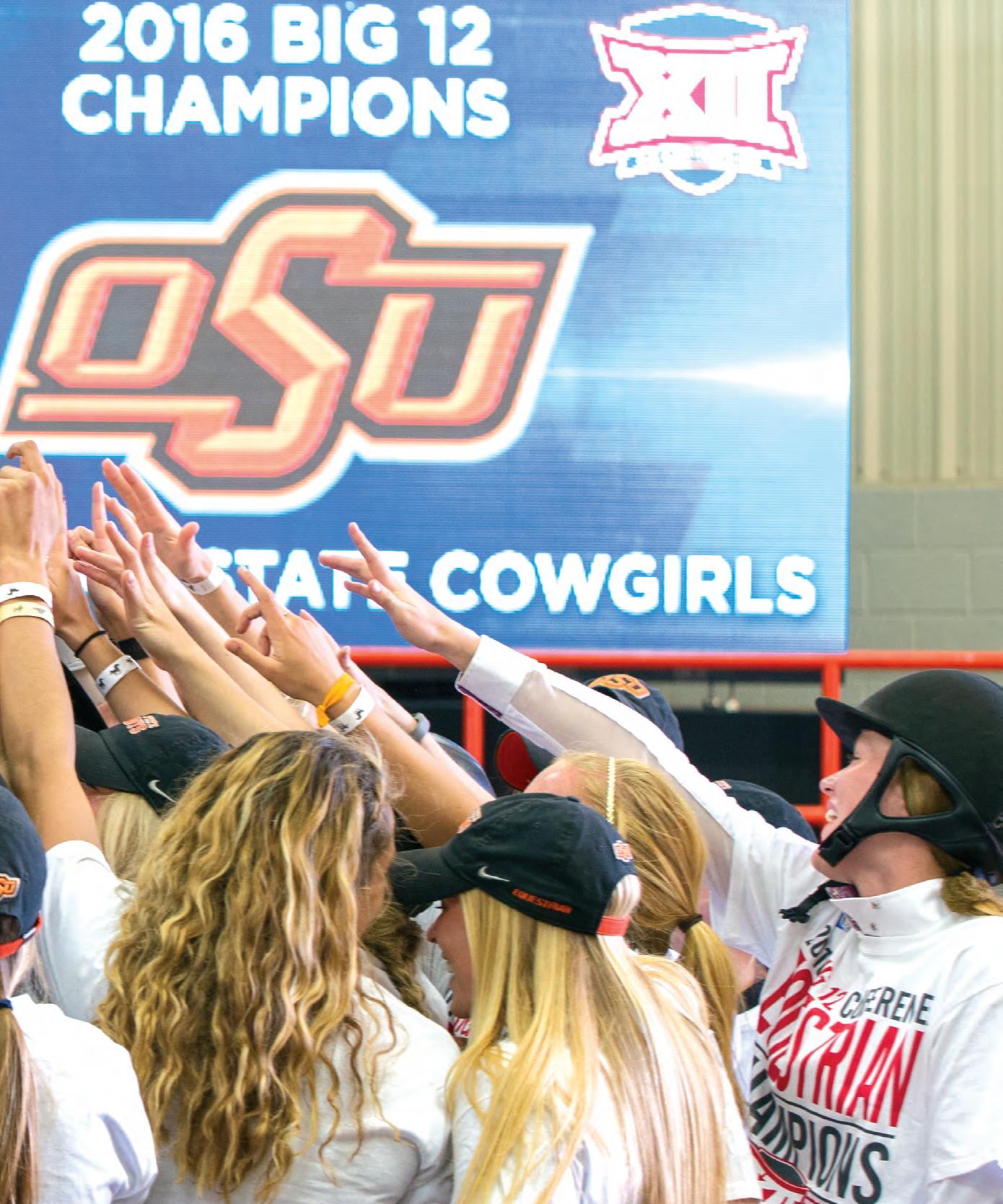
11
Football Tickets on sale now
OKSTATE.COM/RENEWAL
877.ALL.4OSU (877-255-4678)

12
PHOTOGRAPHY BY BRUCE WATERFIELD
SPRING 2016
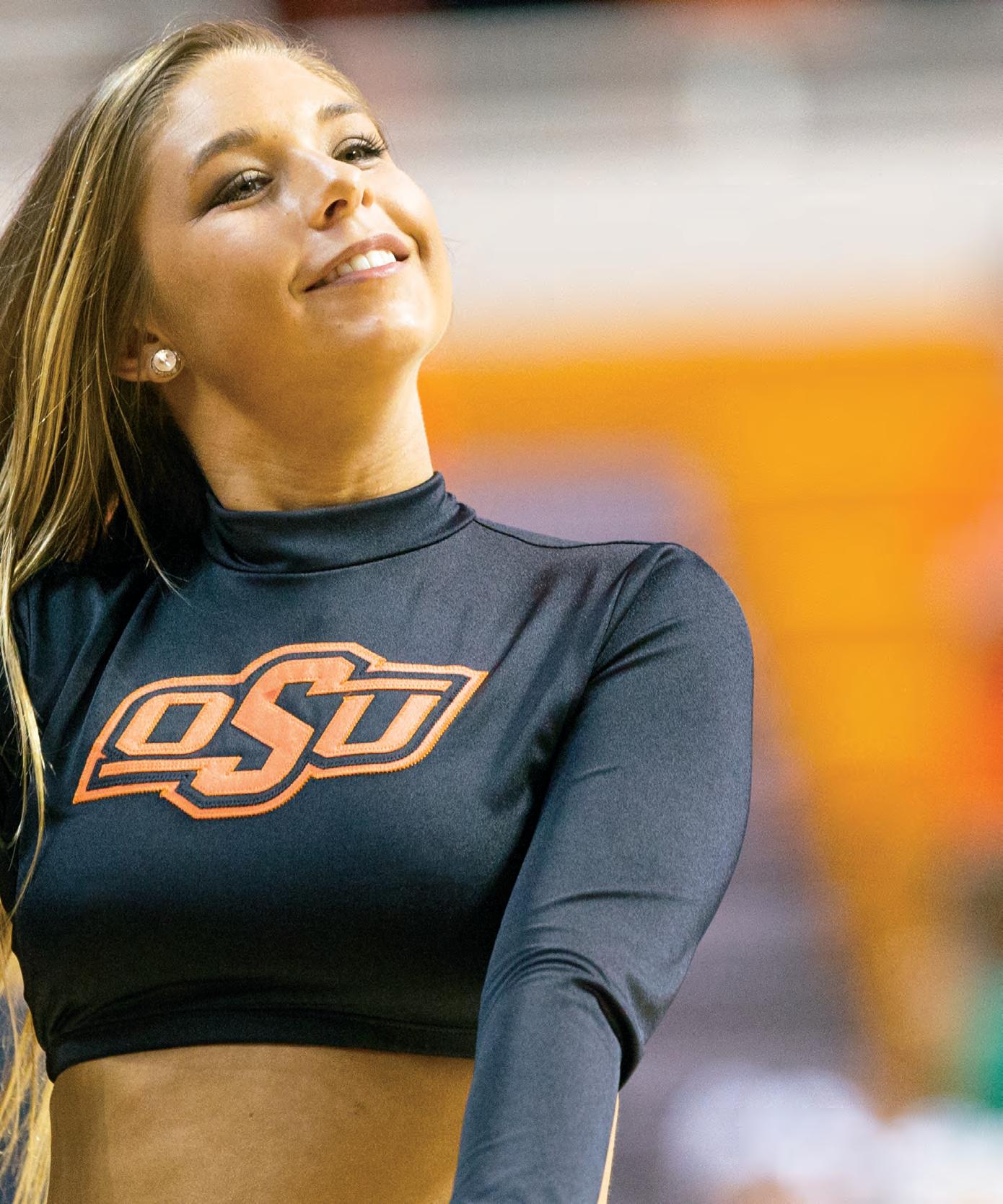
13







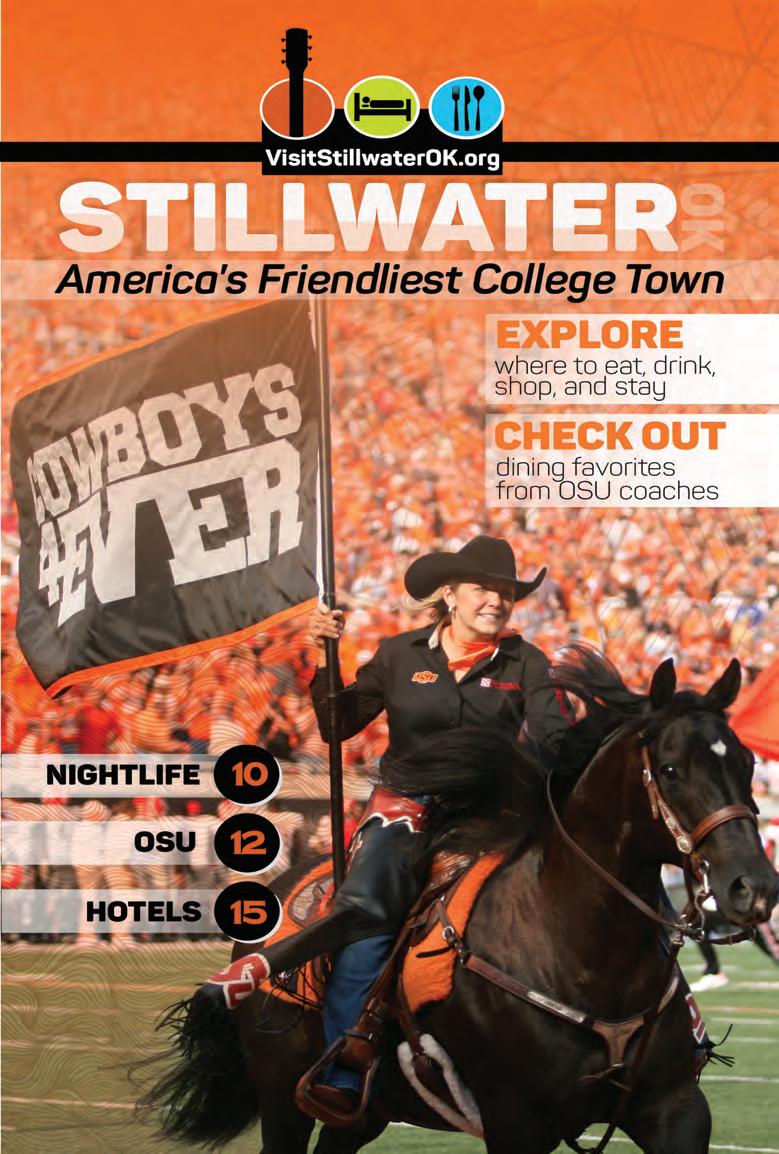



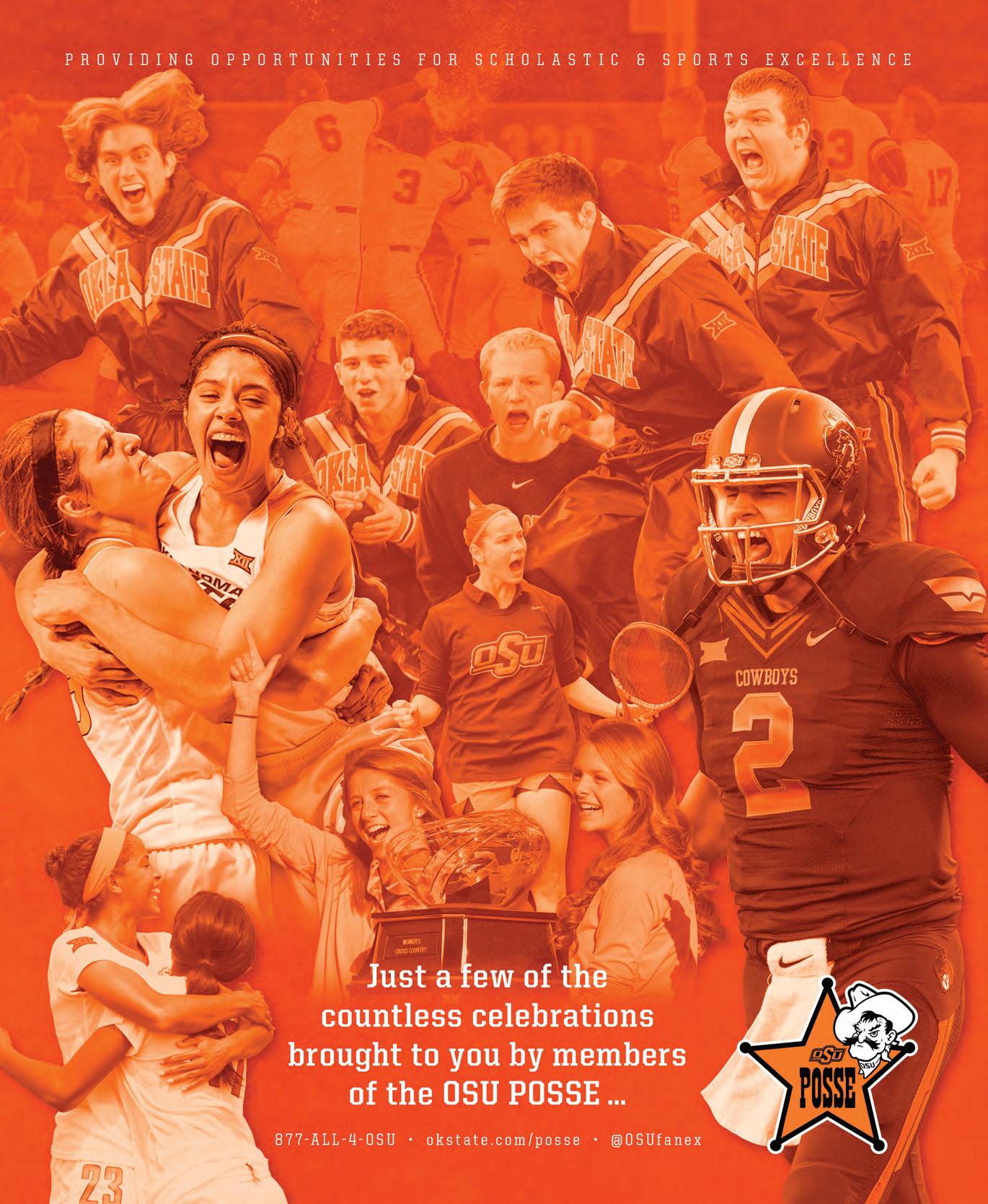
ORANGE COUNTY TO ORANGE COUNTRY
STORY BY AUSTIN CHAPPELL | PHOTOGRAPHY BY BRUCE WATERFIELD
While the 2011 Oklahoma State softball team was preparing for its Women’s College World Series appearance, a budding prospect was lighting up the fields nearly 1,400 miles away in Aliso Viejo, Calif., on the southern edge of Orange County.
SOUTHERN CALIFORNIA is a softball hotbed and produces talent for programs across the country, and especially west coast staples like Arizona, Arizona State, Stanford, Washington and California. Eleven-time WCWS winner UCLA was in the backyard of Tiffany Mikkelson , now a Cowgirl senior.
“I DIDN’T EVEN TALK TO ANYONE OTHER THAN OSU,” Mikkelson said. “I sent out some emails and stuff, and I went on trips to visit a couple of schools. OSU WAS MY FIRST OFFER, AND I SAW THE SCHOOL AND ABSOLUTELY LOVED IT. After that, no one even contacted me because I was so set on OSU. WHEN I MADE MY VISIT TO OSU, I KNEW IT WAS EXACTLY WHERE I WANTED TO GO.”

Mikkelson was the only freshman to start all 56 games in 2013. She quickly established herself as one of the team’s most reliable offensive assets with a .286 batting average, four home runs and a team-leading 13 doubles.
The opportunity to make an early and crucial contribution paid big dividends as SHE BECAME A BUILDING BLOCK FOR THE PROGRAM throughout the rest of her career.
“IT WAS HARD, TO BE HONEST, but I just wanted to help as much as I could,” Mikkelson said. “It was definitely a shock because I was in Oklahoma, where I had never been before. I didn’t know anyone other than the girls on the softball team. I feel like that had a lot to do with how I played. ONCE I GOT USED TO IT AND KNEW THAT THE GIRLS WERE BEHIND ME, I got more comfortable. IT TURNED OUT TO BE A REALLY FUN SEASON.”
16
SPRING 2016
(TIFFANY) HAD EXPERIENCE AND A KNOWLEDGE OF THE GAME THAT WOULD ULTIMATELY HELP HER PRODUCE ONE OF THE GREATEST SINGLE-SEASON PERFORMANCES IN THE COWGIRLS’ 38-YEAR HISTORY.
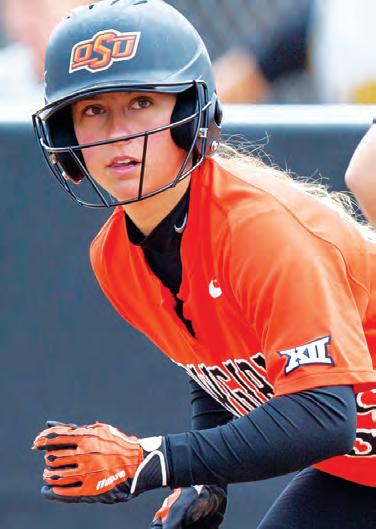
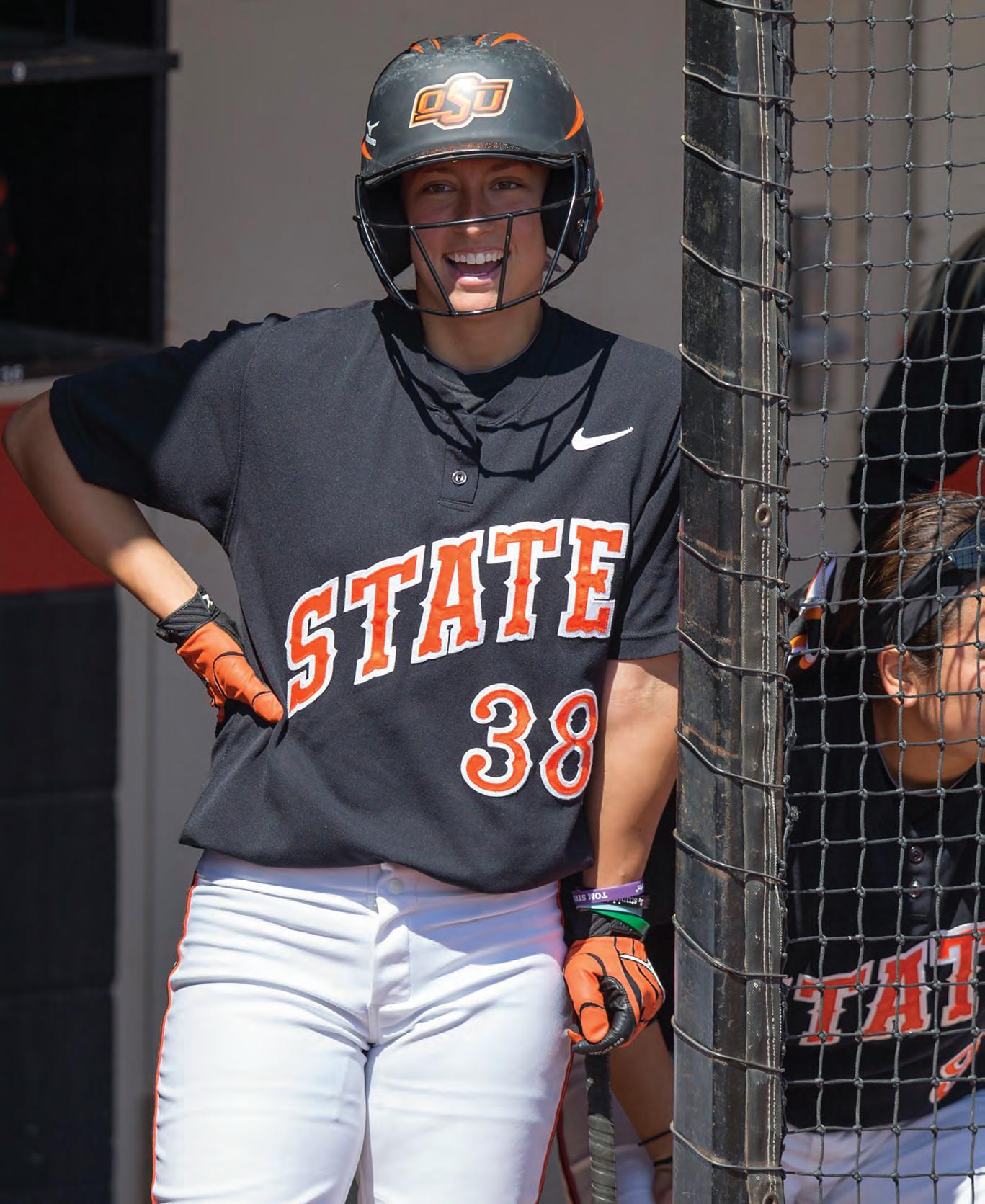
17

After just missing out on an NCAA Tournament, Mikkelson used the time between her freshman and sophomore seasons to transition from a role player into the team’s offensive leader. In 2014, she increased her numbers in nearly every offensive category. Her added experience helped her develop a presence as a leader.
“I’m just not the type to really say much, and I feel like I lead more by example,” Mikkelson said. “IF I COULD PASS ONE THING DOWN TO THE FRESHMEN AND THE GIRLS COMING IN, IT WOULD BE BODY LANGUAGE. I would say that if you want to be someone that others look up to, you need to have good body language.”
“People look at that more than what you’re saying. I DO TRY TO HAVE GREAT BODY LANGUAGE NO MATTER WHAT THE SITUATION IS. I try to just smile, make jokes and keep it light.”
She began to flash signs of her true power potential as a sophomore when she led the Cowgirls with seven home runs and a .544 slugging percentage. But those first two seasons were only the tip of the iceberg.
With only two seniors on the 2015 Cowgirl squad, Mikkelson was essentially on top of the totem pole as a junior. And with over 100 career starts, she had experience and a knowledge of the game that would ultimately help her produce one of the greatest single-season performances in the Cowgirls’ 38-year history.
SHE CONSTANTLY STUFFED THE STAT SHEET WITH NOTABLE NUMBERS IN CATEGORIES LIKE WALKS, STOLEN BASES AND RBIS. NOT TO MENTION A BLISTERING .506 ON-BASE PERCENTAGE AND A .722 SLUGGING PERCENTAGE. Both marks are second best in school history.
PERHAPS THE MOST EYE-POPPING STATISTIC OF MIKKELSON’S 2015 SEASON WAS THAT SHE DIDN’T HIT A HOME RUN UNTIL GAME 15, when she broke out with a pair of bombs against North Texas. She then reeled off 13 homers in only 38 games.
“It took me forever to finally hit a home run last year,” Mikkelson said. “At one point I was like, ‘Do I even know how to hit one anymore? But once I finally got that first one out of the way, everything came naturally, and it was a blast being able to make that much of a contribution for the team.”
One highlight from her 2015 campaign came at Iowa State where the Cowgirls took a series from the Cyclones. In the opener, she lit up ISU with a pair of home runs, including a three-run blast that helped OSU register a run-rule victory.

IOWA STATE REFUSED TO PITCH TO MIKKELSON THE FOLLOWING DAY. In an 8-6 OSU victory, THE ISU PITCHING STAFF WALKED HER A SCHOOL RECORD FIVE TIMES, and the rest of the Cowgirl lineup provided enough run support to earn the win.
“I actually remember that vividly because I could not understand why they wouldn’t pitch to me,” Mikkelson said. “I just wanted them to throw to me so I could hit, but I’ve never seen anything like that. In a way, I kind of felt honored that they might think that I’m good enough to pitch around and prevent a run here or there.”
Her junior season not only helped her earn first team All-Big 12 and NFCA All-Midwest Region honors, but it also vaulted her toward the top of numerous categories in the Oklahoma State record books.
18
SPRING 2016
“ONE HOME RUN ISN’T GOING TO WIN THE GAME ALL THE TIME.”
Her consistency at the plate led to a three-year cumulative batting average of .321, 13th best in OSU history. Her .434 career on-base percentage is good for sixth all-time at OSU. Mikkelson’s walk count took a huge leap in 2015 when she drew 39 bases on balls, nearly breaking a single-season OSU record and leaving her only 14 short of an OSU career record entering her senior season.
The power categories are where Mikkelson truly shines, though. She stands firmly among the most prominent sluggers in Cowgirl history. Her .569 slugging percentage rounds out the top three on the list of all-time greats at OSU, while her 113 RBIs are only 50 short of topping OSU legend Jaime Foutch ’s 163 set between 1996 and 1999.
As with any sport on the diamond, fans love the long ball. Mikkelson’s 13 homers in 2015 left her career total just nine short of the school record. Julie Ward hit 32 home runs between 2009 and 2012.
“I’M JUST GOING TO TRY MY BEST TO GET THAT PITCH THAT I WANT AND GET IN THE RIGHT COUNTS, put the ball in play and help the team,” she said. “I have to do something like that because if I’m going up there trying to hit a home run every time, I’m not going to do it. One home run isn’t going to win the game all the time. I just want to get on base and help the team any way that I can.”
Teammates say that Mikkelson is one of the most modest members of the squad, but she says the home run record is something that she can’t help but think about.
“I WANT NOTHING MORE THAN TO BREAK THAT RECORD,” Mikkelson said. “It’s on my mind 24/7. I really try not to think about it a lot because I feel like it could hinder how I play.
Despite recording one of the greatest individual efforts in an OSU uniform in 2015, Mikkelson and the Cowgirls finished with a 21-31 record in 2015.

The 2016 season has brought plenty of change as Oklahoma State introduced a new coaching staff headed by Kenny
Gajewski , who joined the Cowgirls after winning consecutive national titles as an assistant with Florida.
“I’m excited about them, about what we have done,” Gajewski said of his first squad. “I feel like I have 21 kids that have completely bought in. With a new staff, that is tough.”
One of Gajewski’s early decisions was to move Mikkelson from third base to the outfield.
As the owner of Cowgirl Stadium’s hot corner for the last three seasons, she consistently stood out as one of the Big 12’s most reliable defensive assets. MIKKELSON NEVER COMMITTED MORE THAN NINE ERRORS IN A SEASON at one of the toughest spots in the field.
“On a scale of one to five, it’d be like a seven in terms of how comfortable I am,” Mikkelson said of the move. “How much am I enjoying it? Probably closer to a 12. I love it. I LOVE PLAYING THE OUTFIELD.”
“I played in the outfield and switched between there and the infield during travel ball, so it isn’t the first time I’ve done it. I’m getting more comfortable, especially when I get balls hit to me. That’s definitely when I feel like I’m getting it.”
Gajewski also cites Mikkelson’s position change as an example of her teamfirst attitude.
“WE HAD TIFF IN LEFT FIELD ALL FALL, BUT WE JUST MOVED HER TO RIGHT,” Gajewski said. “I am so proud of her to make the transition in her last year. TO MAKE A MOVE AND NEVER SAY A WORD ABOUT IT IS PRETTY SPECIAL.”
Mikkelson’s numbers have made significant improvements with each passing season, putting her in position to leave a lasting impression on the program after her final year.
That impression will also provide benefits for the Cowgirl freshman class and incoming recruits who look to star in an Oklahoma State uniform. Mikkelson said she hopes that girls who make an impact early on in their careers can ultimately pass down the same traits and experiences she gained while earning a large amount of playing time as a freshman.
“With players who are coming in here and seeing the field early on, I just feel like they’re talented. If you’re talented, you should be playing,” Mikkelson said. “IT DOESN’T MATTER WHAT YEAR YOU ARE. IF YOU’RE GOING TO CONTRIBUTE AND BE A PART OF THE TEAM, YOU SHOULD BE ON THE FIELD.”
Mikkelson has only missed one game in her entire career and it came when she was a sophomore. Her start totals of 56 as a freshman, 53 as a sophomore and 52 as a junior further cements her value to the program.
“That one game I missed was because of a fluke. I stepped on third and sprained my ankle,” Mikkelson said.
“OVERALL, IT’S AN HONOR TO BE ABLE TO EXPERIENCE THAT MUCH SOFTBALL IN MY CAREER. NOT MANY PEOPLE CAN SAY THAT.”
NOT MANY PEOPLE ARE TIFFANY MIKKELSON.

20 20 Ken & Jimi Davidson 21 Bob Howard 22 ONEOK, Inc. 23 Watson Family Foundation 24 Kent & Margo Dunbar 25 Les & Cindy Dunavant 26 Chad Clay 27 Gary & Jerri Sparks 28 Richard & Barbara Bogert 29 Vickie & Tucker Link Foundation 30 Greg & Rhonda Casillas 31 The Cobb Family 32 Anonymous #1 33 RCB Bank 34 OG&E 35 Russ Harrison & Natalie Shirley 36 OSU Foundation 37 Brad & Margie Schultz 38 Joullian & Co Boone Pickens 6,108,738 1 39 Lew & Suzanne Meibergen 39,437 40 Jana Drummond 41 David & Tracy Kyle 42 Flintco, Inc. 43 Mike Bode & Preston Carrier 44 James & Mary Barnes 45 Bryant J. Coffman 46 G. Edward Evans 47 David & Julie Ronck 48 Anonymous #2 49 Bob Norris 50 Sparks Financial 51 E. Turner & Cynthia Davis 52 Garland & Penny Cupp 53 Wiese Family 54 Jay & Connie Wiese 55 Lambert Construction 56 OSU President’s Office 57 Pam J. Russell 58 Vicki & Jim Click 59 SST Software 60 Jerry & Rae Winchester 61 Jameson Family, LLC 62 Anonymous #3 63 Steve & Diane Tuttle 2 Malone & Amy Mitchell 3 William S. Smith 4 Neal & Jeanne Patterson 5 Dennis & Cindy Reilley 6 John Clerico 7 Michael & Anne Greenwood 8 W & W Steel, LLC 9 Karsten Manufacturing 10 Ross & Billie McKnight 11 Robert A. Funk 12 Anonymous #18 13 Walt & Peggy Helmerich 14 A.J. & Susan Jacques 15 Chesapeake Energy, Inc. 16 Harold & Joyce Courson 17 Bank SNB 18 Joe & Connie Mitchell 19 Mike & Robbie Holder 70,711 AS OF MARCH 15, 2016 17 SPRING 2016
HOW DO MY POINTS
OSU ATHLETICS PRIORITY POINT SYSTEM
The PRIORITY POINT SYSTEM provides a fair, consistent and transparent method of providing benefits to donors in exchange for their financial investments in OSU athletics.

DONORS GAIN POINTS THREE WAYS:
CONTRIBUTIONS: All current and lifetime contributions (cash or stock) are worth 3 points per $100 donation. Planned (deferred) gifts in the new Leave a Legacy Endowment Campaign will receive 1 point per $100.
COMMITMENT: Donors will earn one point each year for purchasing season tickets (one point per sport annually), as well as one point for each year of POSSE donations.
CONNECTION WITH THE UNIVERSITY: Donors (or their spouses) who are OSU Alumni receive a one-time 10 point bonus, as do OSU faculty/staff and letterwinners.
Points never diminish and will carry over to subsequent years. Donors retain all previously earned Priority Points in their giving history. For questions about the POSSE Priority Point System, email posse@okstate.edu or call us at 405.744.7301.
21 117 Brent & Mary Jane Wooten 118 Bill & Claudean Harrison 119 Johnsons of Kingfisher 120 MidFirst Bank 121 Chip & Cindy Beaver 122 Russ & Julie Teubner 123 Terry & Martha Barker 124 John & Gail Shaw 125 Larry Bump 126 Bob & Mary Haiges 127 Randy & Pati Thurman 16,556 128 Brad & Leah Gungoll 129 Karen Gallagher & Bob McCracken 130 Mike & Judy Johnson 131 Jim & Vanessa Hester 132 Chandler USA, Inc 133 Vionette & John Dunn 134 Jay & Fayenelle Helm 135 Drummond Investments 136 AEI Corporation - Oklahoma 137 Anonymous #14 138 James H. Williams 139 Mustang Fuel 140 Chris McCutchen 141 Bill & Karen Anderson 142 Jack Bowker Ford 143 Robert & Sharon Keating 144 Crossland Construction 145 Gary & Mary Ellen Bridwell 146 Barber-Dyson Ford Lincoln-Mercury 147 Randall & Carol White 148 Thomas Winton 149 James D. Carreker 150 John & Patti Brett 89 Ron & Marilynn McAfee 90 Z-Equipment, LLC 91 Larry Albin 92 Sandra Lee 93 The Bank of America 94 Steve & Jennifer Grigsby 95 Southwest Filter Co. 96 Emrick’s Van & Storage 97 Jerry Marshall 98 Darton & Jamie Zink 99 K.D. & Leitner Greiner 100 Chris & Julie Bridges 101 OSU Alumni Association 102 Mike & Glynda Pollard 103 Bryan Close 104 Jerry & Lynda Baker 105 The Oklahoman 106 A-Cross Ranch 19,422 107 Fechner Pump & Supply 108 Ed & Mary Malzahn 109 Ed & Kathy Raschen 110 Scott & Kim Verplank 111 Prosperity Bank 112 Austin & Betsy Kenyon 113 Steve & Vicki Farris 114 Ameristar Fence Products 115 Tatum Family 116 Stan & Shannon Clark 64 Atlas Paving Company 65 Andy Johnson 66 KNABCO Corp 67 American Fidelity 68 Calvin & Linda Anthony 69 Ike & Mary Beth Glass 70 Mark & Beth Brewer 71 Philip & Shannon Smith 72 David LeNorman 73 Richard & Joan Welborn 74 OSU Center for Health Sciences 75 BancFirst 76 David Bradshaw 77 Mark & Lisa Snell 24,612 78 JS Charter Investments, LLC 79 Barry & Roxanne Pollard 80 Bank of Oklahoma 81 Baab Legacy, LLC 82 Thomas & Barbara Naugle 83 Griff & Mindi Jones 84 Doug & Nickie Burns 85 Harvey & Donna Yost 86 Jack & Carol Corgan 87 Anonymous #4 88 Henry Wells
P OINTS RANK 193,415 TOP 5 34,850 50 20,317 10 0 7,627 250 3,813 500 1,968 1,000 697 2,500 184 5,000 62 7,500
AS OF MARCH 15, 2016
RANK?
PHOTOGRAPHY BY BRUCE WATERFIELD
FEAR THE BOW
JUNIOR Kaela Edwards became the FOURTH COWGIRL IN SCHOOL
HISTORY TO WIN A NATIONAL TITLE at the recent NCAA Indoor Track and Field Championships in Birmingham, Ala. WEARING HER SIGNATURE BOW, EDWARDS USED A STRONG KICK TO TAKE THE WOMEN’S MILE IN A TIME OF 4:35.62.
ALSO EARNING FIRST-TEAM ALL-AMERICA HONORS were Savannah Camacho (4TH, 800M) and Chase Ealey (6TH, SHOT PUT). AS A TEAM, the Cowgirls tallied A SCHOOLRECORD 18 POINTS at the Indoor Championships, good for 10TH PLACE and THE PROGRAM’S HIGHEST OVERALL FINISH.
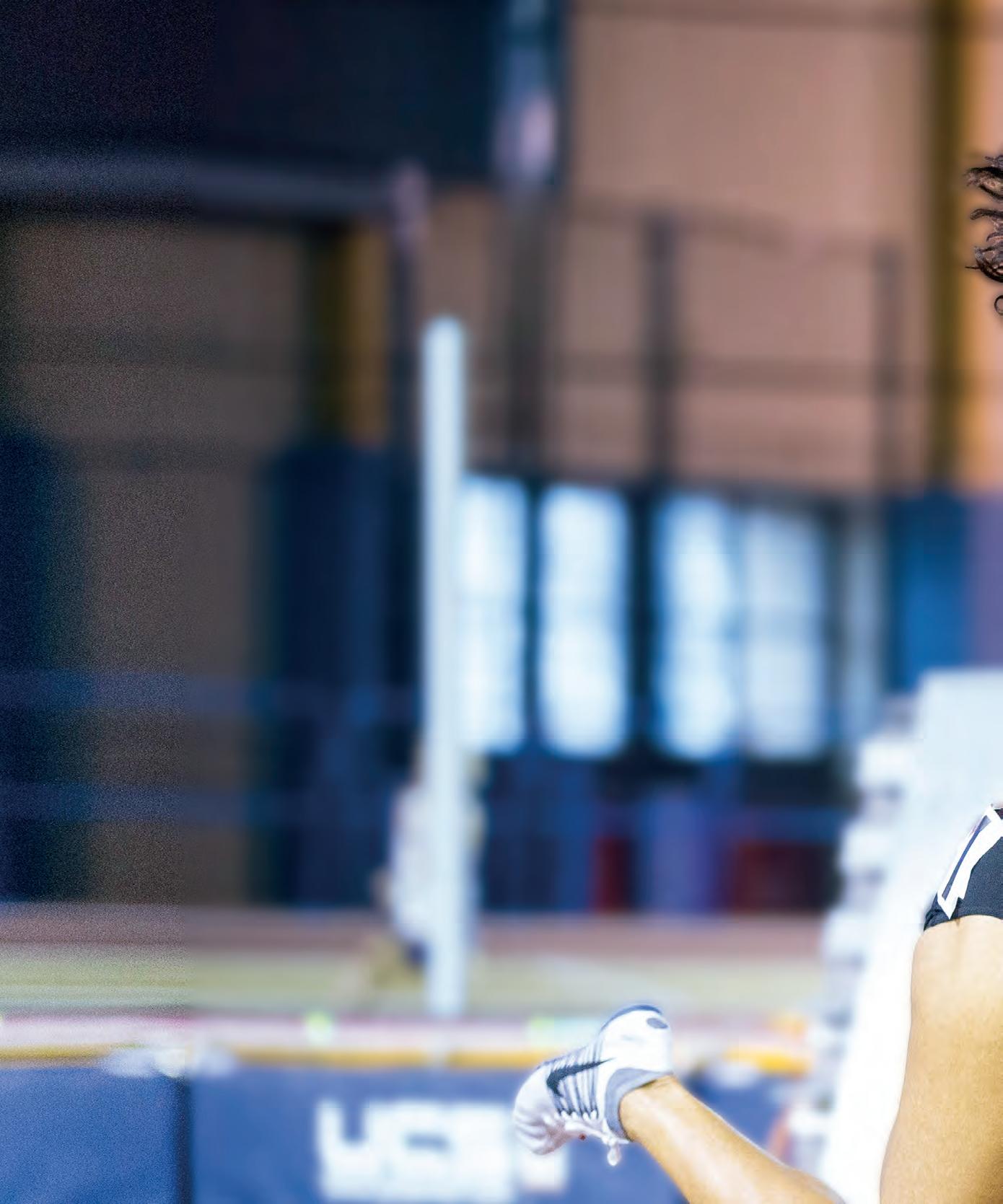
22
PHOTOGRAPHY BY WESLEY HITT
SPRING 2016
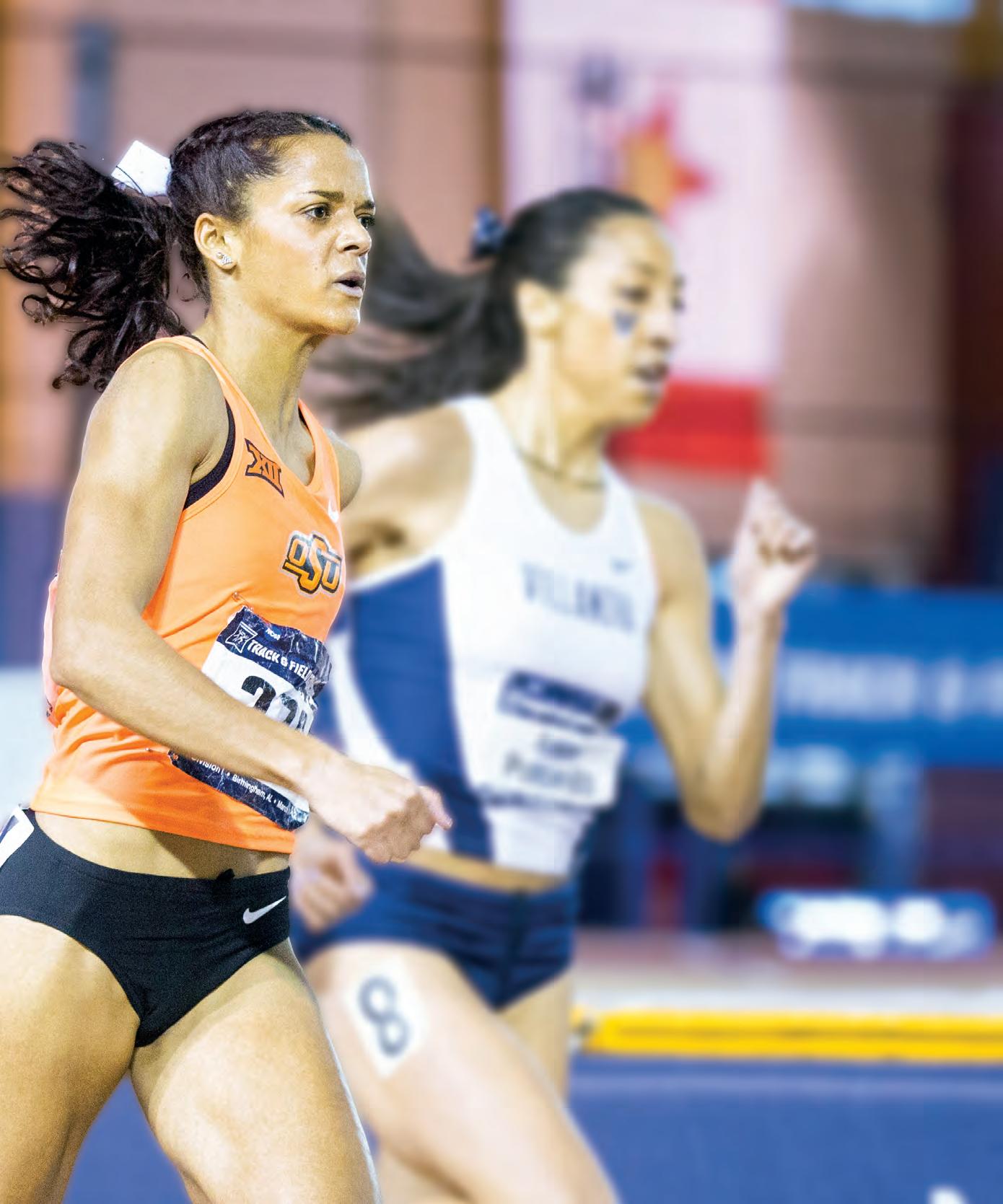
23









308 W. Franklin Lane, Stillwater, OK 74075 405-533-3333
P ISTOL PE TE’S PARTNERS
PISTOL PETE’S PARTNERS is the official OSU Athletic Kids Club designed to get kids excited about OSU athletics at a young age so that they are fans for life!

Annual kids club membership (8th grade and under) is just $25 per child.


Benefits include:
• FREE ADMISSION* to OSU wrestling, Cowboy basketball, Cowgirl basketball, baseball and softball
• Invites to autograph parties and special events
• Birthday card from Pistol Pete
• Special discounted tickets to Cowboy Football
• and much more!!
Membership Packets Include:
• T-shirt
• ID lanyard
• Picture of Pistol Pete
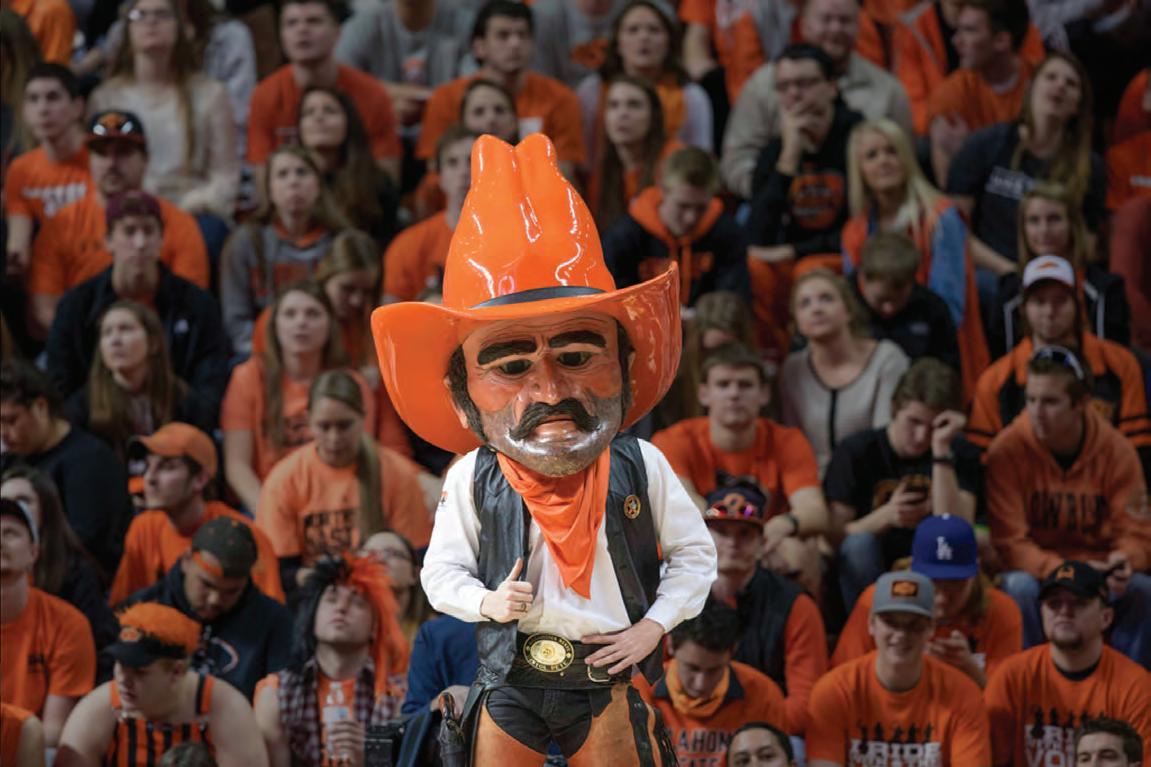
• Sports Schedules
For details, visit okstate.com/kidsclub
* Some restrictions may apply.
I’M WITH PETE
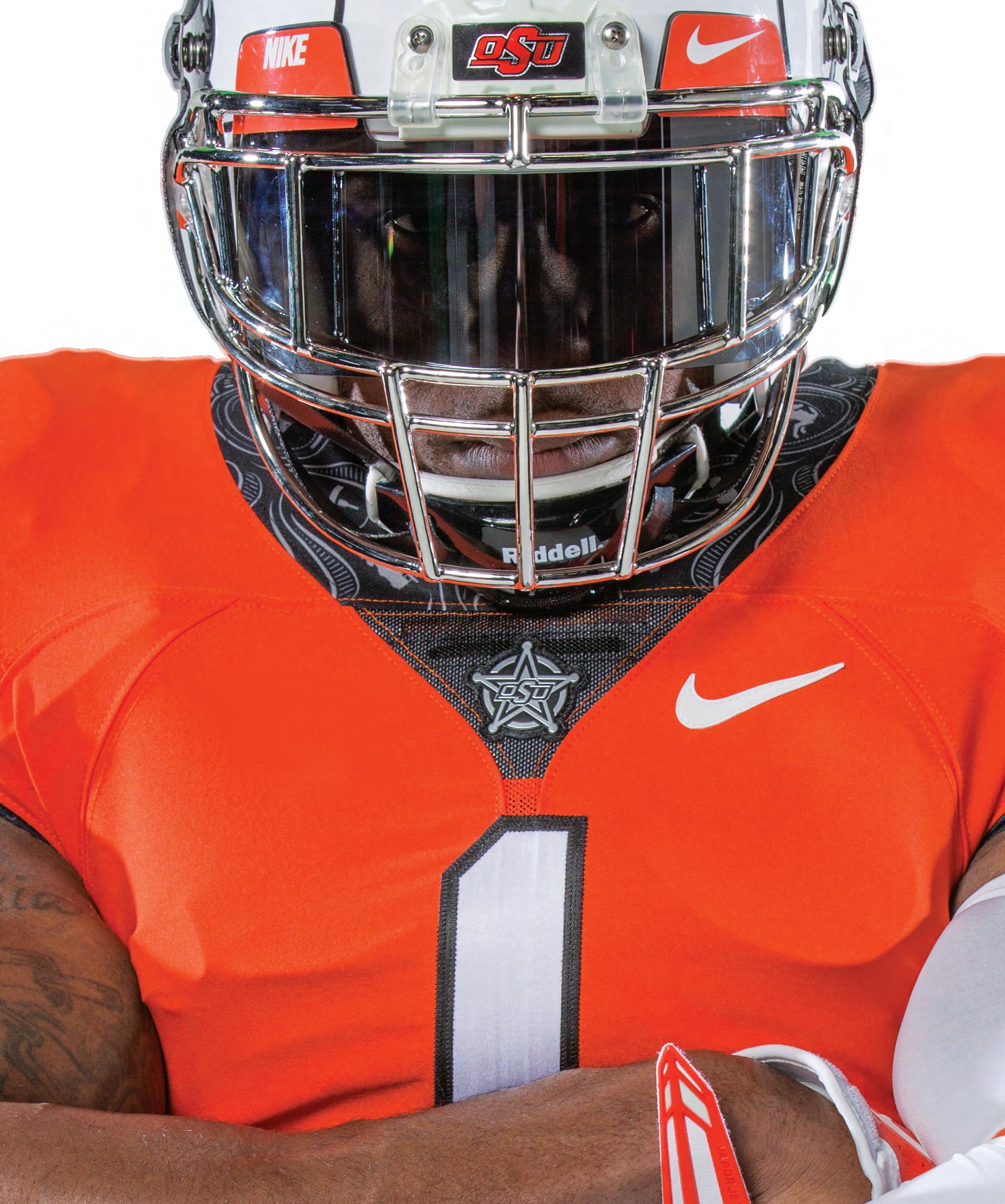
26 SPRING 2016
EYE BEHOLDER of the
An Edmond Santa Fe teacher played football recruiting insider on National Signing Day, offering a projected scoop on the high school’s star player, an uncommitted defensive enforcer named Calvin Bundage.
“I asked Calvin in class where he was going,” the teacher said, “and he told me, ‘where they have the best uniforms.’”
The teacher then smiled and said rather decisively: “I think he’s going to Oregon.”
Not so fast.
At decision point, BUNDAGE SNATCHED AN OKLAHOMA STATE HAT FROM A SELECTION OF FIVE SITUATED ON THE TABLE BEFORE HIM — including one for Oregon — and tugged it down tightly over his head, sending the Santa Fe gymnasium crowd into a frenzy and officially declaring himself a Cowboy.
Cut the teacher some slack, though. He wasn’t totally off base.
While Oregon may have started college football’s current uniform craze, OSU rocks the wardrobe, too. Bundage just went with the school Nike considers the other Oregon — the “Oregon of the Midwest,” with the Cowboys the closest thing to a rival for the Ducks in the business of uniform fun.
At a time when uniforms are capturing the kids, both young and old, OSU STANDS AT THE FOREFRONT OF CREATIVITY AND COOL, contributing heavily to an evolution of the Cowboys brand. And the game plan keeps offering audibles, with OSU football launching a rebranding in 2016 when Nike and the school hit the update button, rolling out fresh new uniforms for another round of oohs and ahhs and weekly anticipation for what’s next.
the 27
Through the collaborative efforts of Nike and OSU equipment maestros Matt Davis and Justin Williams , it’s going to be fun. And if you think the combinations and looks have been exhausted, Davis promises he’s got plenty of surprises still to come.
“Absolutely. That’s just what we’re going to do,” said Davis, OSU’s director of football equipment operations. “The show this next year is going to be the uniforms. We’ll still throw out some different helmets, but the uniforms are going to be the centerpiece because they’re new.”
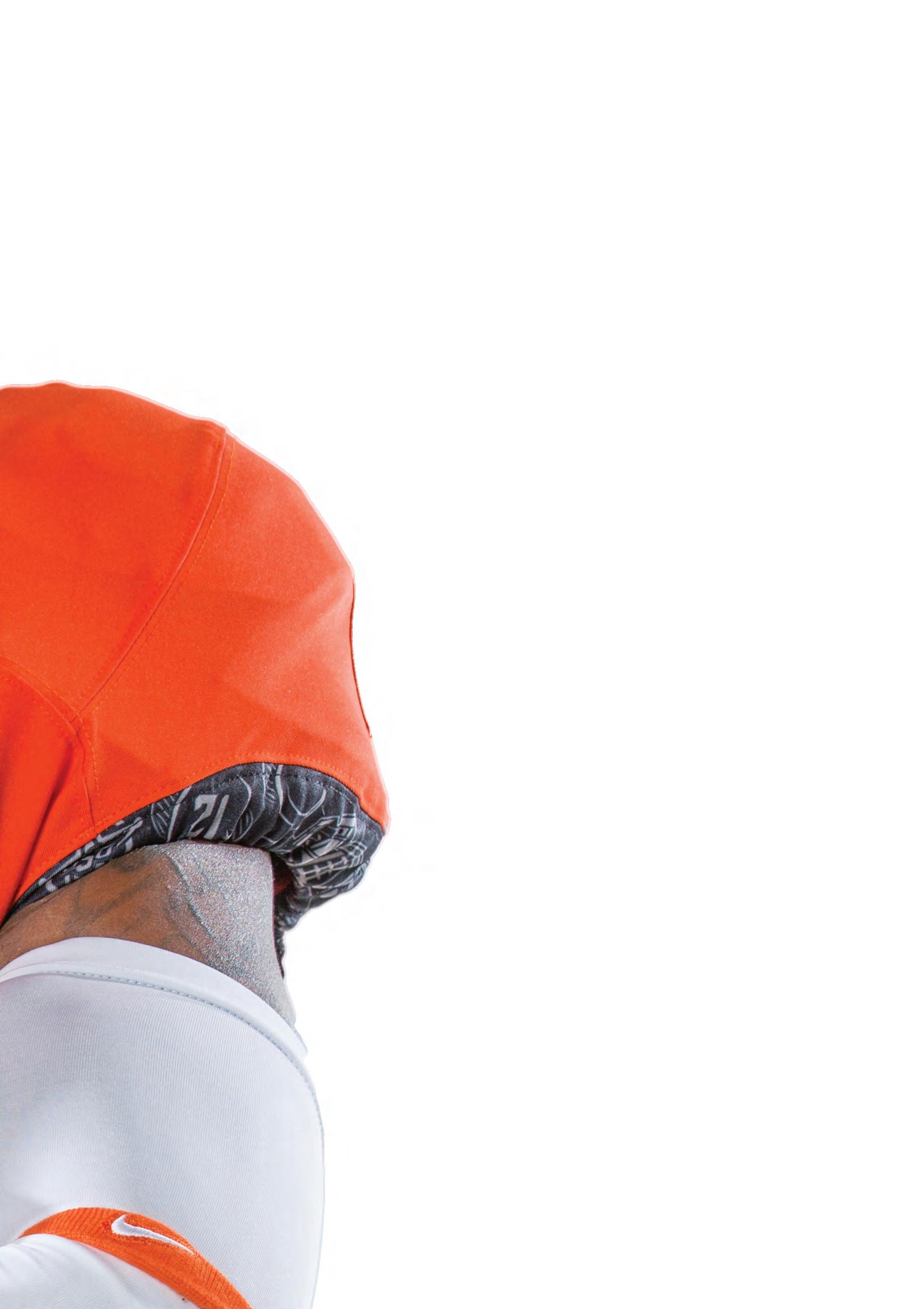 PHOTOS BY BRUCE WATERFIELD
STORY BY JOHN HELSLEY
PHOTOS BY BRUCE WATERFIELD
STORY BY JOHN HELSLEY
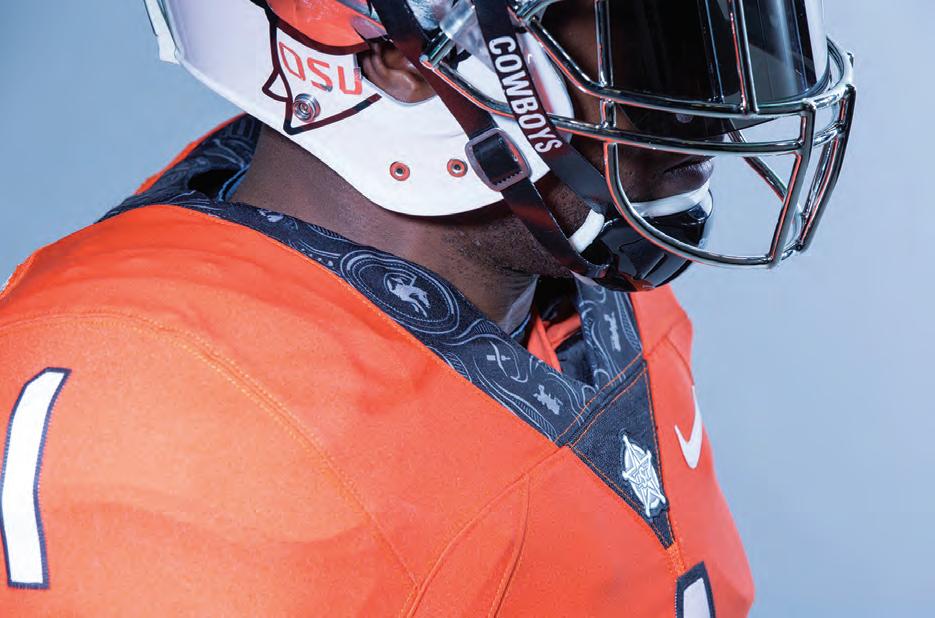

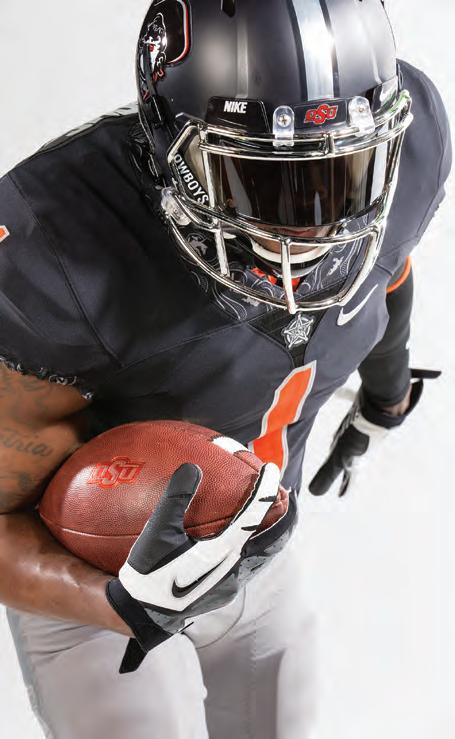
28 SPRING 2016
GAME CHANGER
Once upon a time, OSU’s uniform history was mostly forgettable.

The school even changed shades of orange at one point, moving away from burnt orange to a hue that’s now part of the university’s “America’s Brightest Orange” campaign.
Today, however, the school is making history and memories with its uniforms. Yes, it’s about football. But it’s about marketing and branding OSU, too. Whenever the Cowboys play on FOX or ESPN or any network, it’s an opportunity to sell the school.
And we all know, it’s important to look good.
“I think it’s made it brighter,” said Kyle Wray, OSU’s vice president for enrollment management and marketing. “It’s made it more visible. That’s the
key. When you talk about branding, a big component is visibility. There’s a brand equity. The uniforms and how we’ve used those and rolled them out has certainly enhanced the brand.
“I’m in enrollment and marketing. And those two things go hand in hand. Those students from Jenks and Union and the Edmond schools, Putnam City, all the places that are feeder schools to this institution from a general student body standpoint, that’s still a lot of buzz for them and what they want to wear.”
From forgettable to memorable, OSU has truly spun a negative into a positive.
Without the kind of “traditional” uniform that locks teams and schools into a specific and expected look, the Cowboys have used variety and creativity to raise its uniform game. And they’ve elevated their look among the elite.
“We didn’t have that kind of tradition some schools had,” Wray said. “What we had was innovation and creativity. That’s one of the reasons we decided to go the direction we did.”
The curiosity — “What are the Cowboys wearing this week?” — has become a hot topic among players, fans, recruits and media. And the combinations, always different in some way, always seem to satisfy.
What the Cowboys are wearing is important. To those players and fans. And to recruits, too.
If you think otherwise, consider Bundage, who weighed uniforms into his decision, along with all the other prospects across the country who have proclaimed a team’s threads as part of their decision-making process.
“I know the young people like it, they’re excited about it,” said Cowboys coach Mike Gundy “The recruits bring it up and talk about it. It’s important to them.”
29
OSU AND NIKE: A HAPPY MARRIAGE
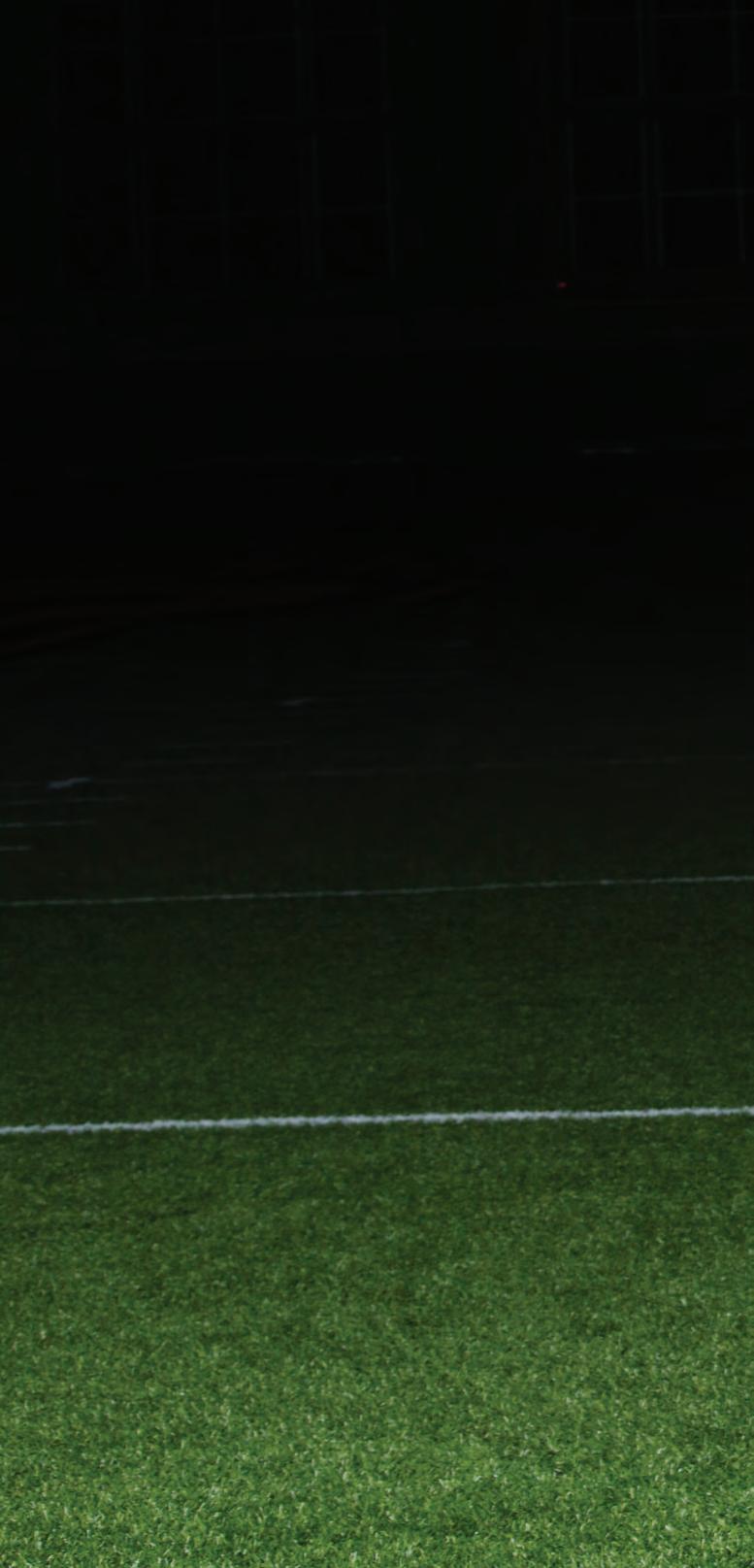
Oregon had already shaken up the uniform game, going with varying looks and themes and colors, all provided by Nike and its czar Phil Knight , an Oregon grad, when Wray and athletic director Mike Holder flew to Beaverton, Ore., for a meeting with officials of the equipment and sporting goods giant.
At the time, the Cowboy football uniform rotation was simple: orange at home, white on the road, with one white helmet bearing the old cattle brand OSU on each side.
That’s when Wray and Holder pitched their idea to be the “OREGON OF THE MIDWEST.”
Nike bought in. And soon a design team was on its way to Stillwater for a fact-finding mission aimed at discovering the fabric of the school’s history and traditions and how they relate to athletics. Nike also consulted a few select players, quarterback Brandon Weeden among them, seeking a feel for where to go.
“They said, ‘When you think about uniforms, what do you want?’” Wray recalled. “And they said, ‘We want it to be like when Friday night rolls around and we get to go out and have fun with our friends, we want to go to our closet and open it up and say, ‘What do we get to wear?’ ‘What are our neat options?’”
Options they got.
Options and combinations: 65 different combos to date, when it comes to mixing in something new, including socks, since the Cowboys first broke out their Nike multiuniform partnership in 2011. And both sides are enjoying the partnership, with benefits going each way.
30
SPRING 2016

“WE DON’T WANT TO BE STUCK IN THE PAST OR LOOKING IN THE REARVIEW MIRROR. WE’RE LOOKING OUT OF THE WINDSHIELD.”
31
KYLE WRAY OSU VP FOR ENROLLMENT MANAGEMENT & MARKETING
THE BREAKDOWN
• Included on the trim of every jersey is a custom paisley print inspired by a cowboy’s bandana. The pattern pays homage to OSU’s history. Icons include Pistol Pete, the Spirit Rider and Bullet, Paddle People, OSU football’s legendary jersey numbers (21 for Barry Sanders, 34 for Thurman Thomas, 43 for Terry Miller and 55 for Bob Fenimore), trophies and a train reminiscent of OSU’s “Tombstone” team entrance.
• The jerseys include a marshal badge just above the numbers. The badge is a proud reminder of Frank Eaton, the original Pistol Pete, and his service as a U.S. deputy marshal.
• All lettering features a new barbed wire typeface that serves as a reminder of the cowboys who drove their herds across Oklahoma.
• Pants are adorned with the Shadow Pete logo. The word “COWBOYS” appears on both legs of the pants and is stitched on using a reflective fabric that provides an ultra-modern edge to the uniforms. The same reflective fabric is used behind the numbers on the black jerseys.
• OSU’s new uniforms are built using Nike Mach Speed technology, designed to maximize speed, ventilation and comfort. The fabric is 25 percent lighter than previous uniforms. The fabric features an articulated fit to match the athlete’s motion of play, allowing athletes to move with the uniform fabrics, rather than against them.
SO, WHAT’S NEXT?
The weekly question of every season has now been answered with OSU’s unveiling in March.
The basic uniform the Cowboys are adopting, Nike’s Mach Speed, is in place at a few schools now. The look, which features trampoline mesh down the neck and the sides of the pants, first debuted in the national title game two years ago, when Oregon and Ohio State both wore them.

In 2016, the Cowboys will feature three jerseys and four pants in a product that offers added comfort as well as a refreshed look.
“Our uniforms were already skin tight and sleek, with no loose stuff to grab,” Davis said. “But I think our guys will be able to see the difference in breathability. Rather than typical mesh, it’s a trampoline mesh. That’s where they get the reduced weight. It’s breathable. It’s seethrough, like a trampoline.”
Beyond the materials, that’s where the creativity comes in, with the details, like the color scheme and the placement of Pistol Pete and other items of interest.
Expect more fun. Much more fun, with Davis and Williams long at work on upping the ante on the updated look.
“We’re not Texas,” Davis said. “They can keep the same logo all the time. To me, we have a blank canvas. These recruits, half of them, don’t know who BARRY SWITZER is anymore. But they say, ‘DANG, OSU HAS THAT SHINY ORANGE HELMET.’
“It’s about winning, but these kids are also about what they get. ‘I get a new-looking helmet every week?’ We’re just trying to keep up in the arms race. There’s a ton of satisfaction when it’s all said and done.”
Davis and Williams are invested, too. They’re both OSU graduates, and they stuck around, with Davis in his 20th year working with the Cowboys and Williams in his 15th.
“So you’ve got two graduates who say, ‘We can’t dress ourselves, but we can dress others,’” Davis said with a laugh. “It’s fun when we get to sit down in April and try to design helmet looks for the next year, ordering decals. It’s really fun spitballing ideas.”
Davis has taken a special interest in offering something special for Homecoming, with a throwback nod through the helmets. The uniform combinations are limited to what’s on hand, but Davis and Williams have flexibility with the helmets. So they brought back the bucking bronco rider for
32
SPRING 2016
2014, followed by a 1960s-themed stacked OSU this past season.
There are a lot of people sitting in those stands who I want to honor at Homecoming,” Davis said. “I want them to think, ‘When I was here, that’s what we wore.’ I want to make that Saturday unique.”
In every way, Cowboys uniforms have become unique , from week to week and year to year. And it’s bled over to other sports, too, with coaches wanting in on the fun.
And here they go again, with football leading the way.
“It’s about the future,” Wray said. “It’s about appealing to prospective students and parents and supporters of Oklahoma State, and of course recruits in football. WE
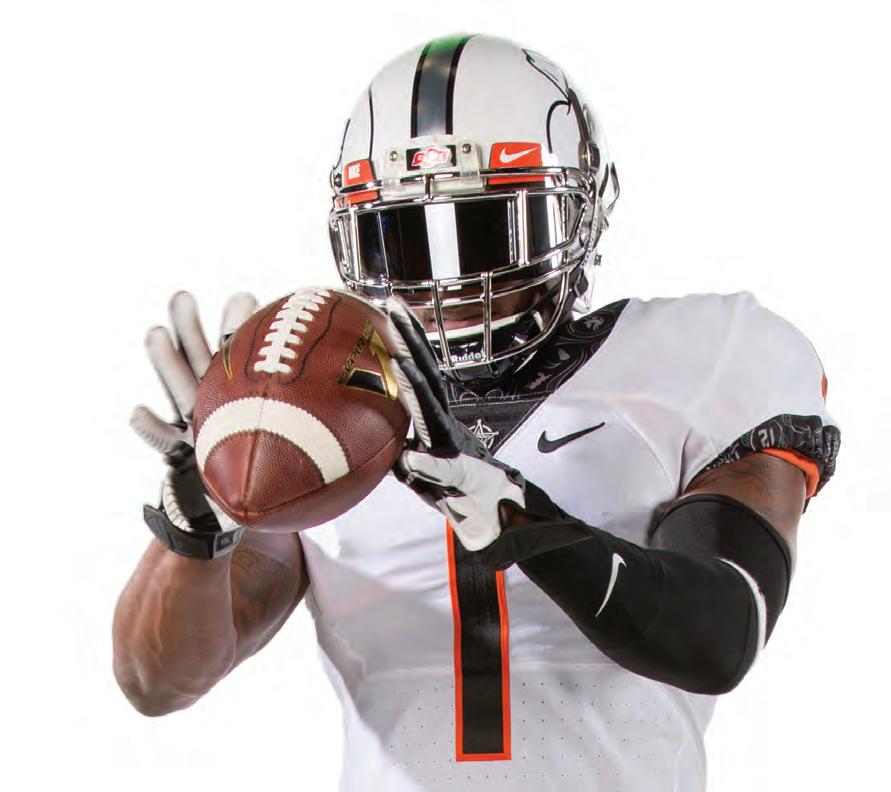
WANT TO BE ON THE CUTTING EDGE.
“And it’s been a blast. You see a young kid walking up the sidewalk on game day in his jersey or helmet, that’s something 10 years ago they wouldn’t have had an opportunity to do. That’s what it’s all about. It’s about branding Oklahoma State University.
“We want to be creative and innovative. We don’t want to be stuck in the past or looking in the rearview mirror. We’re looking out of the windshield.”
“IT’S ABOUT BRANDING OKLAHOMA STATE UNIVERSITY.”
KYLE WRAY
33
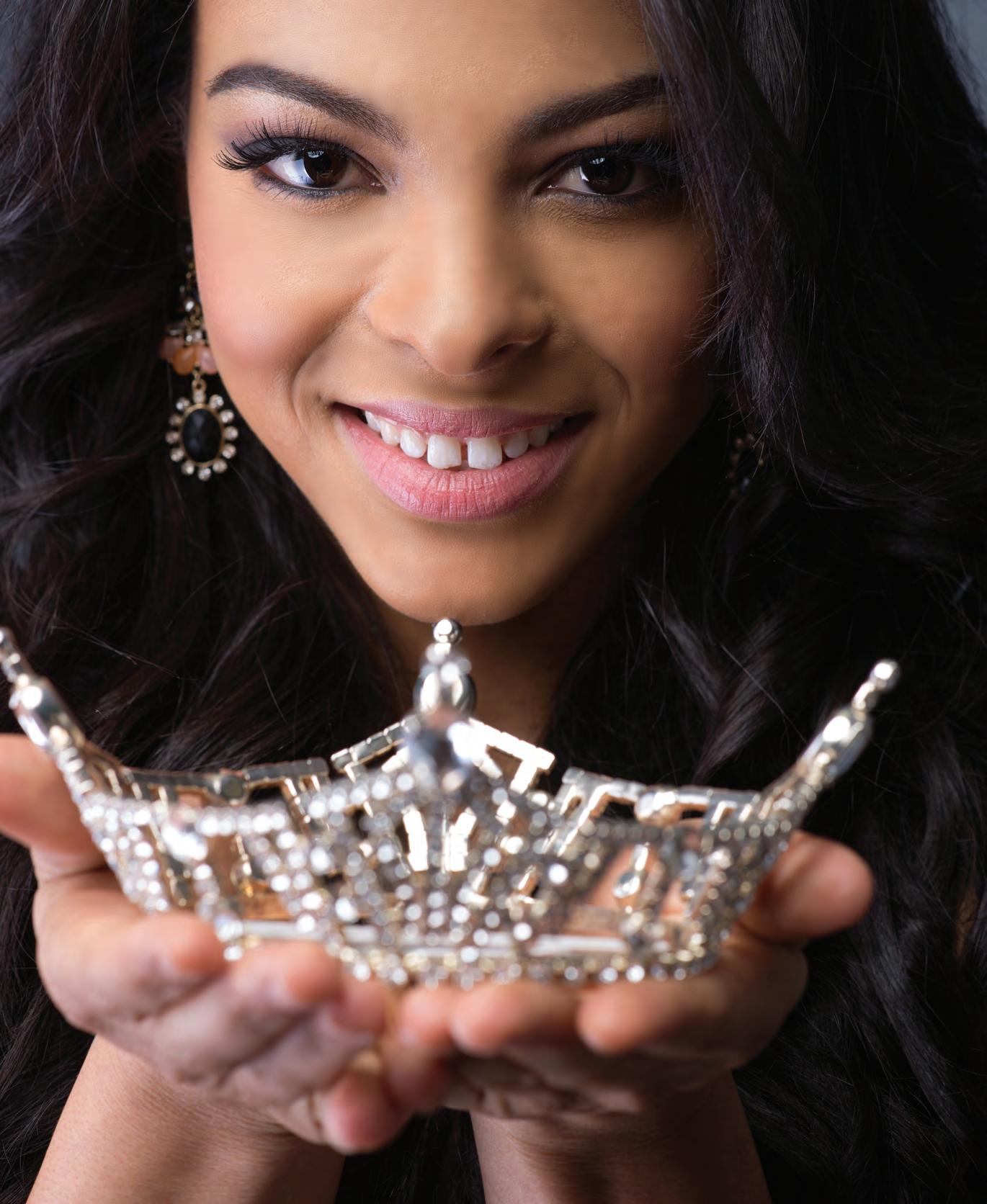
34
PHOTO / KEVIN CAMP / STUDIO C1, TULSA SPRING 2016
Tiaras
STORY BY CLAY BILLMAN
Triana Browne-Hearrell is all of the above … and more.
The native Tulsan claimed her crown at the 2016 Miss OSU Scholarship Pageant last fall. Her year-long reign will include a chance to vie for the Miss Oklahoma title in June.
The daughter of former Oklahoma State track standouts, Dr. Monica Browne and Joel Hearrell , she grew up in a running household, bleeding orange.
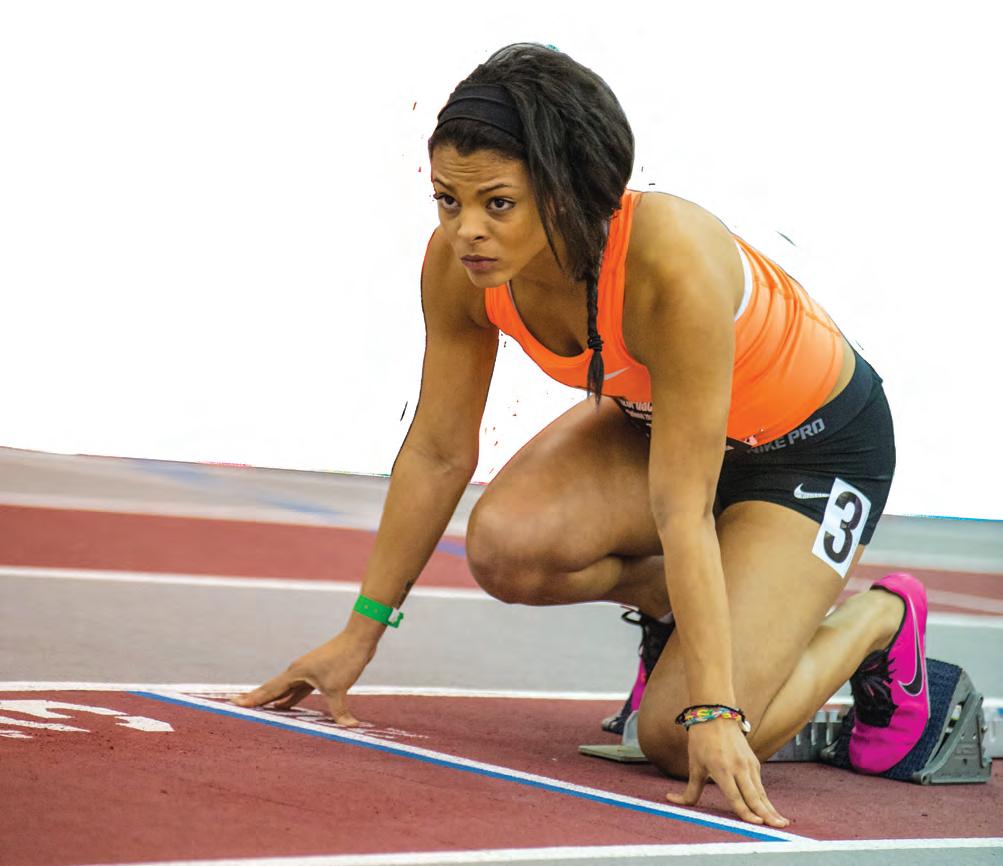
“EVER SINCE I WAS LITTLE I WANTED TO GO TO OSU AND RUN HERE,” she says. It almost didn’t happen.
Browne-Hearrell’s family relocated to Peachtree City, Ga., prior to her freshman year of high school.
A standout sprinter at Starr’s Mill High School, Browne-Hearrell committed to run track for a nearby university in Georgia, along with a number of her track and field teammates. But even as she signed the scholarship papers, her heart was back in Oklahoma.
“IT JUST DIDN’T FEEL RIGHT,” she recalls. “I signed (the NCAA letter of intent) and got home immediately from faxing it at the library and told my mom, ‘THIS ISN’T RIGHT. I WANT TO GO TO OSU.’
“I ended up coming to Oklahoma State. I WASN’T PLANNING ON RUNNING ORIGINALLY. I JUST CAME HERE AS A NORMAL STUDENT.”
That didn’t feel right, either.
35
PHOTO / CLAY BILLMAN
At a high school meet, Browne-Hearrell had befriended fellow Georgian Kirubel Erassa , an eventual SEVEN-TIME ALLAMERICAN FOR THE COWBOYS. The pair kept in touch, and it led to an introduction to Dave Smith , OSU’s director of track and field and cross country. Smith invited the freshman to walk-on, and by the spring of 2013, Browne-Hearrell was back on the track.
At the start of her sophomore year, Smith hired a dedicated coach, Diego Flaquer, to work specifically with the sprinters.
“Quite honestly, I’ve gone through a lot of coaches just being at different schools, and DIEGO IS THE BEST COACH I’VE EVER HAD,” says Browne-Hearrell. “HE KNOWS HOW TO CONNECT WITH THE ATHLETES really well and knows what’s best for you when it comes to training. He doesn’t just throw you out there and expect you to do something. HE HELPS YOU UNDERSTAND WHAT’S GOING ON WHENEVER YOU’RE WORKING OUT. He talks about techniques and the fundamentals of what you’re doing and how you can improve upon it … The next
thing you know, you’re dropping time and you don’t even know how, you’re just doing what he says.”
Under Flaquer’s tutelage, Browne-Hearrell began to set new personal bests, in the 400 (56.48) and 400 meter hurdles (1:04.87).
“That first year I was running slow 400s,” she admits. “Within half a year I dropped four seconds off my time, which my parents couldn’t believe.”
“TRIANA HAS BEEN AN EXTREMELY HARD WORKER,” Flaquer says. “We’ve had our ups and downs with injuries, but our goal this year is for her to finish on the highest note possible. Triana is a fighter, once she sets her mind to something. As I tell my kids, you have to let your choices lead you, and the feelings will follow.”
“Diego always told me, ‘Do not be afraid to step into the unknown.’ I use that quote for everything now. That’s what our coach has instilled in us, to not be afraid of what you’re capable of. Step out of your comfort zone. With track, you go through so many mental battles. That’s why I think everybody on the team is doing so well right now, because not only does he connect with you mentally, but physically he gets you to understand your own body and push it to a whole other level.”
Her junior year, Browne-Hearrell struggled with injuries common to track athletes (especially her own flesh and blood).
“I’m just like my dad,” she says. “Always injured. I’ve found that I’m a really tough girl who will push through injuries and will not let them heal. Basically, it started with one injury and not fully taking care of it, thinking that I was ready to come back, and it just led to the next thing. By that time it was just like a domino effect. And that just comes from my dad. MY MOM WAS NEVER INJURED, BUT MY DAD HAD A CAREER ENDING INJURY, because he did the same thing as me.”
Unlike running, the role of “PAGEANT QUEEN” wasn’t something that BrowneHearrell aspired to, she says. IT WAS AN OPPORTUNITY LITERALLY TO PAY THE BILLS.

36
Triana Browne-Hearrell:
PHOTO / HUNTER HUTCHENS SPRING 2016
(Coach Flaquer) always told me, ‘Do not be afraid to step into the unknown.’
Along with the crown, first prize in the Miss OSU Scholarship Pageant is $1,200. The first runner-up is awarded $600.
“I saw an ad for Miss OSU and saw how much you could win for each place,” she recalls. “I decided to try it, because, quite honestly, I wanted to help my mom pay for my school. As a student-athlete you only have so much time to work. I understand how much money goes into going to school, and I WANT TO DO EVERYTHING I CAN TO HELP MY MOM. She’s done so much for me. I THOUGHT MISS OSU WOULD BE A GREAT OPPORTUNITY.”
Browne-Hearrell had only been in one previous “Miss” pageant, as a high school freshman.
“One of my teachers suggested I try it,” she says. “It was an amazing experience, but I didn’t do very well because I didn’t know what I was doing.”
Five years later, she felt like a rookie once again.
“My mom said, ‘If you can find some dresses, go ahead. Have fun with it.’ I ended up getting first runner-up. I got to give my mom that $600 on her birthday.
“I didn’t try any other pageants after that because of track. I was going through the injury, and mentally I was just so distraught. I was just trying to figure out how to get back to running.”
At the start of her senior year, BrowneHearrell’s rehab was progressing well. The human development and family science major was focused on school and being a competitive athlete again, not on chasing a crown. But as the pageant deadline neared, she was encouraged to give it another shot.
However, a few hurdles stood in her way.
“I didn’t have any dresses,” she says. “I contacted multiple people, including the girl who lent me the dresses the year before, with no luck. The date was coming up so quickly that I had put in my head that it’s just not meant to be.”
Pageant officials urged Browne-Hearrell to attend rehearsals at the very least, in the event her situation changed. She practiced HER TALENT SINGING just in case.
“A part of me was just like, I’m done. It’s not going to work out. The pageant was the next night. We did the run-through for the opening number, and a girl came up to me and said, ‘Are you saying that you can’t find dresses?’
Samantha Martin , a freshman from Oklahoma City, offered BrowneHearrell a closet full of dresses from prom and a number of past pageants.
“She said, ‘I don’t know if you’ll like them, but at least you can compete.’”
Along with the aforementioned evening wear, Miss OSU contestants are judged on a pre-show interview, physical fitness in swimsuit, onstage question-and-answer, talent and evening wear.
Martin was named first runner-up, while the competitor who borrowed from her wardrobe took the crown.
“She was excited for me. That’s the type of person who should be winning pageants,” Browne-Hearrell says. “Samantha just recently won MISS GREEN COUNTRY, so she will be in the Miss Oklahoma pageant with me. She’s extremely intelligent. Gorgeous girl. She has a bright future ahead of her. She’s going to do well in Miss Oklahoma, and I’m glad to say that, because she’s a great person.”
As Miss OSU, Browne-Hearrell keeps a busy schedule, making appearances on campus, as well as speaking at schools and events statewide. Meanwhile, she’s earned Academic All-Big 12 honors in the classroom.
“What’s great about having the title is that you can be as busy as you want to be, and I’ve made it imperative that I’m extremely busy,” she says. “COMMUNITY SERVICE IS JUST PART OF WHO I AM AS A PERSON, but this takes it a step further by having a title behind it. I’m much more capable of reaching out to people as Miss OSU.
“I’m just trying to be who I am as a person, show my true character, because this is a school I’ve always wanted to go to. And I’ve been able to represent it as
an athlete and as a student, but I wanted to find my purpose within that. I feel like I’ve found it.”
Browne-Hearrell’s message combines her athletic background and passion for healthy lifestyles.
“MY PLATFORM IS CALLED ‘HEART TO HEART: HEALTHY HABITS, HEALTHY LIVES’ … It’s a passion of mine to be healthy. You should take care of your body. You only have one life, so you want to be here as long as you possibly can and reach your fullest potential. You want to be able to go through every day with energy.
“TO BE HEALTHY DOESN’T MEAN YOU HAVE TO EAT LEAVES. You really can enjoy it. For me, as someone who loves flavor, seasonings and stuff, it’s been finding ways to make food delicious. Or finding ways to get kids to enjoy actually working out.”
This spring, Browne-Hearrell’s own workouts are focused on the outdoor track and field season, where she will compete in the pentathlon.
“THIS IS MY LAST YEAR TO RUN,” she says. “My career ends after this, and I’VE BEEN RUNNING SINCE I WAS SEVEN, SO IT’S NOW OR NEVER. I want to do well in this last year and end on a good note, so I’m just really focusing on eating right, training as hard as I can, training smart, and then hopefully by the time outdoor season gets here I’ll be where I want to be.
“I’m wanting to do something this season that I’ve never done before,” she adds. “The year before it was a matter of stepping into the unknown. Well, I’ve done that. I’m used to that now. It’s a matter of taking it a step further. I’M WANTING TO SURPRISE A FEW PEOPLE, TO MAKE THIS A VERY EVENTFUL YEAR — A VERY IMPACTFUL YEAR.”
She already has.
37
TOP OF HIS CLASS
COWBOY Dean Heil WENT 32-1 during his sophomore season on the mat, WRESTLING AT 141 POUNDS. After earning his SECOND BIG 12 CONFERENCE TITLE, the top-seed cruised through the NCAA Championship bracket under the lights at New York City’s Madison Square Garden.
In the finals, HEIL HELD OFF NO. 14-SEED Bryce Meredith of Wyoming in a thrilling 4-3 DECISION to become OSU’S 140TH INDIVIDUAL CHAMPION.
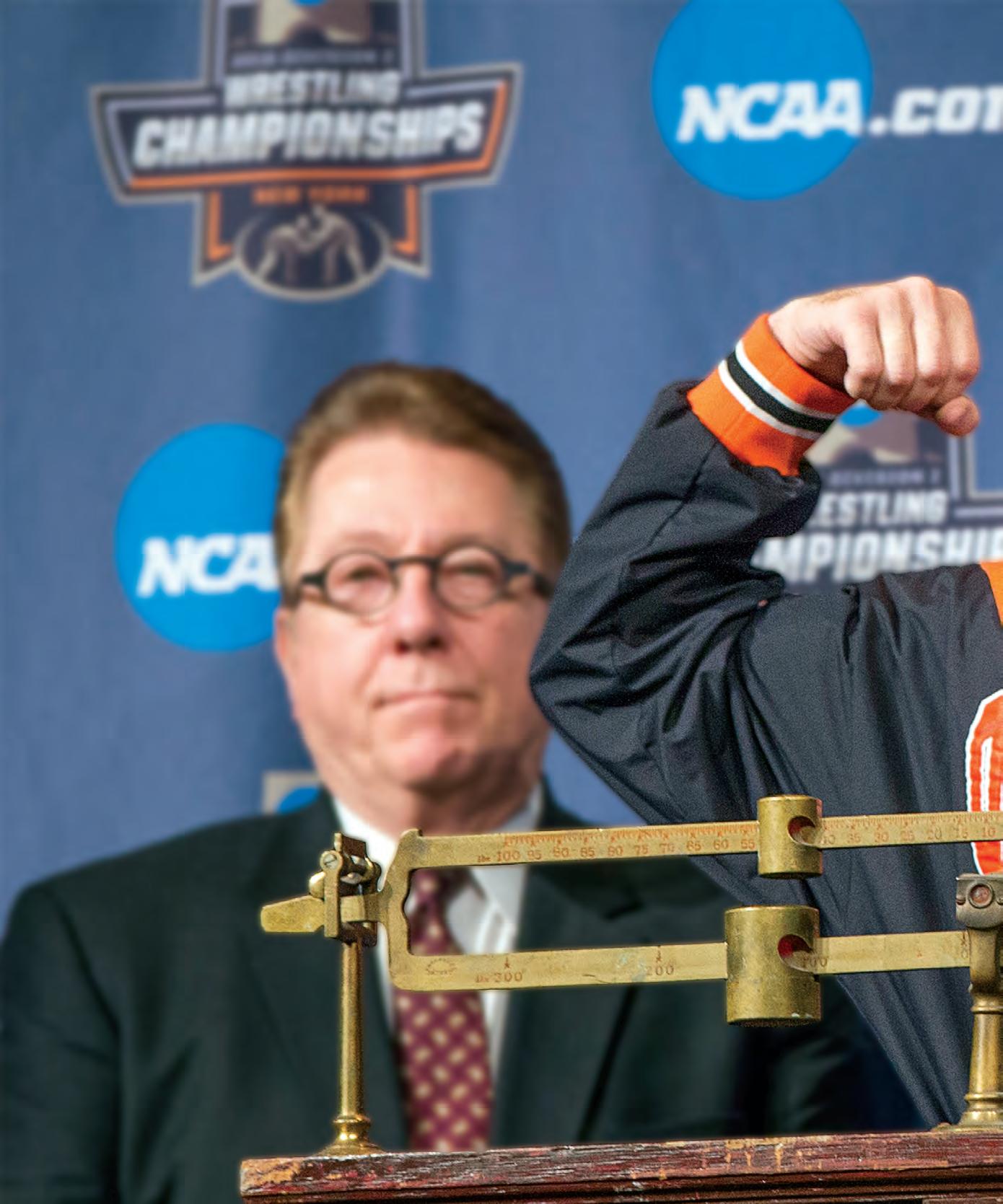
38
SPRING 2016
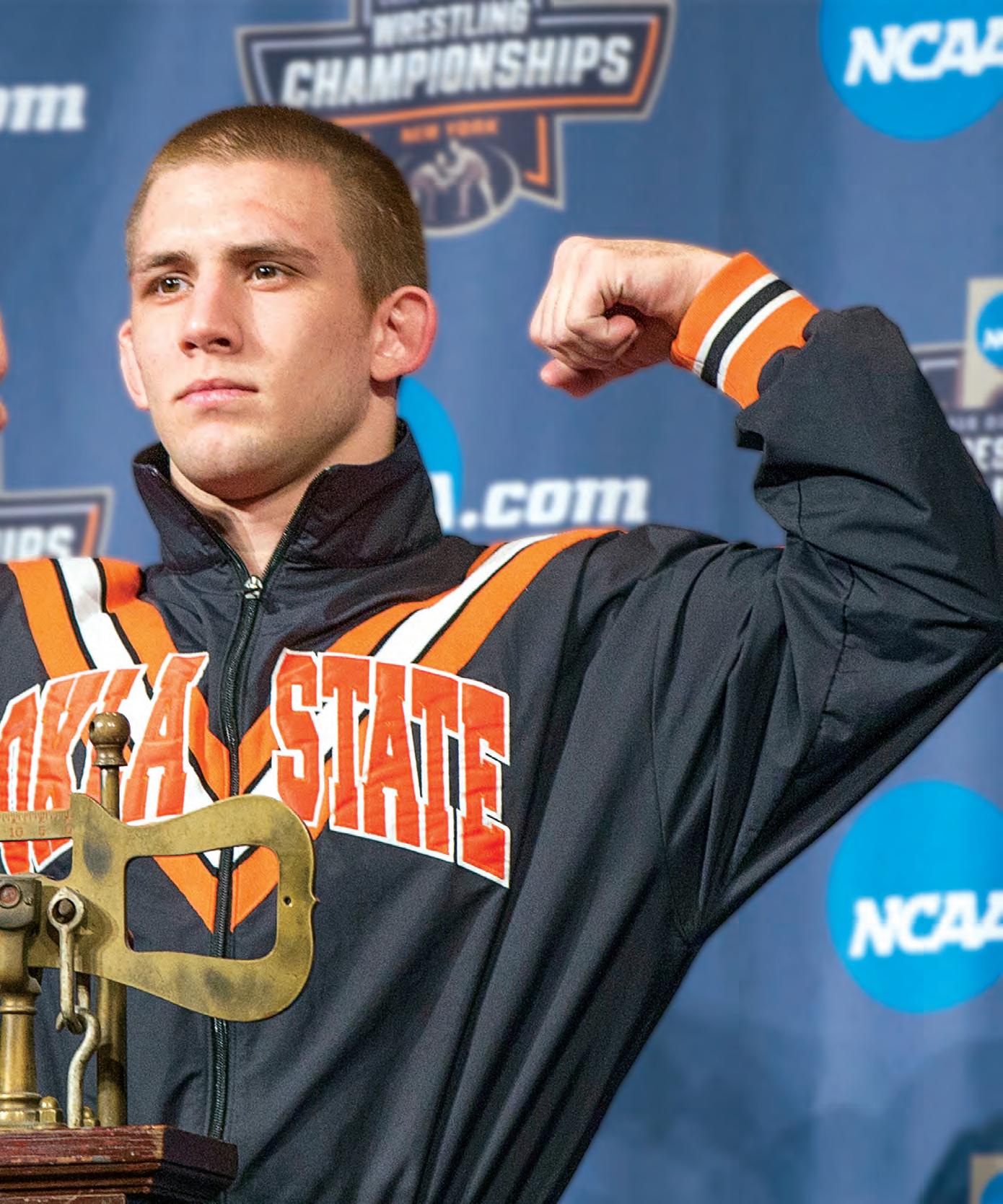
39
PHOTOGRAPHY BY BRUCE WATERFIELD

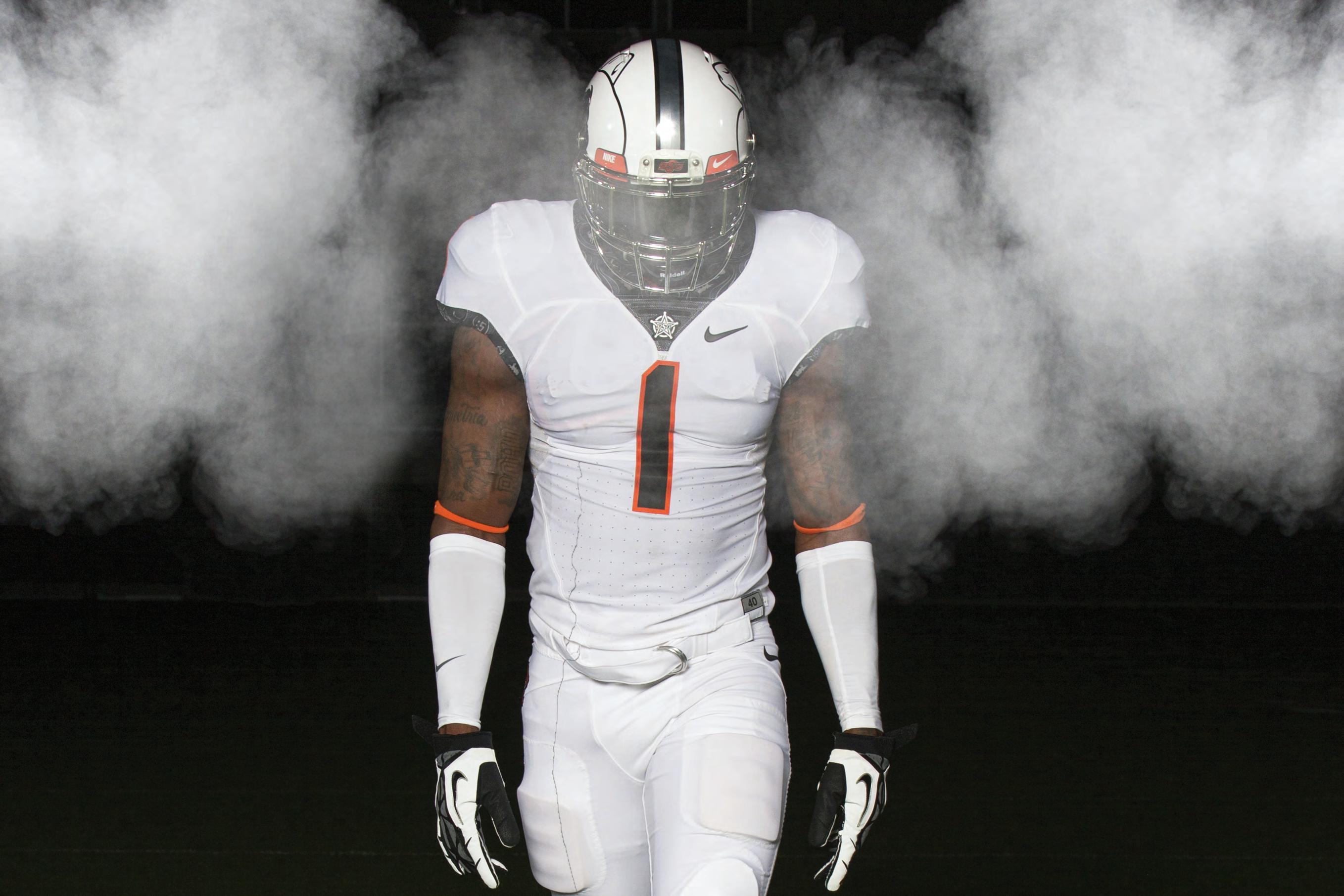






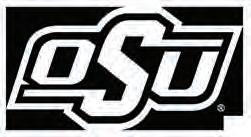
877-ALL-4-OSU okstate.com BUY TODAY!
The

IN THE WORLD
OF SPORTS, none mimics real life more than GOLF with its peaks and valleys, constant tests of character and vast array of teaching moments. Nobody understands that more than Oklahoma State’s WYNDHAM CLARK.
42
STORY BY RYAN CAMERON
PHOTOGRAPHY BY BRUCE WATERFIELD
SPRING 2016
PHOTOS / THE CLARK FAMILY
AHEAD
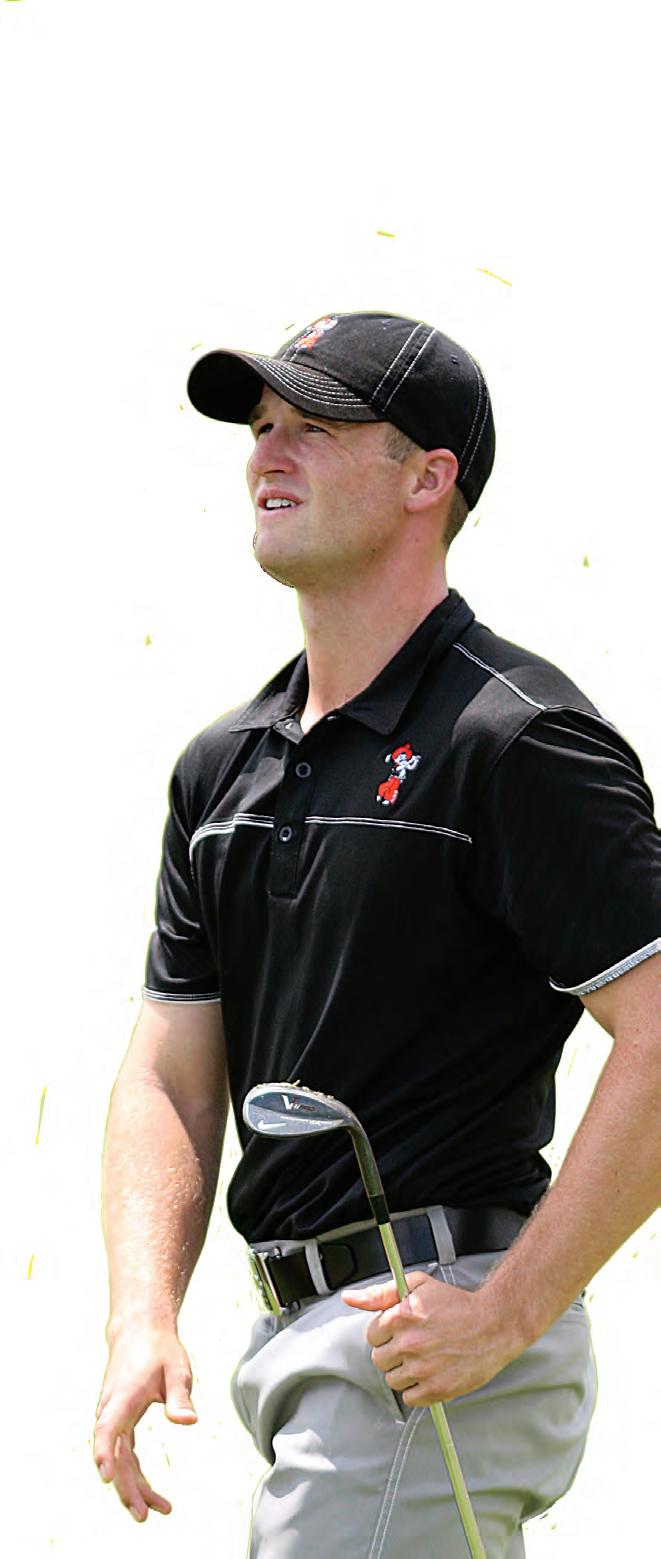
The Denver native arrived in Stillwater during the fall of 2012 with lofty promise and poised to add his name to a long line of successful Cowboys. However, life had a different plan in mind and derailed his rookie campaign.

43
In December of that year, Clark’s mother, LISE , discovered she had once again fallen ill — 14 years after having recovered from stage-three breast cancer. The disease returned with a vengeance.
“They didn’t know she had the BRCA1 gene where it is in the DNA. So it came back,” Clark said. “It came back probably four, five, six years ago, but they didn’t see it because it wasn’t where it was before. It was so big by the time they found it they couldn’t do anything about it.”
With the freshman’s world turned upside down, then-OSU head coach Mike McGraw decided

However, on the counsel of those close to him, Clark would soon realize time away from the game was the appropriate course of action for multiple reasons. Not only would his golf game be a beneficiary of time spent away, his personal life would blossom as well.
“They kept telling me this is part of God’s plan and this is what you need more than to go to tournaments and play good golf.
I STARTED TO HANG OUT WITH PEOPLE OUTSIDE OF THE GOLF TEAM and got integrated into the school. I met tons of people AND STARTED HAVING FUN,” Clark said.
TIME AWAY FROM THE GAME WOULD BEST SUIT CLARK,
a decision that was not easy for either side with Clark losing the game he loved and McGraw removing considerable firepower from the OSU lineup.
“WHEN COACH TOLD ME THAT IT KIND OF BROKE ME FOR A LITTLE BIT. For about a week I was so down because I felt things couldn’t get any worse,” Clark said.
“A lot of people on the outside looking in, and Coach McGraw would say this, I was playing really good golf that spring he made me redshirt. I was winning (team) qualifying and one round I shot 64 out here (Karsten Creek), and the wind was blowing like 15 miles per hour.”
Despite playing at a high level, golf did not provide a healthy outlet to get away from the reality facing Clark and his family. Instead, golf served as a fuse directly into Clark’s powder keg of emotions.
“I would hit a bad tee shot, then I would just go and lose it. It had nothing really to do with my golf, it is just where my anger came out. It was really hard because I was here for golf and GOLF BECAME THE PLACE I DIDN’T EVEN WANT TO BE BECAUSE I WOULD LASH OUT. I STARTED RESENTING THE GAME AND DIDN’T WANT TO PLAY,” Clark explained.
“I WAS JUST A COLLEGE STUDENT AND A KID INSTEAD OF SOMEONE HERE TO PLAY GOLF. THAT WAS A HUGE TURNING POINT.”

Reflecting on McGraw’s decision to shut his season down proved the easy option is not always the proper one, and
“THAT REDSHIRT WAS THE BIGGEST BLESSING IN DISGUISE FOR ME . It was huge because I didn’t really want to do it, and IT WAS A HIT TO MY EGO because I thought guys who redshirt aren’t good players and aren’t ready to play,” Clark said. “Really, IT WAS A CHANCE TO GET AWAY FROM GOLF and have it not be No. 1 and have it not be important. As spring came around, I started to finally at least enjoy school and not have those outbursts because I was a lot more level with my emotions.”
THE CHOICE TO TAKE THE ROAD LESS TRAVELED PROVED THE RIGHT DECISION
for Clark and quite possibly salvaged his promising career as a Cowboy.
“McGraw was the biggest part. If it would have been any other coach, no knock on them, I don’t think I would have been at the school anymore because they would have kicked me off the team,” Clark said. “I acted out in some ways that you shouldn’t act out.
I WAS NOT ENJOYABLE TO BE AROUND. HE IS PART OF THE REASON I AM HERE TODAY AND CAME THROUGH ALL OF THAT. HE WAS — HANDS DOWN — THE MOST IMPORTANT PERSON FOR ME AT THAT TIME IN MY LIFE.”
Once Clark was able to put aside the negative connotations he had associated with the term redshirt, his priorities began to fall in line.
While Clark’s mindset began to improve during the back half of his freshman year, his mother’s condition deteriorated throughout the spring and summer. Nevertheless, she continued to inspire her son and, despite his insistence to stay home and assist her, she urged him to continue playing.
“She didn’t want me to give up on my dream. That was awesome that she would do that. I wish I hadn’t played those events, but at the same time she knew how important it was to me, and she was very supportive and she always tried to put on the mom façade that nothing was wrong even though I knew she was hurting,” Clark said.
“I never really got to see it, until the last month or so, how bad she was. Prior to that I couldn’t really tell because she would use all of her energy when I was around to be present and seem like she was normal.”
44
“IT WAS DEFINITELY TOUGH. MY FRESHMAN YEAR WAS BRUTAL.”
SPRING 2016
WYNDHAM and RANDALL CLARK
… GOLF SERVED AS A FUSE DIRECTLY INTO CLARK’S POWDER KEG OF EMOTIONS.
With golf having the ability to take its toll on even the most accomplished of players, Clark could always rely on mom for encouragement, and she always delivered in the form of a long text message, Bible verse or the old-fashioned written note left as a reminder to simply have fun.
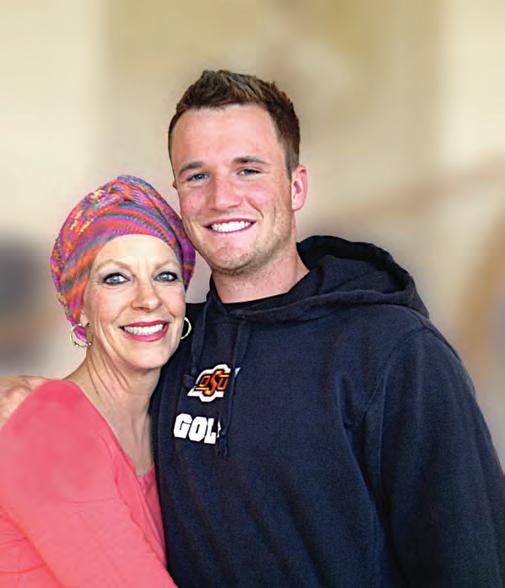
“SHE USED TO DO STUFF TO EMBARRASS ME. WHEN I WOULD GO TO SCHOOL OR PRACTICE, SHE WOULD PUT STICKY NOTES IN MY GOLF BAG OR IN MY BOOK OR MY BACKPACK. It would always be around people when I would open it, and it would be like a love note from my mom. She was always encouraging me, and SHE WAS DEFINITELY THE PERSON I WENT TO WHEN I NEEDED HELP OR ENCOURAGEMENT,” Clark recalled.
While his father, RANDALL , has held the heaviest influence on the majority of his golf career and Lise’s role was that of encourager, IT WAS SHE WHO INTRODUCED THEIR SON TO THE GAME AT THE AGE OF THREE. With Randall out of town on a lengthy business trip and Lise home tending to three energetic children, a much-needed outlet materialized in the form of range balls.
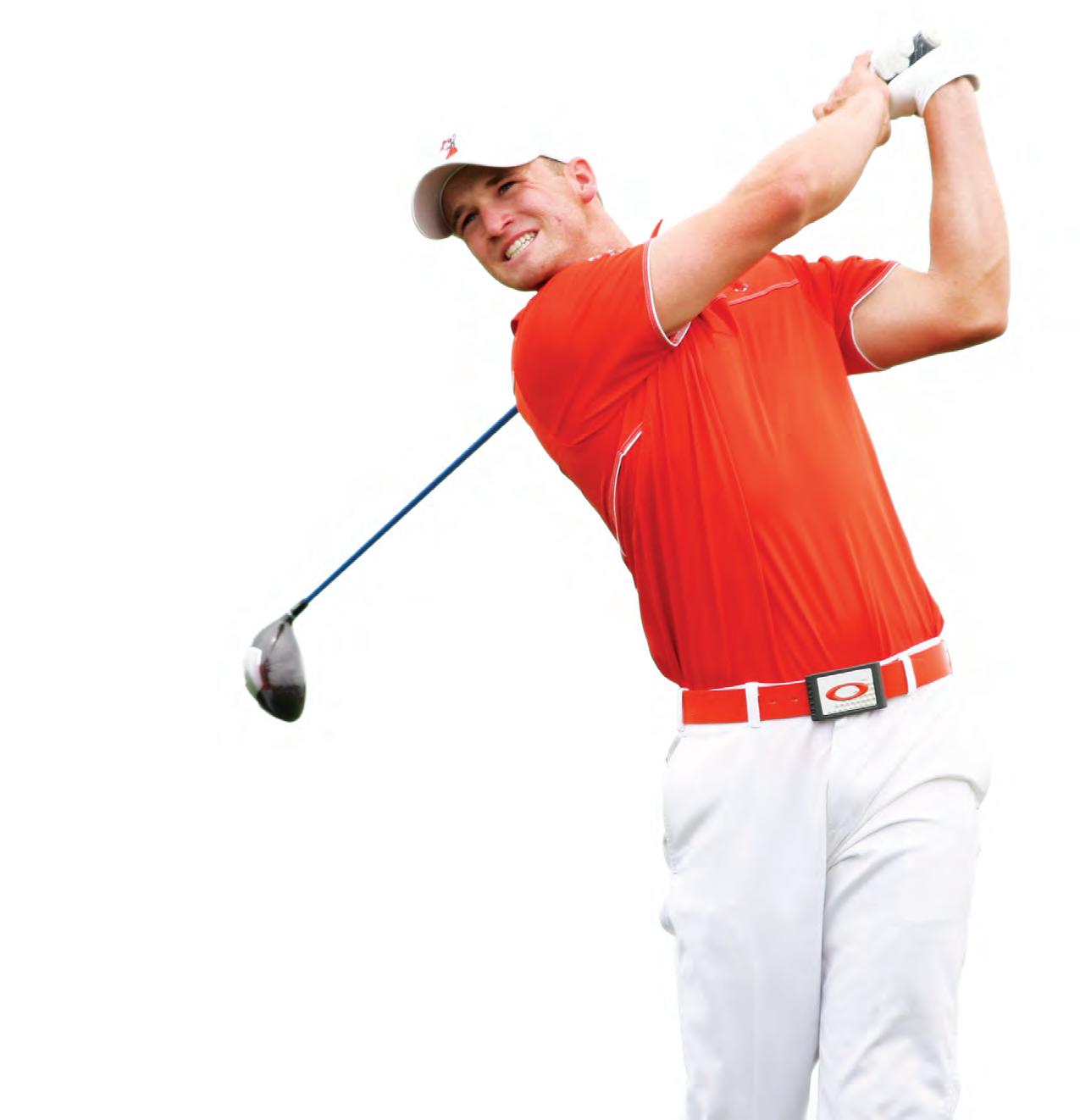
“I don’t know what compelled her, but she said, ‘Let’s go to the driving range.’ It would keep me busy and be peaceful for her and she could relax and kind of get away. We went to a local range by our house that isn’t there anymore, unfortunately,” Clark said.
After getting a bucket of balls and borrowing some clubs from the pro, Clark was hooked.
“I hit the full bucket of balls and asked my mom for more. I got another bucket and ended up hitting like 75 golf balls. Most kids don’t hit that many golf balls. and I was just really fascinated with it,” Clark said.
Three years later, Clark made his first hole-in-one, an event he thinks jump-started his career and fueled his desire to begin playing competitively. As time wore on, golf morphed from an activity to fill time in the summer until basketball, baseball and soccer rolled around again into Clark’s passion. The sport also provided an opportunity to be with his father.
45
“When I was younger, it was just because it was out of season for everything else. It was something to keep me busy. I think a lot of it had to do with being able to spend time with my dad,” Clark said. “I think because it was so hard and I am kind of a perfectionist
I LIKED THE CHALLENGE AND WAS SO INTRIGUED WITH IT.
I am kind of a gym rat. and it is really easy to practice on your own.”
On Aug. 2, 2013, Lise lost her battle with cancer at the age of 55.
“THERE’S A REASON FOR EVERYTHING. I BELIEVE THAT. As tough as it was at the time, there were a lot of great things that came from it. She was amazing,” Clark said.
After laying his mother to rest, Clark did exactly what she would have wished and returned to the outlet she had created for him as a toddler. He left the day following her funeral for the U.S. AMATEUR with a familiar face on the bag in his caddy and coach, OSU head man Alan Bratton
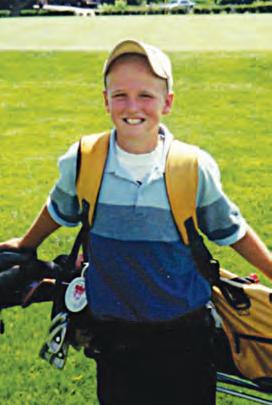
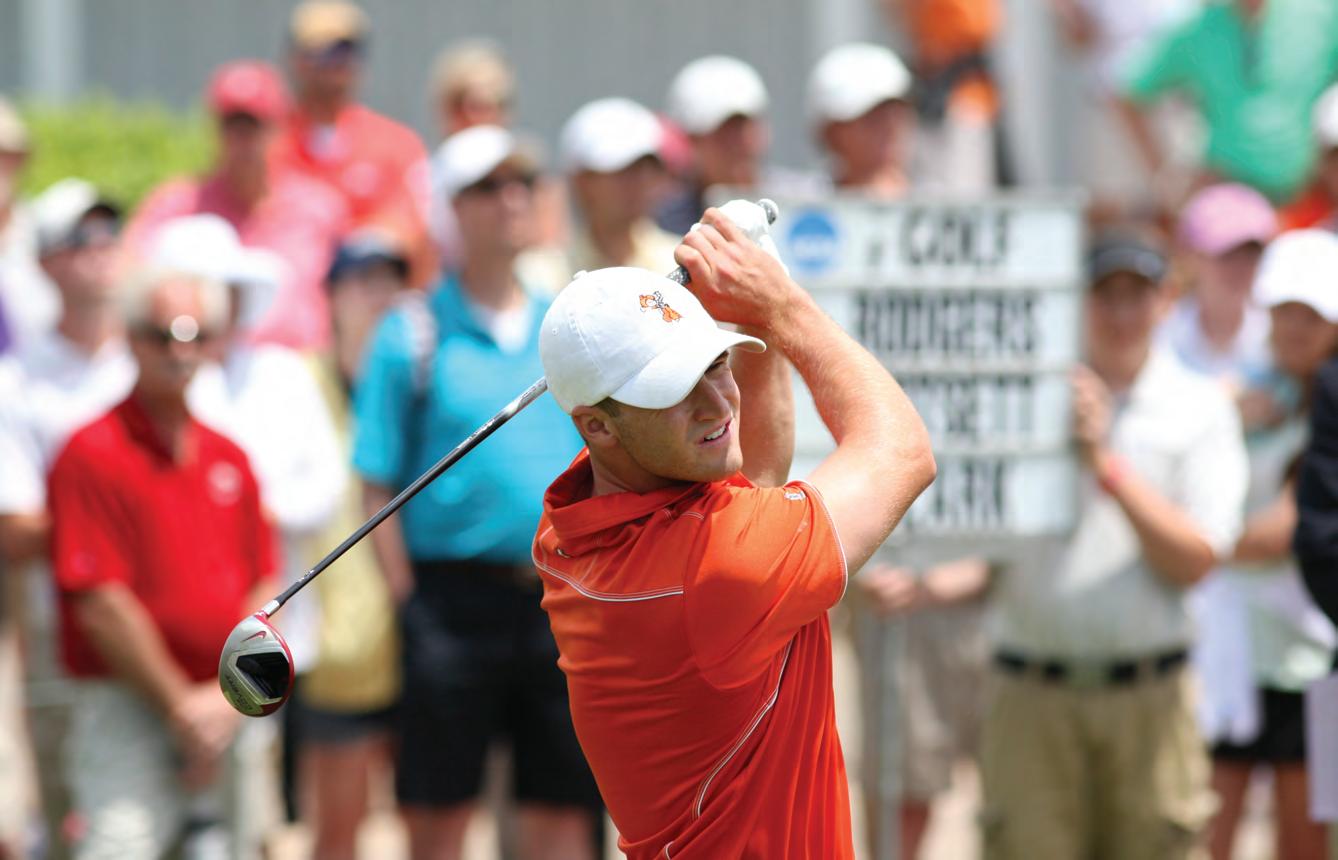
“We didn’t really sit down and have a big discussion about that. That was all his call and obviously either way would have been fine. I WAS HUMBLED THAT HE ASKED ME TO CADDY FOR HIM,” Bratton said.
Knowing Lise was no longer in pain, Clark was able to find an inner peace despite his significant loss.
“I didn’t want to see my mom in that situation and didn’t want to watch her suffer. I felt like I had so much weight on myself. When she did pass, it did kind of relieve a lot of that stress, and for some reason a lot of that anger went away,” Clark said. With Bratton on the bag, Clark posted a ninth-place showing during stroke play at the Amateur, which led to a spot in the match play bracket and served as a springboard into his redshirt freshman campaign.
“I ASSUME THAT WAS AN IMMEDIATE ESCAPE FOR HIM AND A CHANCE TO LIFT UP AND HONOR HIS MOM. He was impressive that week in the way he came along and really handled his emotions pretty much the whole week. That was a special memory for me, to be in that with him and to try to survive and play golf right after a tragedy,” Bratton said.
46
SPRING 2016
Upon rejoining the Cowboy lineup, Clark did not disappoint . In addition to being named THE BIG 12 PLAYER OF THE YEAR, he earned ALL-AMERICA HONORS and helped spearhead OSU’s run to the 17TH NCAA RUNNER-UP FINISH in program history.
Clark was starting to deliver on the promise he showed as prep star in Colorado where he captured a pair of state high school championships as well as a pair of state runner-up finishes.
“It really was impressive the progress he made throughout the year when he was in his world. I am sure golf was a great escape and a great motivator and helped fuel the fire because he wanted to be able to honor his mom with his play,” Bratton said.
Despite his successes, Clark’s perfectionist side was evident when the national title narrowly eluded the Cowboys.
“IT IS PRETTY BRUTAL BEING ON THE OTHER SIDE OF WINNING THE NATIONAL CHAMPIONSHIP OR THE STATE CHAMPIONSHIP or anything like that. Watching other people celebrate and the joy they have from that. Knowing that they worked hard and the hard work paid off and they got the championship, seeing that and not feeling that isn’t fun,” Clark said.
The heartache of coming up just short didn’t truly set in until after the fact for Clark and now serves as motivation to come out on the right side of college golf’s grandest event if the opportunity arises again.
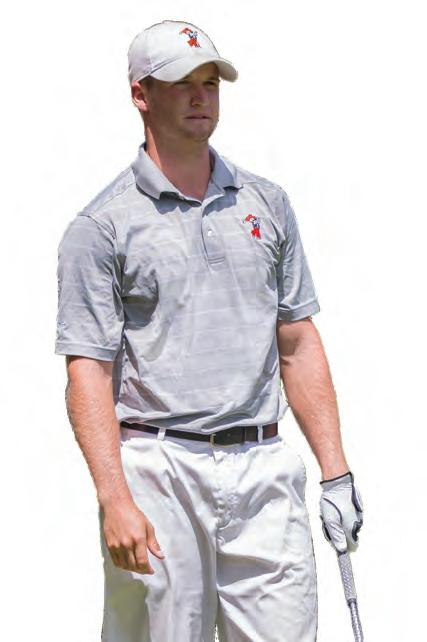
“I didn’t watch any of the coverage until two months later. It hurt to watch that, and
“I haven’t always handled things the best. A good testament to that was nationals. In the past I would have been devastated that we lost, but we got second and it hit me later that we had a chance to win a national championship, and not a lot of people have that opportunity,” Clark said.
“At the same time,
AT THE END OF THE DAY, IT’S JUST A TROPHY
and it’s just an accolade.
Not winning or not placing in tournaments doesn’t affect me nearly as much as it used to in the past.”
and when he is there he enjoys watching me more than he used to because he just enjoys being out there seeing me chase my dream. I definitely enjoy him coming to events,” Clark said.
In the midst of his fourth season as a Cowboy, Clark is still far from the finished product as he continues to learn how to manage the challenges the sport presents.
“I think he is coming to grips with the fact that the way he is going to improve is with all of the little mental experiences, handling emotions, managing expectations. If he can master those the way he has mastered some of the physical side of the game, he can be really good. He has a chance to be whatever he wants to be,” Bratton said.
AT FIRST IT DIDN’T QUITE RESONATE THAT I WAS THAT CLOSE TO WINNING A NATIONAL CHAMPIONSHIP,”
Clark said.
While motivation is never in short supply for a fierce competitor like Clark, life has given him perspective when it comes to the successes and failures golf brings about.
While his perspective on the sport has changed, so too has his relationship with his father since Lise’s passing. Clark says it is not so much about the golf as it is about the time spent together as father and son.
“Now, it is different. There was some pressure, and it was sometimes tough to have your dad there, especially when he was really involved in your golf. He is not as tough on me as he used to be,
And if Clark is able to channel the mental aspect of the game and get it to match his physical gifts?
“Physically, he is already a (PGA) Tour player. There is no limit on what he can be.”
47
“He is really, really good … There is no limit on what he can be.” OSU HEAD GOLF COACH ALAN BRATTON
PROUD PARTNER
OF THE OKLAHOMA STATE COWBOYS

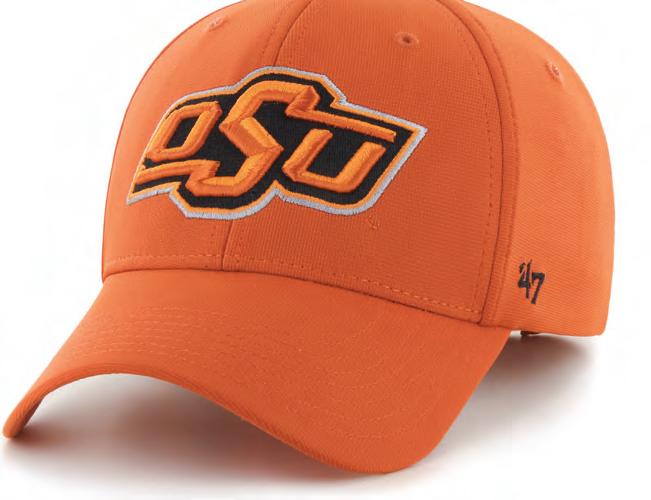
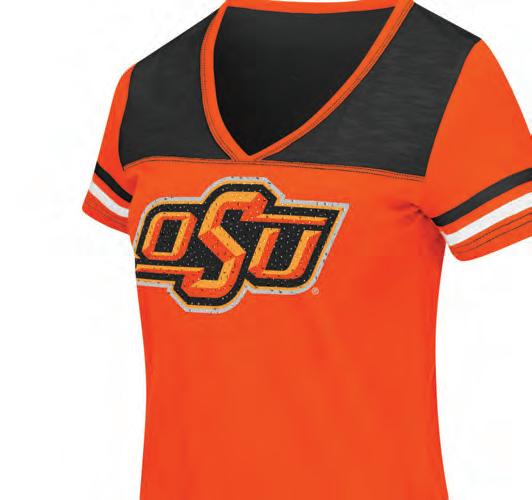

Now open in Stillwater.
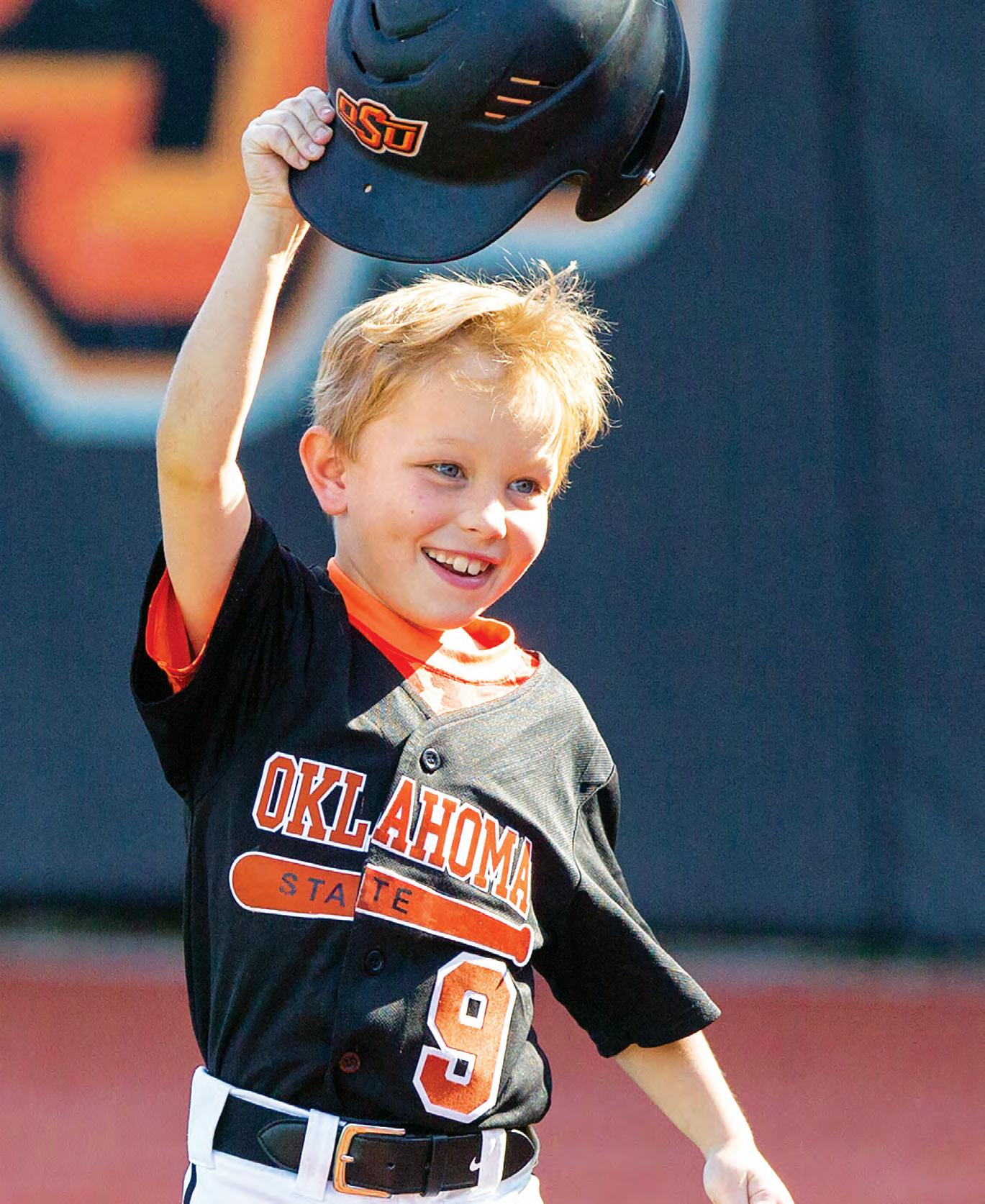
48
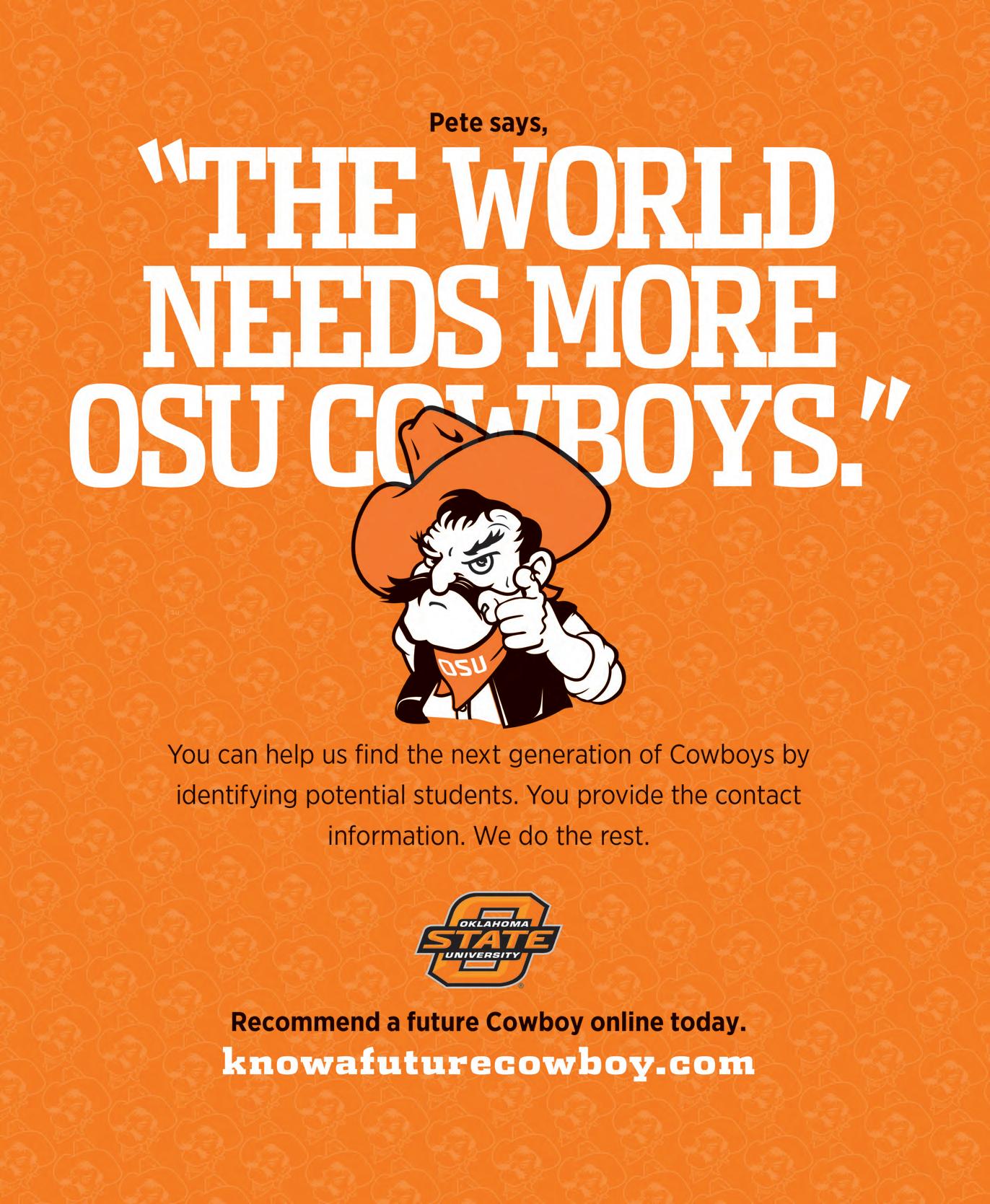
Mr. Iba’s Last
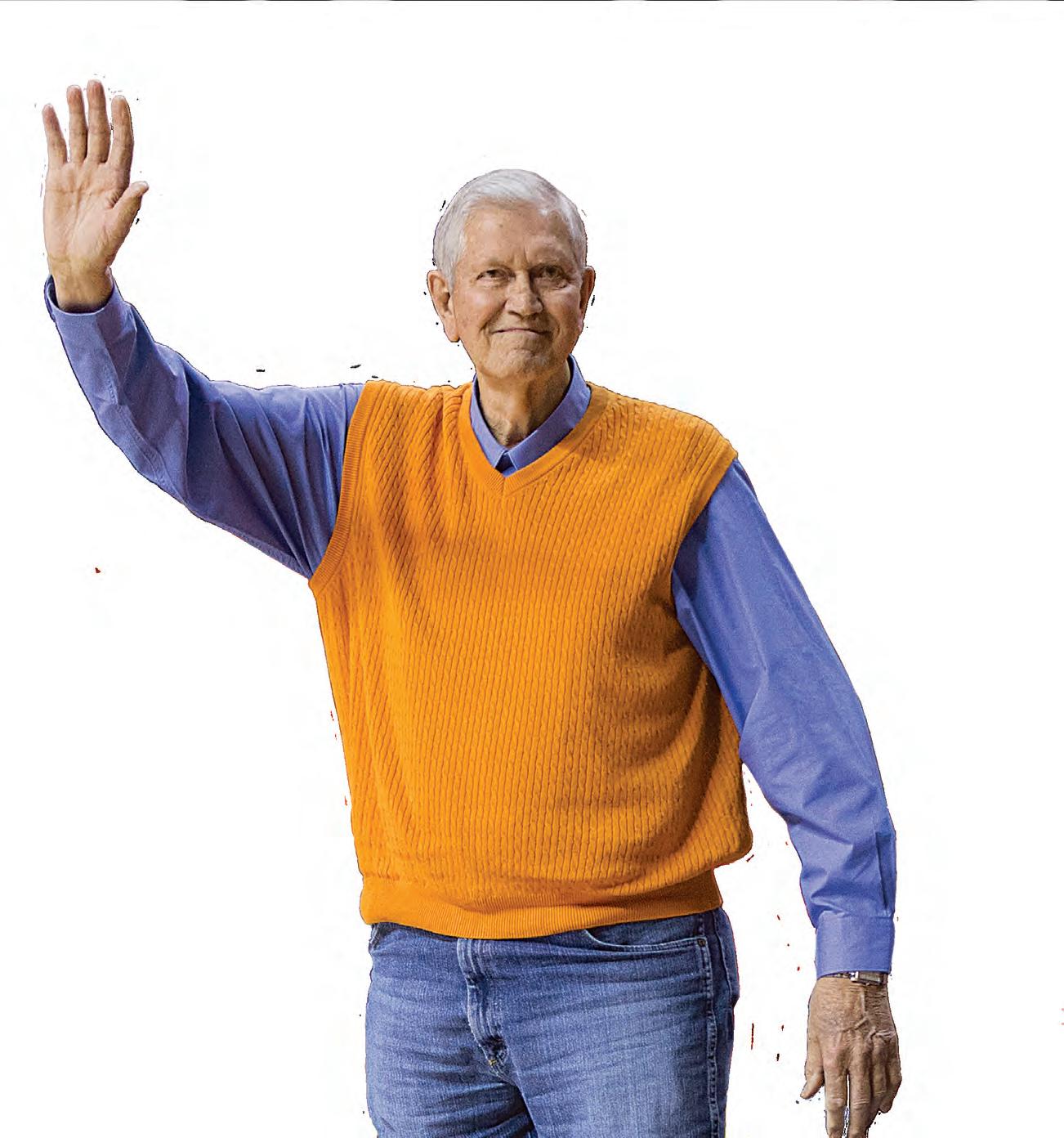
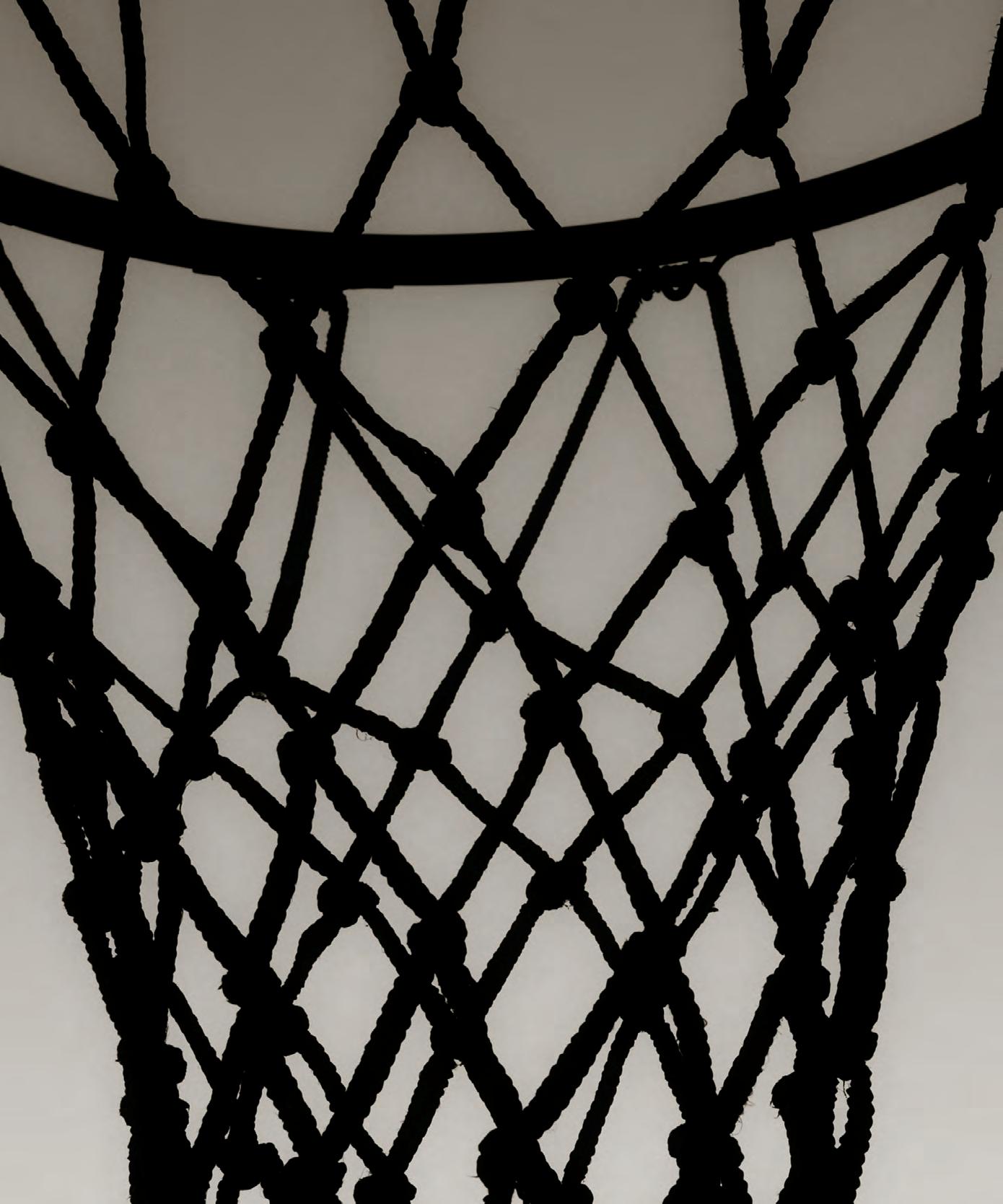
SPRING 2016
STORY BY GENE JOHNSON PHOTOGRAPHY BY BRUCE WATERFIELD PHOTOS / OSU SPECIAL COLLECTIONS
THIRTY-YEAR-OLD HENRY P. IBA TOOK OVER THE REINS OF THE OKLAHOMA A&M MEN’S BASKETBALL TEAM FOR THE 1934-35 SEASON
— A PERIOD WHEN GANGSTERS CLYDE BARROW AND BONNIE PARKER WERE GUNNED DOWN BY POLICE IN LOUISIANA AND THE DUST BOWL RAGED THROUGHOUT THE MIDWEST.
MR. IBA WOULD COMMANDEER AGGIE/COWBOY ROUNDBALLERS FOR 36 YEARS. He would turn over his head coaching duties in 1970 after compiling ONE OF THE MOST INFLUENTIAL AND SUCCESSFUL COACHING CAREERS IN NCAA HISTORY.
During a 22-year span, from 1937 through 1959, the school earned ALL-AMERICA HONORS 18 TIMES , or almost one every year. It was a true GOLDEN ERA FOR AGGIE BASKETBALL as Mr. Iba’s squads won TWO NCAA TITLES (1945 and 1946) and made another championship game appearance in 1949. That era also included another trip to the FINAL FOUR in 1951, an ELITE EIGHT run in 1958 and 14 Missouri Valley Conference championships.
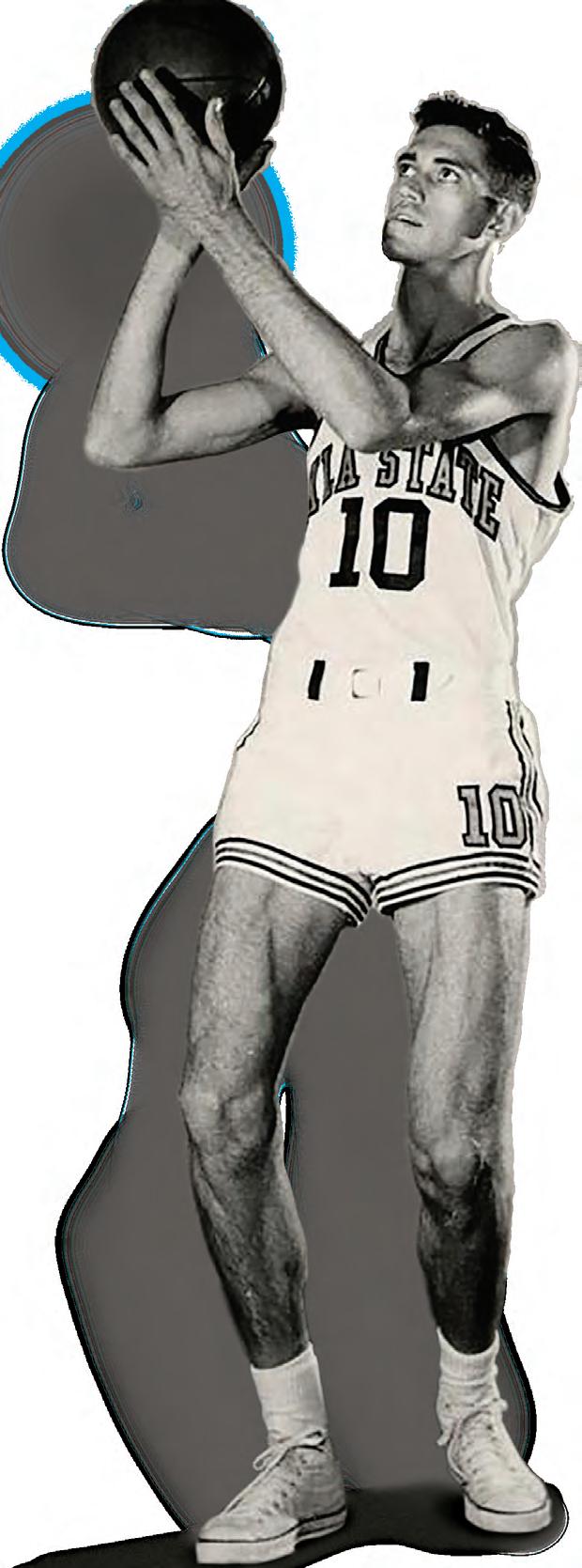
When the momentum slowed, a long dry spell followed. It would be more than three decades between basketball All-Americans in Stillwater.
WHO WAS THE LAST IBA PLAYER TO EARN ALL-AMERICAN LAURELS?
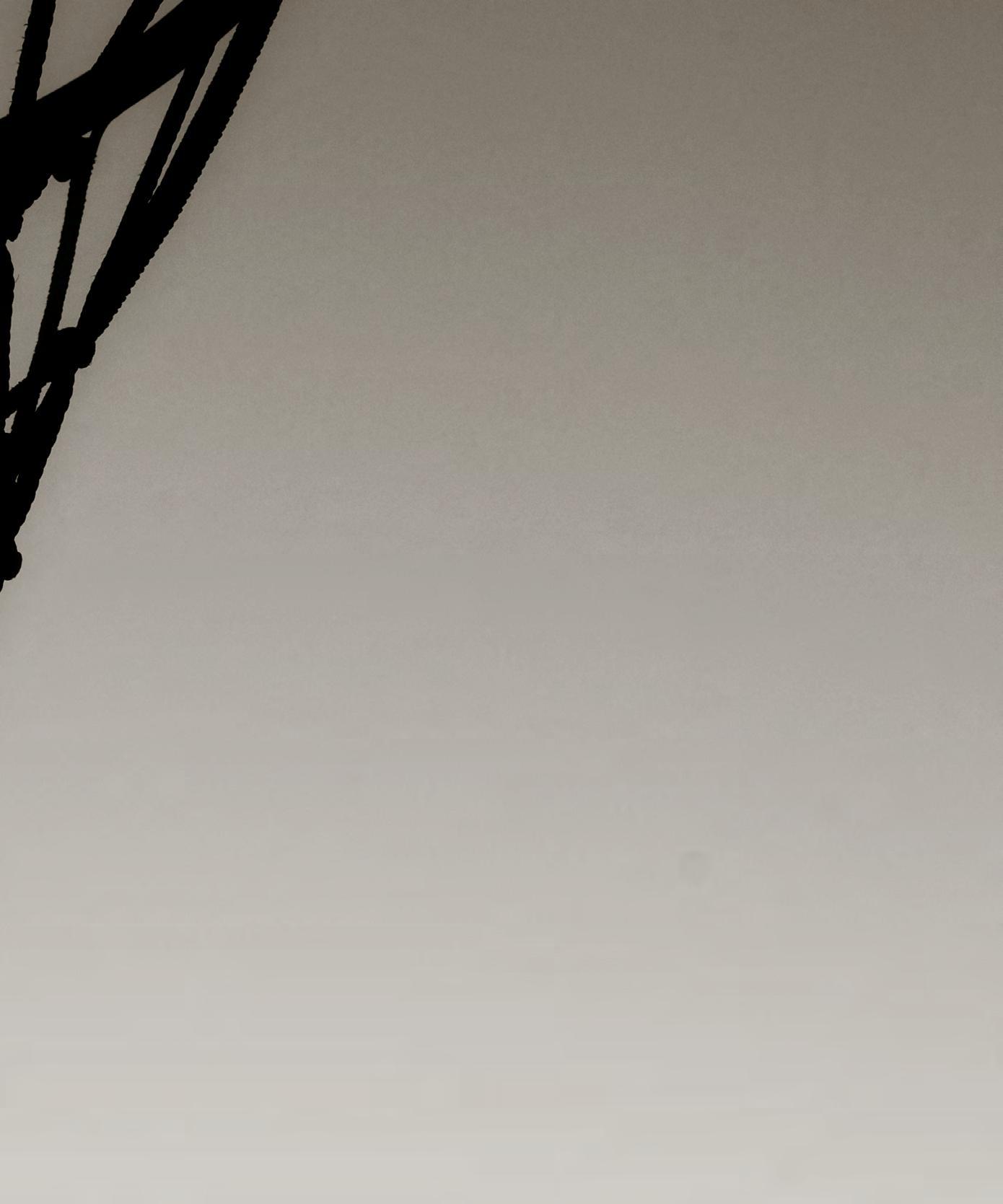
ANSWER: ARLEN CLARK IN 1958 AND 1959.
“He was a finesse player, smooth operator and quick for a big guy, a skilled rebounder, never shot a brick, could fake one way and go the other, weave himself through traffic, a joy to watch.” — Don Linsenmeyer
51
ON A COLD DAY THIS PAST DECEMBER
—
not a cloud in the sky — I made the almost three-hour trip from Edmond to Durant in southeastern Oklahoma for the purpose of interviewing an OLD FRIEND AND FORMER AGGIE/COWBOY GREAT, 80-YEAR-OLD Arlen Clark BEING EIGHT YEARS MY SENIOR, I NEVER PLAYED BALL WITH ARLEN, NOR SAW HIM PLAY. But we had a little in common, BOTH HAVING BEEN STARTING CENTERS FOR MR. IBA and working in marketing for Phillips Petroleum Company while playing for the PHILLIPS 66ERS , winners of numerous national AAU championships.
AS I DROVE UP AND PARKED IN FRONT OF ARLEN’S ATTRACTIVE, RED BRICK, RANCH-STYLE HOME, HE STOOD ON THE PORCH AND GREETED ME WITH A SMILE AND A WAVE.
“Hey! Great to see you. Come on in. Your trip ok?” he asked. We shook hands, exchanging pleasantries.
Wearing tan slacks, polished loafers and a black polo trimmed with an orange OSU logo, Clark looked fit as a fiddle. He is slender with a full head of silver hair and alert, dark eyes. Entering the living room he introduced me to Joyce, his bride of 60 years, then ushered me into his large, cozy den.
The fifth of six children, Clark was born in the tiny southeastern Oklahoma rural community of Yuba in 1936 to sharecropper parents in the same year Jesse Owens won four gold medals in the Berlin Olympics.
“WE WERE POOR, but it seemed like everyone else was too,” he said. “WE HAD NO INDOOR PLUMBING, used a water well outside our house and had an outhouse — a two-holer — same as our neighbors. WE DID HAVE ELECTRICITY for just a few light bulbs. WE USED THE NEIGHBORS’ PHONE and of course there was no TV back then. In 1940 there was a heck of a drought ... farmers couldn’t get anything to grow. So, when I was in the second grade, Daddy packed us up and we moved 20 miles west to Colbert, a little bigger place, where he worked construction and eventually built houses.”
Next to the family’s new home was a spacious open field. HIS DAD BOUGHT A BASKETBALL
“I ate like a horse, but just couldn’t put on any weight.
“Back then,” smiled Clark, “WE HAD GOOD BASKETBALL TEAMS DOWN HERE IN THIS PART OF THE STATE, knowledgeable coaches and some great players. JERRY SHIPP, played over at Blue, then became an All-American here in Durant at Southeastern State, played for the Phillips 66ers, then in 1964 won Olympic gold in Tokyo on a team coached by Mr. Iba. Down at Valiant they had 6'10" Travis Slaton , same grade as me and a stout post player, could mix it up under the basket. Travis was a freshman at A&M when I was. He went on to start as a sophomore, but decided to quit. He should’ve stayed. He would have been a huge help to our team.”
IN HIGH SCHOOL, CLARK STRUGGLED WITH HIS FREE THROWS.
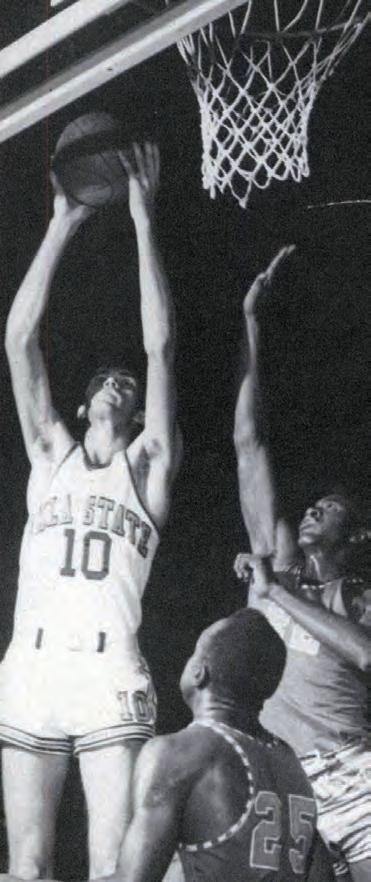
“Man, I tried everything,” he remembered, “even shot the ball underhanded, which a lot of guys did back then, but nothing helped. I COULD SHOOT FROM THE FLOOR, but would tense up. COULDN’T HIT A LICK FROM THE LINE.”
CLARK’S MARKS IN THE OSU RECORD BOOK
GOAL, AND THE REST IS HISTORY
as Clark started shooting the ball. This activity became his favorite pastime, a passion that he polished to near perfection.
From the beginning of Clark’s freshman year at Colbert High School to the middle of his sophomore year, he grew eight inches, from an even 6 feet to his full height of 6’8” at a slender 180 pounds.
Coaches began recruiting Clark his junior year. Ironically, an assistant coach for the Sooners, JOHN GREYSON , offered him advice on shooting free throws. Greyson traveled to Colbert several times to see Clark play, all the while extolling to the tall, talented youth the virtues of becoming a Sooner.
“I JUST COULDN’T RELAX SHOOTING FREE THROWS. John encouraged me to get comfortable, like I was when I shot from the floor. If one foot was six inches ahead of the other, it was OK.
His 20.4-POINT AVERAGE for a season RANKS SEVENTH . His 24-FOR-24 FREE THROW PERFORMANCE remains BEST IN NCAA HISTORY. His string of 40 CONSECUTIVE FREE THROWS over two games is a FORMER NCAA RECORD. His 85.2 FREE-THROW PERCENTAGE led the NCAA in 1958-59. The only other Cowboy player to lead the nation in a statistical category was Doug Gottlieb, who in 1998-99 led in assists with 8.8 per game. His 11.7 REBOUNDING AVERAGE in NCAA Tournament play is the best for any OSU hoopster with at least two NCAA games under his belt.
52
SPRING 2016
Shoot a lot of free throws every day and stay with it. I did and it worked. I got my rhythm down. IF JOHN HAD GOTTEN THE HEAD COACHING JOB AT OU, I MIGHT HAVE GONE THERE, but that didn’t happen.”
Clark regrets that his Colbert teams never made it to the state tournament, although he was selected player of the year by The Daily Oklahoman his senior year.
“We won a lot of games, just couldn’t win our regional.”
BOTH HIS JUNIOR AND SENIOR YEARS CLARK AVERAGED 33 POINTS PER GAME.
“Coach knew I could shoot it, so he ran the offense through me. That season we played our rival, Stringtown. They weren’t very good. I only played the first quarter and scored 12 points. After the game, their coach bragged they had held me to 12, which made my coach mad. Our next game with them was at their place. Coach told me to shoot it every time I touched it. I made 38 of 41 field goals and one of two free throws — 77 points — setting a state record that stood for a long time.”
Other schools to recruit Arlen besides Oklahoma A&M and OU included the Kansas Jayhawks with legendary coach PHOG ALLEN and Wichita’s Shockers with coach RALPH MILLER . Clark didn’t respond to numerous letters he received from other schools.
“MILLER WROTE ME A LONG LETTER AFTER I’D DECIDED TO GO TO STILLWATER, SAID I NEEDED TO COME UP THERE — he would let me shoot the ball a lot more than Mr. Iba would. HE WAS PERSISTENT. Other coaches guaranteed me a starting position along with a college degree and even promised to buy me some clothes. But LOOKING BACK, I MADE THE RIGHT DECISION.”
Mr. Iba and his assistant, Sam Aubrey, made the trip twice to see Clark play.
“I don’t know if they were more interested in recruiting me or getting in some fishing at Lake Texoma while they were down this way,” he said. “Anyway, I liked Mr. Iba and decided to go to A&M.”
“HE WAS JUST A SUPER GENTLEMAN ALL THE WAY THROUGH,” CLARK SAID OF MR. IBA. “Anything I would say about him would be good. After my first year, I told him I was planning to get married. He didn’t think it was a great idea, but said he would help me all he could ... ALWAYS CONCERNED WITH YOUR HEALTH, CONGENIAL, BUT BUSINESS-LIKE. FAIR, HONEST AND KNOWLEDGEABLE. He told me that, coming from a small school, I would have a hard time making his ball club and may have a difficult time being successful in school. I needed to decide what I wanted. Mr. Iba was basketball smart. He could figure things out and make adjustments.”
FRESHMEN WEREN’T ELIGIBLE TO PLAY VARSITY BALL BACK IN CLARK’S DAY. He roomed in the fieldhouse with fellow freshman Travis Slaton It was a single dormtype abode where two basketball players would stay. It once housed legendary three-time All-American Bob Kurland in the 1940s.
After ARLEN AND JOYCE MARRIED they moved into VET VILLAGE , married student housing originally constructed for veterans returning from World War II.
“Joyce worked on campus in the Bursar’s office. Pretty soon we had us a beautiful baby girl. I’d known Joyce since grade school. We were in the same class, gone steady since our junior year. My last year in Stillwater we had our son. Twenty-five years later his son, my grandson, was born in that same Stillwater hospital.”
Playing in the Missouri Valley Conference, Clark’s sophomore year, MR. IBA FREQUENTLY ALTERED THE STARTING LINEUP. MORE OFTEN THAN NOT THAT LINEUP INCLUDED — FOR THE FIRST TIME IN MR. IBA’S COACHING CAREER — THREE SOPHOMORES: CLARK, TRAVIS SLATON AND JERRY ADAIR of Sand Springs, who was a stellar baseball player as well and a future major leaguer. Other key players included All-American Mel Wright , sharpshooting guard Eddie Sutton, Roy Carberry, Joe Crutchfield, Jerry Hale and Henry Kemple
“Henry was big and tough,” Clark said of Kemple. “Spent several years in the service and was a golden gloves champ. He busted one of my ribs real good one time. Good guy to have on your team.”
From his high school days, Clark had managed to put on 10 pounds, making it up to 190.
“IN COLLEGE, OPPOSING TEAM’S FANS NICKNAMED ME ‘Beanpole,’ but it didn’t bother me.”
With his slender frame, Clark was a splinter of a player compared to other major college centers who normally weighed in at 220 to 250 pounds.
“ONE OF THE BEST OSU EVER HAD,” RECALLED EDDIE SUTTON. “Soft touch for a big guy, great ability to get the ball in the basket, played facing the goal, shot from mid-range. One of the truly outstanding shooters in OSU history, could knock it down … wonderful, quality individual. No one could shoot it better than he did.”
Clark returned the compliment.
“Just a super, competent teammate, give you help when you need it, tell you where you need to be, clutch shooter,” he said of Sutton.
The 1956-57 season was the Aggies’ last in the Missouri Valley Conference. The squad finished third in the league and had an overall record of 17-9. Early that season, top-ranked Kansas, behind 36 points from 7-foot-2 All-American WILT CHAMBERLAIN , prevailed over the Aggies in Lawrence, 62-52.
“I remember something funny about that game,” said Clark. “We were preparing for the opening tip, me a skinny 6-8 and Wilt, at least seven feet and over 250 pounds. Wilt had the perfect basketball build: big and strong, a physical specimen ... long muscular legs, narrow hips and broad shoulders. It was impossible to beat him down the court, even the little guys couldn’t. He had powerful legs with long strides. The ref is getting ready to throw the ball up. He’s young and looks nervous. We took our positions, the ref stepped in and threw the ball up ... must’ve gone at least 20 feet in the air. Laughter erupted from the
53
crowd. All the players are smiling. The ref blows his whistle, scurries around to get the ball, and finally gets himself together, grins and proceeds with a re-do with Wilt getting the tip.
“We lost that first game to KU, but I remember Mr. Iba telling our team that next time we would beat Kansas and he was going to spend some time figuring out how.”
A couple of weeks later Wilt and the Jayhawks traveled to Stillwater for a rematch in Gallagher Hall. The place was packed.
Mr. Iba had some simple advice to Clark. “IF YOU’RE IN THERE AND WILT IS READY TO SLAM A DUNK, DON’T TRY TO BLOCK IT BECAUSE HE’S SO STRONG HE’LL BREAK YOUR HAND OR ARM, AND WE DON’T WANT THAT.”
Kansas led 32-26 at the half, expanding the lead to 38-27 two minutes into the second half.
Former A&M/OSU Sports Information Director Otis Wile summarized the second half in an old Stillwater NewsPress article.

But the Aggies surged, scoring 9 points to bring the Orange within reach. Adair, Clark and Sutton authored that shooting streak. As the rivals traded shots, the score reached 44-44.
Sutton hit 9-of-14 set shots. The score was locked 46-all, 48-all, 50-all and 52-all. A&M’s first lead came when Sutton’s 20-footer tied it at 52-52 before Clark’s soft push shot from the corner rippled through to make it 54-52. Kansas tied the score with 3:49 to play.
A&M passed and cut, hunting the chink in KU’s armor as Wilt stood at the bridgehead and Kansas declined to come out of their zone. For 3:44 minutes, agonizing minutes, the Ibas waited for the chance at a point-blank shot, but the chance did not come. With 5 seconds left, the ball went to Mel Wright. He darted to his right on his dribble at the head of the circle of the south goal, just beyond reach of Chamberlain’s long arm, rose in a neat little jump, fired, and it was Bulls-eye City all the way. The huge crowd swept on the floor, engulfed the Aggies, lifted the little guard on eager shoulders and the great battle was over!
Sutton led the Aggie scoring with 18 points followed by 10 from Clark, scoring all of his in the second half.
“I remember that game like it was yesterday,” Clark said, looking serious. “Wilt was almost unstoppable, scored 32 points (with 14 rebounds). But we were able to slow him down a bit. He only got 10 the second half.
“On defense, my job was to front him and get help from the weak side. On this one particular play early in the second half, the Kansas guard lobbed the ball over me. Wilt received it on the low block, which usually meant a monster dunk. This time, my teammates Jerry Hale and Joe Crutchfield, both about 6-4 and strong guys, lowered the boom on Wilt. AT THE EXACT MOMENT WILT CAUGHT THE BALL, FROM THE BACKSIDE, JOE HIT HIM HIGH AND JERRY HIT HIM LOW, CUT HIS LEGS OUT FROM UNDER HIM, AND BIG WILT WENT DOWN WITH A THUD. It was a little bit before he got up, shaking his head as he did. After that it seemed Wilt was always looking over his shoulder for those guys, and it absolutely affected his game.”
SUTTON ONCE SAID THAT THE NINE FIELD GOALS HE DRILLED IN THAT FAMOUS KU GAME WOULD ALL HAVE BEEN THREE-POINTERS in today’s game. I mentioned that to Clark, who quickly responded, “That’s correct. From the corner — his favorite spot!”
KU went on to play in the NCAA Finals that season, losing a two-point contest to North Carolina.
Clark averaged 7.8 points per game that season and proved to himself and to Mr. Iba that he could play big-time college basketball.
OKLAHOMA A&M OFFICIALLY CHANGED ITS NAME TO OKLAHOMA STATE UNIVERSITY IN 1957, THE SAME YEAR THE DODGERS MOVED FROM BROOKLYN TO LOS ANGELES. The Aggies became the Cowboys and joined the Big Seven Conference, making it the BIG EIGHT. However, OSU wouldn’t play a conference schedule until the following season, and as a result played as an independent Clark’s junior year (1957-1958).
The newly named Cowboys were loaded with talent, including Adair, Hale, Carbury and Crutchfield, among others. Mr. Iba had high expectations. Clark, at 17.3 points per game, was third in the nation in free throw percentage and led the Pokes to a 21-8 record. THE TEAM WAS RANKED AS HIGH AS SIXTH NATIONALLY. Deservedly, CLARK RECEIVED NUMEROUS HONORS, THE HIGHLIGHT BEING THE FIRST “COWBOY” BASKETBALL PLAYER NAMED ALL-AMERICAN.

Hall of Famer OSCAR ROBERTSON , recently named one of the 50 greatest hoopsters of all-time, and his Cincinnati squad fell to the Cowboys, 61-57, in Gallagher Hall that season.
“Mr. Iba thought I could guard Oscar, but there was no way,” Clark said shaking his head. “He was muscled up, smooth, and we double-teamed him every time he touched the ball. Oscar played everywhere. We’d both jump up for a rebound, and when I started coming down, he was still on his way up. He mainly played outside, but he could out-muscle you and was a super, shifty player. Mr. Iba had us well prepared, and we won!”
In December, the Cowboys beat ABE LEMONS and Oklahoma City, 57-50. OCU’s roster included 6-9 HUB REED , an honorable mention All-American.
“Hub was a fine player besides being a nice guy,” stated Clark.
Postseason play saw Mr. Iba’s boys qualify for the NCAA Tournament. In the first round in Lawrence, THE COWBOYS RIPPED ARKANSAS, 65-40, TO ADVANCE TO THE ELITE EIGHT. Next up was the nation’s third-ranked team, TEX WINTER ’s Kansas State Wildcats and their overpowering front line. Three talented players made up their front line, including one of Kansas State’s all-time greats, All-American BOB BOOZER . K-State prevailed 69-57 and the Pokes’ season was over, but it had been a great ride. A couple of days later, one of the key Wildcat players had a nervous breakdown and K-State lost in the Final Four to Seattle and future NBA Hall of Famer ELGIN BAYLOR
54
“Unforgettable season,” reflected Clark, “We beat some good ball clubs.”
SPRING 2016
“Besides being a superb player and teammate, he did everything natural as a player. Silky smooth, played facing the basket and could nail his free throws,” said Lew Wade “Arlen was a great human being, a positive person, not one to gossip, never a showboat, didn’t beat on his chest, a joy to be around.”
ENTERING HIS SENIOR YEAR, CLARK WAS THE ONLY RETURNING PLAYER WITH EXPERIENCE. Adair left the team to sign a $50,000 (equal to $410,000 in today’s dollars) contract with baseball’s Orioles, and the rest of the crew had graduated. Players expected to contribute included Wade, Don Heffington , Bill Clarahan , three-sport athlete Dick Soergel and the head coach’s son, Moe Iba
“Moe could shoot the ball as good as anyone I ever saw,” remembered Clark, “but he blew his knee out. When Moe walked down the hall, his right arm hung threequarters-of-an-inch longer than the other one. I kidded him that what was wrong with it was he shot the ball so much!
“I PLAYED A LOT OF 40-MINUTE GAMES THAT YEAR UNLESS I GOT IN FOUL TROUBLE, which I hardly ever did. We didn’t have a real good team.”
THAT YEAR THE POKES FINISHED A DISAPPOINTING 11-14. CLARK AVERAGED 20.4 POINTS, LED THE NATION IN FREE THROW PERCENTAGE AT 85.2 PERCENT AND WAS THE FIRST COWBOY SELECTED ALL-BIG EIGHT. HE REPEATED AS AN ALL-AMERICAN.
That same year, in a game at OU, Clark canned 19 of his 20 free throw attempts.
“Earlier that year we had beaten them by 20, and I had a particularly good game. They decided they weren’t going to let me do that again, so every time I got the ball they’d grab me or shove, hit or kick me. I didn’t score a single basket.”
Former OSU basketball great Don Linsenmeyer, while a student at Stillwater High School, saw Clark play for the Aggies, “He was a finesse player, smooth operator and quick for a big guy, a skilled rebounder, never shot a brick, could fake one way and go the other, weave himself through traffic, a joy to watch.”

Teammate Soergel on Clark: “One of nicest guys I’ve ever been associated with; he was an All-American, but humble ... could flat out shoot it. At 190 pounds he didn’t have the bulk to play inside. When we played K-State, I would kid him not to hurt 240-pound Boozer. Arlen could dribble and weave in close to the basket ... you couldn’t help but like him.”
Cecil Epperly was a freshman hoopster when Clark was a senior and commented, “Besides being a tremendous player, Arlen tried to help us freshmen, giving us tips to make us better players.”
That season, against Colorado, Clark scored 42 points, including 24 of 24 at the free throw line. In the previous game, he sank 16 consecutive free throws giving him a string of 40 in a row, AN NCAA RECORD AT THE TIME
UPON GRADUATION, THE NBA FRANCHISE IN ST. LOUIS SHOWED INTEREST.
“Back then,” Clark recalled, “the average NBA player got $5,000 a year, and that’s what Phillips paid. If I got hurt in pro ball, I don’t get paid, and I’m out of a job. I took Phillips’ offer.”
Following two years with the 66ers, Clark worked 14 years for Phillips and in 1975 bought an interest in a Phillips distributorship, which he sold 14 years later. He then spent 15 years in the retail business and owned a men’s clothing store. SINCE RETIRING IN 2004, CLARK DOES PRETTY MUCH WHATEVER HE PLEASES, WITH AN EMPHASIS ON SPENDING TIME WITH HIS FAMILY.
“I enjoy golf, but had a heart issue and haven’t played in two years. I’m better now and plan to get back on the course this spring. Also, I served eight years on the Durant school board which I enjoyed. I’M A DEVOUT COWBOY FAN AND GET UP TO STILLWATER AT LEAST ONCE A YEAR.
Today Arlen and Joyce are blessed with two daughters and a son, seven grandchildren and seven great-grandchildren.
“Several of my grandkids were pretty good basketball players. One of my granddaughters is six-feet tall, has real good
hands, and is a skilled volleyball setter for a college team in Corpus Christi. My son and younger daughter both played junior college basketball.”
After 90 minutes answering my questions, Arlen and I said our farewells.
During my drive back I couldn’t help but ponder Arlen Clark, two times an AllAmerican, beat Chamberlain, smooth, could shoot the ball, played on a team ranked sixth in the nation, his teammates respect and love him ... ONE SPLENDID SPLINTER OF A PLAYER!
55
Send your comments/questions to OSU52Johnson@yahoo.com
WISH I COULD’VE SEEN HIM PLAY.
THREE-TIME CHAMP
SENIOR Alex Dieringer has sealed his legacy AS ONE OF THE GREATEST COWBOY WRESTLERS OF ALL TIME, compiling A 133-4 CAREER RECORD in an OSU singlet. At the 2016 NCAA Championships in Madison Square Garden, Dieringer claimed his THIRD NATIONAL TITLE (THE 16TH COWBOY TO DO SO) with a 6-2 WIN OVER Wisconsin’s Isaac Jordan in the 165-POUND FINALS.
Dieringer went on to become only THE SECOND COWBOY TO WIN THE DAN HODGE TROPHY, which is often referred to as the HEISMAN TROPHY OF COLLEGIATE WRESTLING.
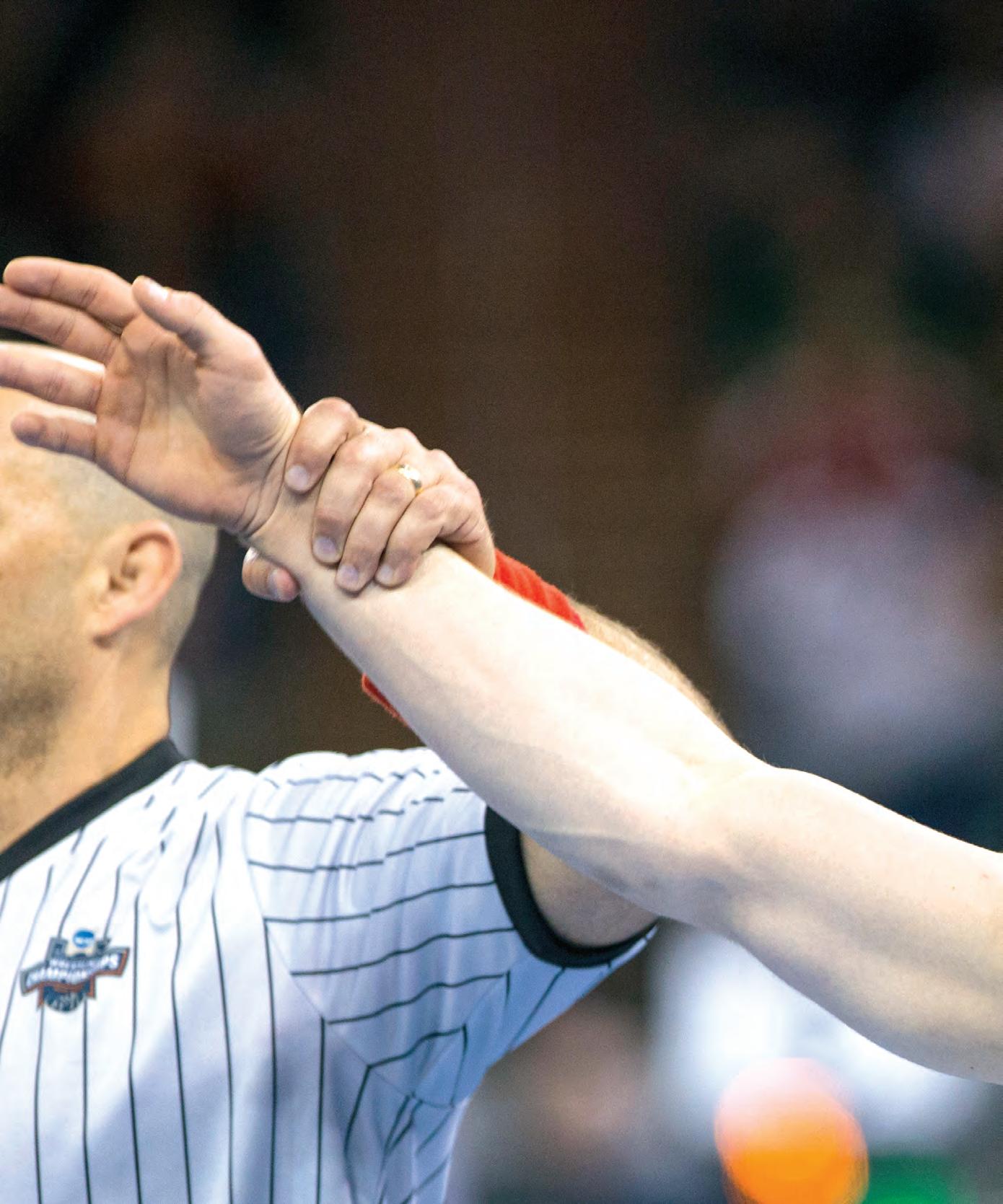
56
PHOTOGRAPHY BY BRUCE WATERFIELD
SPRING 2016
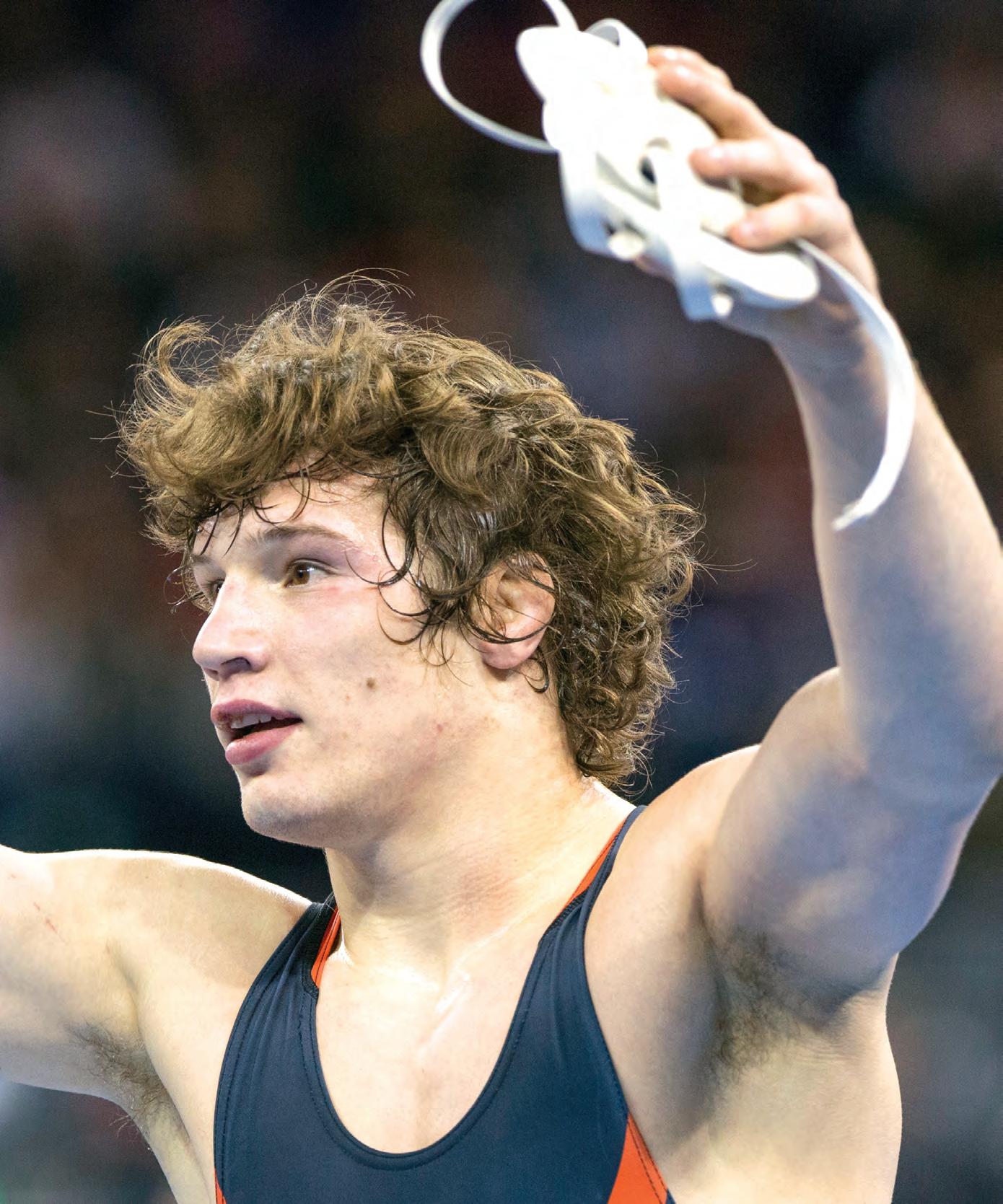
57
STORY BY RYAN CAMERON PHOTOS / OSU ATHLETICS PHOTO ARCHIVES
IN THE PANTHEON OF GREATS WHO COMPRISE THE STORIED HISTORY OF THE OKLAHOMA STATE COWBOY GOLF PROGRAM, A NAME UNDERSTATED IN SIGNIFICANCE IS TOMMY MOORE.
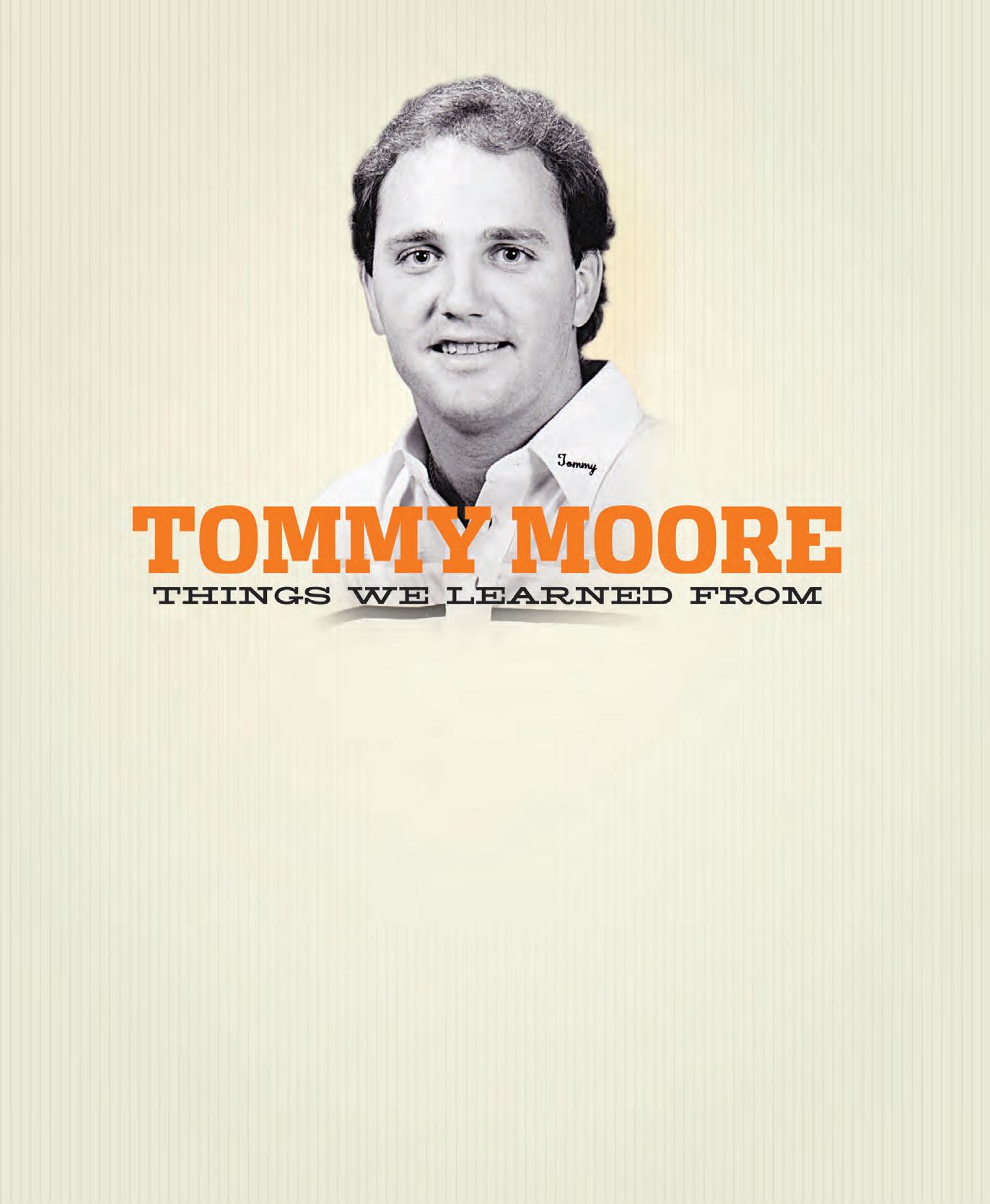
He constructed a résumé that saw him earn ALL-AMERICA STATUS THREE TIMES, including FIRST-TEAM HONORS in 1983, and help the Cowboys capture the NCAA NATIONAL CHAMPIONSHIP that same year. He would go on to play TWO SEASONS ON THE PGA TOUR and WIN THE 1993 BOISE OPEN on the Nike Tour.
NEVERTHELESS, the list of “marquee” names that come to mind when discussing Cowboy golf often omits Moore, the first player in program history to earn academic All-America status
“HIS VALUE TO THAT PROGRAM IS UNDERSTATED for whatever reason, and it can’t be overstated in my opinion,” former teammate Scott Verplank said.
“HE SHOWED THAT YOU COULD BE A FIRSTTEAM ALL-AMERICAN, GO TO CLASS AND TAKE CARE OF ALL OF THE OTHER RESPONSIBILITIES, AND BE A GREAT PRODUCER ON THE FIELD, COURT OR GOLF COURSE. In that way, he changed golf in Stillwater from just come here to play golf to come here and we are going to win and you are going to win in the classroom. We are going to put out what we hope are great people.”
58
SPRING 2016
Before
“YOU DON’T GET A PLAYER LIKE THAT BY JUST SENDING OUT A LETTER SAYING, ‘COME TO OKLAHOMA STATE’, especially when you are offering a half-ride and everybody else is offering a full. Try selling that,” said Moore’s college coach, Mike Holder
Not only was Holder able to convince Moore that Stillwater was the place to be, he did so at a fraction of the expense of what many of the nation’s powerhouses were willing to offer in terms of scholarship money.
Like he did with any highprofile prospect he landed throughout his career, HOLDER RELENTLESSLY PURSUED THE TALENTED NEW ORLEANS NATIVE . Not only did Holder like what he saw of Tommy Moore the player, Tommy Moore the person made an impression as well.
“If he was a basketball player you would say he was a gym rat. He loved the game. He worked hard and had an outgoing and engaging personality. You couldn’t find anyone at the tournaments who would say a bad word about him. He was very, very popular and a good player to boot,” Holder said.
In a time when recruiting restrictions were few and far between, unlimited phone calls and conversations at tournaments were permissible and
who
half-scholarship and he probably got a full ride at all those other places.”
Holder was getting a talented golfer and a player that would change the culture and face of the program.
Holder took full advantage. The legendary coach’s recruitment of Moore led to countless phone calls, a total so astronomical he needs no phone book to prompt his memory.
“I STILL REMEMBER HIS PHONE NUMBER. I CALLED IT SO MANY TIMES THAT IT IS JUST BURNED INTO MY BRAIN,” Holder said. “I probably talked to him every day and not for 10 minutes, we are talking hour-long conversations. My wife got so tired of it. When I would call him we would not only talk about him coming to school here, but we would talk about all kinds of other players and other things he was doing. HE WAS JUST AN EASY GUY TO TALK TO.”
Being equally adept in the classroom made several of the top academic institutions appealing options for Moore as well.
“The problem was trying to get him because everybody else wanted him too. HE WAS A VERY GOOD STUDENT, so he had all of those options to go to a Texas or a Stanford or all of those well-respected academic institutions,” Holder explained.
“IT WAS A REAL COUP TO GET HIM TO COME TO SCHOOL HERE. He came for, I am just going off memory, I probably gave him a
“Not only did I get a great player and a great leader for our team, and a great teammate for all of our kids lucky enough to be around him, but I got a great recruiter, too,” Holder said.
“He just knew everyone and had a good eye for talent. People liked being around him and they liked the idea of being on a team with him. It made playing golf at Oklahoma State even more attractive when he was here.”
With an ability to spot talent and his magnetic personality, Moore helped Holder reel in one of the brightest stars in a program stocked full of accomplished players.
Moore was instrumental in the recruitment of Verplank, which proved to be no easy task. Not only was the Dallas native highly sought after, he came from a family with deep ties to the University of Texas. Nevertheless, Moore and the brighter shade of orange won out in the end, and the Cowboy program was better for it with Verplank going on to become one of the most accomplished players to ever wear the orange and black.
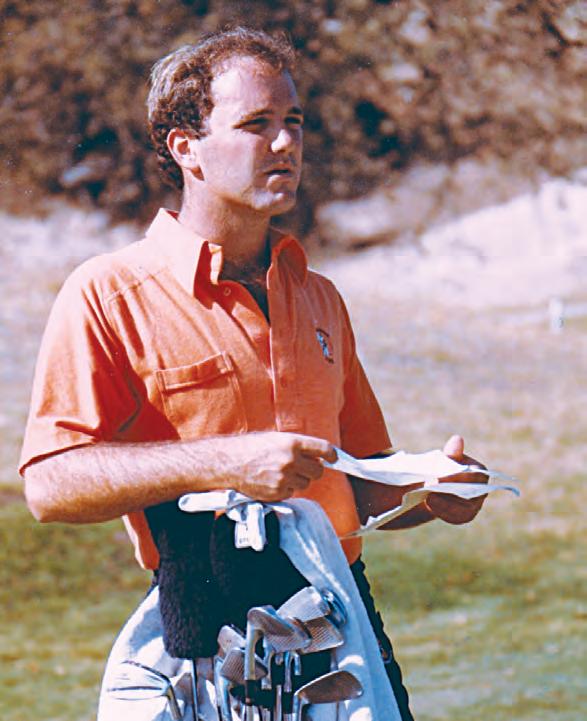
“He got Scott Verplank and a whole bunch of other good players to go with him,” Holder said.
Like Holder, Verplank was impressed by Moore the person as much, if not more so, than Moore the player. Playing in a junior tournament run by Moore’s family and friends in New Orleans, the two struck up a friendship that would lead to another successful chapter in the program’s history.
59
Moore,
was the NO.1RANKED JUNIOR GOLFER IN THE WORLD IN 1980 AT AGE 17, could leave his mark on OSU’s program, he first had to be convinced becoming a Cowboy was the right choice.
While Oklahoma State was lucky to earn the services of an immense talent like Verplank, it is the three-time first-team All-American who considers himself better off for following Moore’s lead.
“MY GOOD FORTUNE IS HE TOOK A LIKING TO ME AND THOUGHT I WOULD BE A GOOD PLAYER AT OKLAHOMA STATE,” Verplank said. “He thought I would be good there and he was very influential in convincing me that it would be a great place for me and he was right. He took an interest in me.”
the program toward its unprecedented all-around successes.
“HE CHANGED A LOT OF THINGS AROUND OSU GOLF,” Holder said. “He was the first one who made me appreciate the importance of academics. Before him, I was happy if our players were eligible. That probably put me in with the majority of coaches, regardless of sport. We went from accepting eligibility and mediocrity in the classroom to demanding excellence in the classroom and on the golf course.”
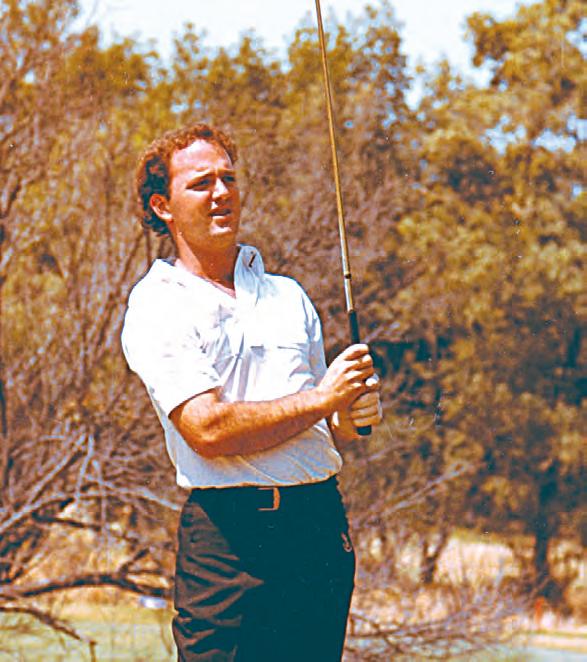
Since Moore’s groundbreaking academic All-America selection in 1984, 30 more Cowboys have achieved the honor.
“JACK NICKLAUS famously said it is virtually impossible to excel at the collegiate level in golf and academics because both are so time consuming. With the foundation laid by Tommy Moore we have disproved that myth multiple times over,” Holder said.
“Tommy Moore is responsible for all of that.”
The value of emulating Moore and the way he conducted himself was not lost on Verplank, who would go on to become a two-time academic All-American.
“He was a smart guy and everybody liked him, so he set a great example on how to act around people and how to treat people. When there is a guy that everybody likes they must be doing something right. I just got to watch him and be around him enough to try to pick up some of the things that he knew were important,” Verplank said.
“He was a great role model for me, to be quite honest. I was lucky, looking back, that he took an interest in me and tried to help me along. Maybe he thought that if he helped me along we would be better as a team and it worked out that way. We had a great friendship.”
With Verplank on board, the friendship strengthened.
“I think we were fairly similar in a lot of ways, with our personalities and what we believed in and how we approached playing, going to school and the things we thought were important,” Verplank said.
“He just kind of took me under his wing like a big brother more than anything else. I found out pretty quickly that he was a good big brother to have.”
While helping stockpile talent, it was Moore’s work away from the sport that altered Holder’s mindset and moved
With Moore setting the bar, those who followed now had a new standard of excellence to pursue in Stillwater.
“ Trip Kuehne took it to the max when he was NAMED THE OUTSTANDING MALE GRADUATE in the whole university and, oh by the way, WE WON THE NATIONAL CHAMPIONSHIP THAT YEAR. I think every player on that squad made academic All-America, so that is doing it at the highest level, both athletically and academically. I would like to think that is still the standard around here,” Holder said.
The discipline displayed by Moore to excel in all facets of life came via a maturity Verplank says helped him ease into life as a student-athlete.
“He was very mature for being a 20-year-old. I lived with him in the dorm my first year,” Verplank said. “I think he kind of took it upon himself to look after me. At that age, as a freshman in golf that was a pretty big deal to have an advanced peer of yours think you were good enough to come hang with them. That meant a lot to me.”
Moore’s maturity off the golf course mirrored a maturity he developed on the golf course. Because he developed at an early age, he was forced to
60
Mike Holder: (Tommy) was the first one who made me appreciate the importance of academics.
SPRING 2016
adapt and continue to hone other aspects of his game as the competition began to catch up physically.
“Nothing really would stand out other than when you added up the scores. I think probably as a junior golfer he matured at a young age. If you mature early, you have an advantage over everybody else in the distance you hit the ball and that starts to dissipate as other kids catch up with you. When he lost that edge he made up for it in his short game. He was a good all-around player,” Holder said.
And to no one’s surprise, Moore was able to grasp the most difficult aspect of the game, the mental side. With Holder describing him as a ‘CEREBRAL PLAYER WHO COULD THINK HIS WAY AROUND THE GOLF COURSE’, Moore earned an appropriate nickname from his teammates.
“HIS NICKNAME WAS DOC AS IN DOCTOR BECAUSE DOCTORS KNOW EVERYTHING, AND HE KNEW EVERYTHING,” Verplank recalled.
“He was a total stat guy. He would have been one of the greatest television announcers of any sport because he knew every stat. He could look at a newspaper for a minute, and we used to do this to him, we would let him look at the golf scores for a minute and take the paper away and say what did so and so shoot? He knew it 99 out of 100 times. He just had a great mind where he could look at something and he got it.”
After giving up playing professionally in 1995, Moore worked as a teaching professional. Among
those he counted as students was former NFL quarterback ARCHIE MANNING, who called Moore ‘the nicest guy you would ever want to meet and a natural teacher.’
Tragically, golf and society was robbed of Moore and his great mind far too early with OSU’s team “doctor” succumbing to a rare blood disease in 1998 at the age of 35. The loss leaves his former coach pondering what could have been for OSU’s catalyst of change.
“I think he had a positive impact on every life he touched and it is just a shame that he died at such a young age because I think he had a real future either as a teaching professional or as a college golf coach,” Holder said.
“I THINK HE WOULD HAVE BEEN A GREAT COLLEGE COACH. I know he was a great husband and a wonderful father. It is just a shame that (Moore’s wife) TRACY and (son) MASON got such a short time to be with him.”
Verplank remains close with the Moore family.
“His wife and I are still friends. I still talk to her five or six times a year for different things. Mason, is now 21-years-old and
I have known him his whole life,” Verplank said.
“It was brutal. I remember when he called me and told me he had something bad going on, talking to his dad, who was a doctor. It was a sad deal. It came on and it was inevitable, and in six months he was in bad shape,” Verplank said.
“He, his family and his wife all had a great attitude about what was happening,” Verplank added. He was only worried about his son and his wife at the end. He left a great legacy, not only for them, but as Coach Holder said, he left a great legacy for the whole Cowboy program.”
Despite being gone for nearly 20 years, Moore’s impact on both coach and teammate is unmistakable to this day, and his legacy was put on permanent display for all to see this past fall with his addition to the RING OF HONOR at Karsten Creek during a ceremony at the annual Cowboy Pro-Am

“Now that I am a little older, those are the kind of people you like to be around and the kind of people you can learn the most from. It was a big
blessing for me that he was in my life,” Verplank said.
“HE WAS A GREAT COMPETITOR IN EVERYTHING HE DID, in golf and knowledge and going to class and doing all of the things right. He knew right from wrong. HE SET THE STANDARD FOR WHAT YOU WOULD WANT A STUDENT-ATHLETE TO BE. He took care of all of his responsibilities. You would strive to have a bunch of Tommy Moores on your team because they are guys that are going to not only make you better as a coach, but make your whole team better and your program better. HE WAS AN A-1 CONTRIBUTOR TO SOCIETY and he was a very, very special person.”
And for the man who spent countless hours tying up the phone line between Stillwater and the Crescent City?
“It is easy to say good things about Tommy Moore,” Holder said. “HIS IMPACT FAR SURPASSED WHAT HAPPENED ON THE GOLF COURSE. HE WAS A LEADER, AND AS A 19-YEAR-OLD KID, HE CHANGED ME.”
61
MASON and TRACY MOORE , along with OSU coach ALAN BRATTON , at TOMMY MOORE’S Ring of Honor induction during the 2015 COWBOY PRO-AM
Rob Walton WAS ON THE BRINK OF HIS DREAM. BUT AS IT OFTEN DOES IN LIFE, FATE CRUELLY INTERVENED.
FORCED DOWN A NEW PATH, HE FOUND AN UNEXPECTED CALLING. AND NOW THE MAN THEY CALL “THE WIZARD” HELPS OTHERS PURSUE THE SAME DREAM THAT HE ONCE NEARLY REALIZED.
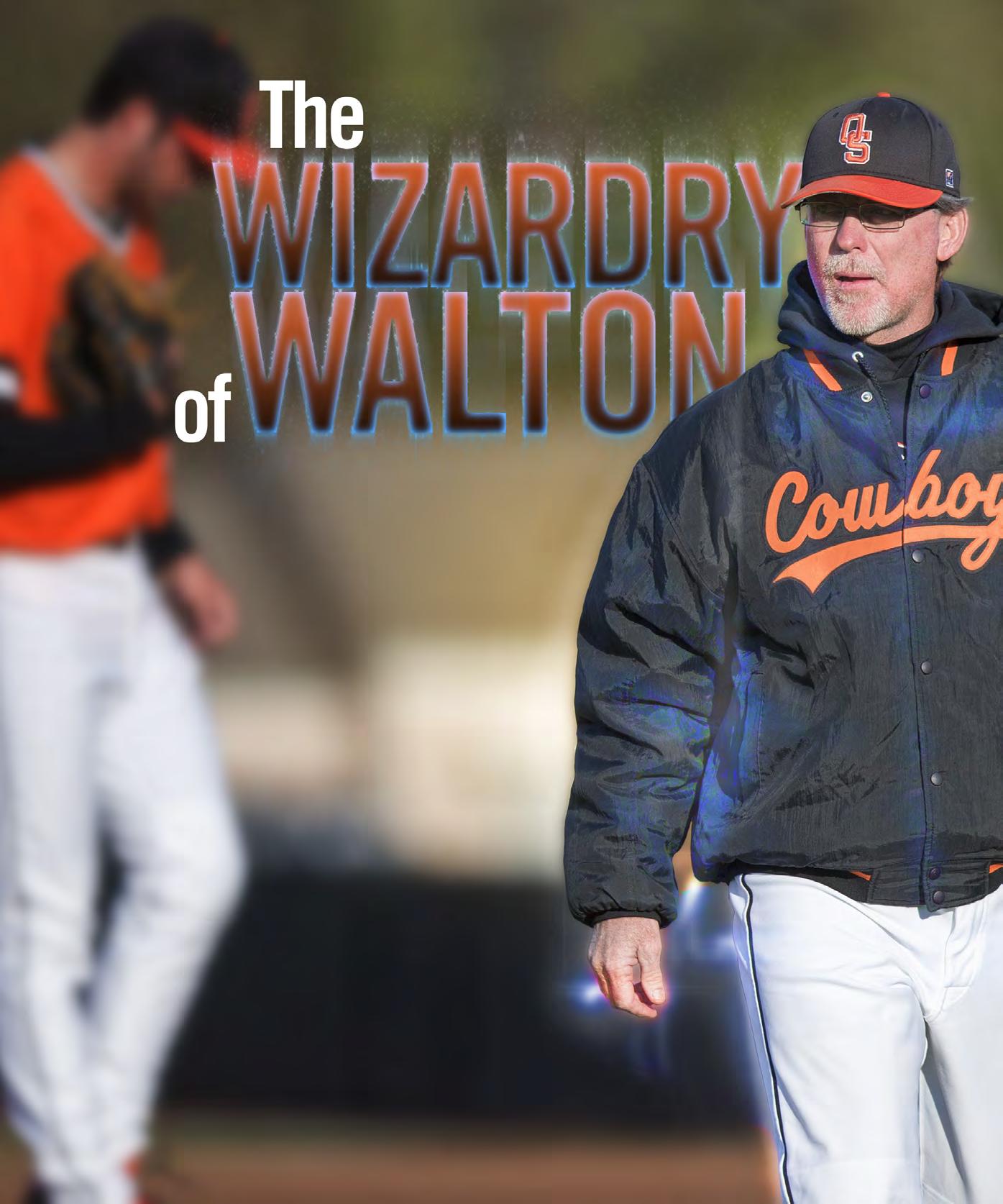
62
STORY BY WADE McWHORTER PHOTOGRAPHY BY BRUCE WATERFIELD
SPRING 2016
alton’s story began in Rutherford, N.J., a borough located just eight miles west of midtown Manhattan.
The son of ROBERT AND AGNES WALTON , the question wasn’t if Rob would pursue a career in athletics, but which sport would he chose.
Both Robert and Agnes immigrated to the United States from Scotland. Rob’s mother was first to arrive, leaving her homeland with her sister to escape the country’s religious wars and settling in New York.
ROBERT WAS A WORLD-CLASS SOCCER PLAYER, starring for HAMILTON FC and CELTIC FC . He worked in the Scottish coal mines in the morning, played soccer in the afternoon and attended engineering school at night.
When his soccer career ended, Robert left Scotland and journeyed to Detroit to take a job with General Motors. He eventually found his way to New Jersey, where he married Agnes and began working for an engineering firm designing hydraulic and pneumatic machines.
Robert passed his love of sports on to his son.
“MY DAD WAS A PRETTY DIVERSE GUY, AND HE JUST KIND OF INTRODUCED ME TO EVERY SPORT,” Walton said. “I had to make a choice to play football or soccer in the fall. My dad was about five-foot-nine so I THOUGHT IF I WAS GOING TO BE ABLE TO GET TO COLLEGE SOMEHOW, IT’D BE SOCCER OR BASEBALL. I was six-feet tall and didn’t think I was probably going to get any bigger — and I didn’t. So I stuck with soccer, basketball and baseball.”
For a while, IT LOOKED LIKE WALTON WOULD FOLLOW HIS FATHER’S FOOTSTEPS AND MAKE HIS NAME ON THE SOCCER PITCH. His first college recruiting letters began pouring in following his sophomore season at Rutherford High School after he led the state in scoring.
The buzz surrounding Walton’s soccer skills even reached Scotland. His father arranged with one of his former teammates turned Scottish World Cup coach for Rob to play on one of Scotland’s second division teams. It was a chance to see just how far soccer might take him.
But by that time, ROB HAD ALSO BLOSSOMED ON THE PITCHER’S MOUND, WITH A FASTBALL CLOCKED IN THE 90S.
With letters from professional baseball teams and college baseball programs now joining the pile in the Walton’s mailbox, ROB DECIDED THAT BASEBALL MIGHT BE HIS BEST CHANCE AT A PROFESSIONAL SPORTS CAREER in the U.S.
One of those teams wooing Walton was Oklahoma State, which had just begun its ascension into college baseball’s elite.
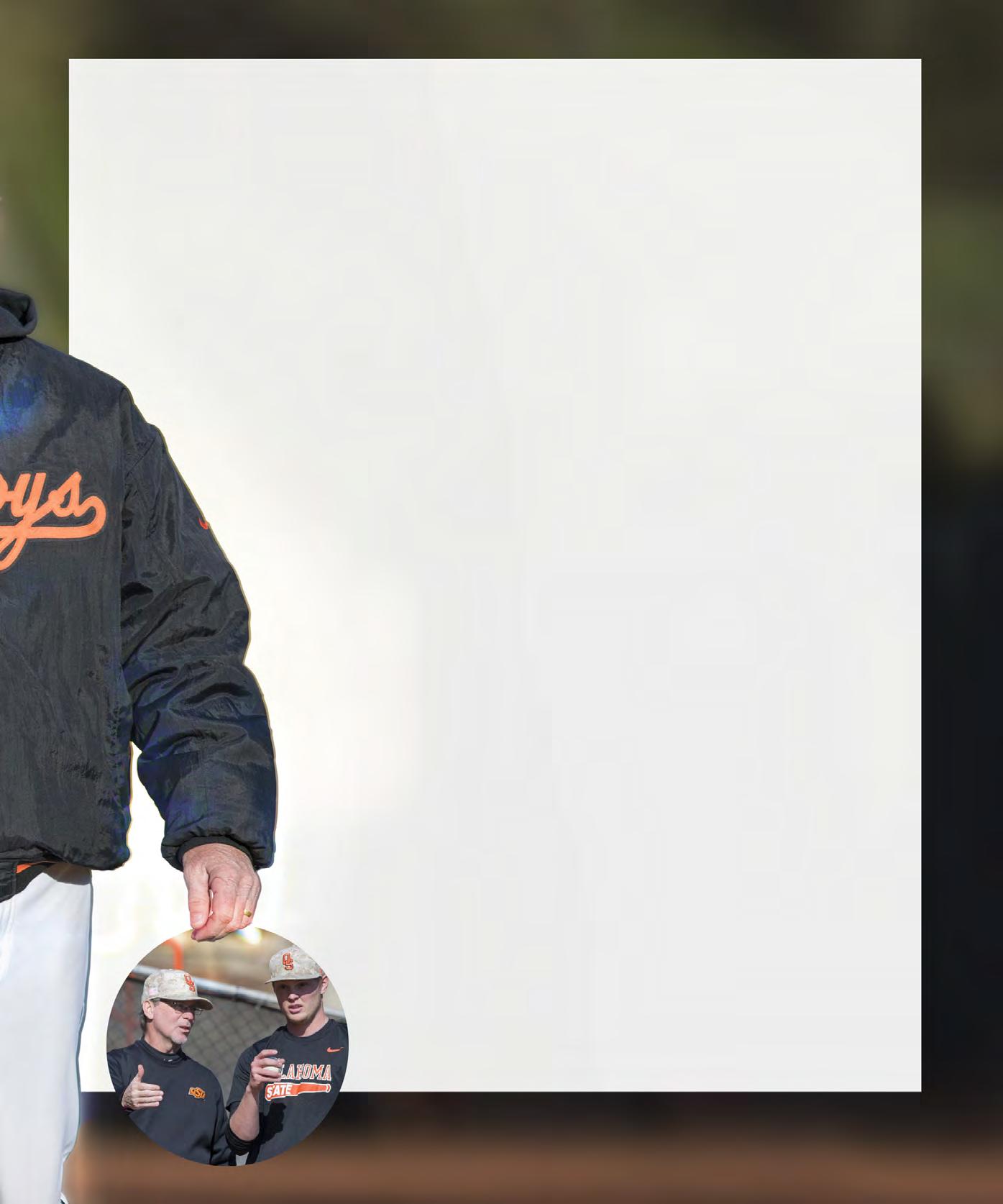
“Back then, recruiting was a lot different — you got a lot of phone calls and mail and a then a lot of people started to show up at the games,” Walton said. “You were allowed three visits, so I decided I’d take one close to home and the other two at other places.
“Dave Holliday (OSU assistant coach) came and saw me and said, ‘You could play for us right now.’ Then the following year they went to the COLLEGE WORLD SERIES for the first time SO I TOOK A TRIP OUT HERE.”
That trip to Stillwater sold Walton on his college destination.
“I had the taste of professional sports with where I grew up — Yankees, Mets, Giants, Jets and all the rest — so I WANTED A LITTLE BIT MORE OF A COLLEGE FEEL, A COLLEGE ATMOSPHERE. THAT’S WHAT DREW ME TO OSU when I took the trip,” Walton said.
WALTON SIGNED HIS LETTER OF INTENT to play for the Cowboys a week before the Major League Baseball Draft. AS FATE WOULD HAVE IT, WALTON HURT HIS ARM in the state championship game on the same day in 1982 that the Texas Rangers drafted him in the sixth round.
63
Josh Holliday:
“There’s not a high school coach or amateur baseball coach in the country who doesn’t want to borrow information, or a professional organization that doesn’t hold him in the highest regard.”
THE INJURY CEMENTED WALTON’S PLANS TO PLAY AT OSU, but his collegiate career didn’t exactly take off.
For three years, Walton struggled to pitch with an arm injury that numerous doctors failed to correctly diagnose. FINALLY, SOME ADVICE FROM ONE OF OSU’S STAR FOOTBALL PLAYERS PAID OFF.
“I saw multiple doctors and really struggled with (the injury) — I was scuffling a little bit,” Walton said. “I lived in the athletic dorm at IBA (HALL) , and I ran into Thurman Thomas Thurman said that DOC (CARY) COUCH at Stillwater Medical Center had drained his knee and made him feel good. I went and visited him, and they did exploratory surgery and found the issue.”
What WALTON LEARNED WAS HE HAD A TUMOR ON HIS SHOULDER BLADE WITH A NERVE WRAPPED AROUND IT. Following surgery to alleviate the problem, Walton went into his senior season in 1986 finally healthy.
Pain-free for the first time in his collegiate career, Walton’s fastball velocity was down, but other parts of his game were sharpened.
“I really learned the value of pitching, commanding and changing speeds and those things,” Walton said. “I became a smarter pitcher. Then I thought IF I COULD GET SOME VELOCITY BACK I WOULD REALLY MAKE A RUN AT THIS THING.
“I was able to put a good year together, which is really satisfying because you really want to leave on your own terms on a high note.”
WALTON’S SENIOR CAMPAIGN WAS ONE OF THE BEST SEASONS EVER TURNED IN BY A COWBOY HURLER as he went 13-2 with a 3.20 ERA and tossed nine complete games in 18 starts.
Walton was part of a veteran OSU pitching staff during that ’86 season that included Jeff Bronkey, Gordie Dillard, Marv Rockman and Dave Osteen. The lineup featured five freshman starters, among them a couple of guys named Robin Ventura and Monty Farris, on a team that started 11-10 before winning 31 consecutive games.
THE COWBOYS EVENTUALLY REACHED OMAHA AND THE COLLEGE WORLD SERIES, WHERE WALTON TURNED IN ONE OF HIS MOST MEMORABLE PERFORMANCES TO HELP OSU EARN A 4-0 WIN OVER INDIANA STATE.
Along with dominating the Sycamores’ lineup that day, you can bet SOMETHING ELSE OCCURRED — WALTON’S CAP FAILED TO REMAIN ON HIS HEAD. Walton’s propensity for losing his hat while delivering the ball to home plate is what OSU fans remember most about his playing days.
“I wasn’t a big guy obviously — when I came in here I weighed 155 — but I pitched 93 and touched 95,” Walton said. “But it took every ounce of my being to get it up there. So I kind of pitched that way, pitched with a little bit of a chip on my shoulder. I didn’t want to leave anything in the bag. EVERYTHING I HAD WENT TO HOME PLATE. I probably recruited other parts of my body to get the ball going up there AND MOVED MY HEAD A LITTLE TOO MUCH.
“I THINK SOMEBODY COUNTED ONE TIME — I THREW 110 PITCHES AND MY HAT FELL OFF 89 TIMES. I threw 89 fastballs is basically what it comes down to because it didn’t fall off on any other pitch.
“I enjoyed competing, and I WOULD LITERALLY TRY TO THROW THE NEXT FASTBALL HARDER THAN THE LAST ONE. I was gonna go all out all the time — that was kind of my personality.”
That personality is one that a young Josh Holliday remembers well.
“Much like he is now, Rob was gentle and very kind to Matt (Holliday) and me and very close to my family,” said Holliday, whose father Tom was OSU’s pitching coach. “I remember how aggressive he was and how he’d throw so hard his hat would fall off. That was about the age when the players started to influence me, and I started to become more aware of them and what they were all about.”
FOLLOWING HIS STANDOUT SENIOR SEASON, WALTON WAS A 25TH-ROUND PICK OF THE BALTIMORE ORIOLES. His first full season of pro ball came in 1987, and he went a combined 14-5 with stints at the Class A and Double A levels.


Walton was feeling confident about the trajectory of his career; his velocity was climbing, he was commanding his pitches.
The Orioles felt the same way, and Walton began 1988 at Double A Charlotte. After losing his first two decisions, he reeled off seven-straight wins and was named to the all-star team.
BUT SOMETHING WAS WRONG. Walton’s shoulder was constantly fatigued, and he felt his velocity dropping.
64
SPRING 2016
PHOTO / OSU ATHLETICS PHOTO ARCHIVES
Then he heard the words he’d been waiting to hear from his manager: “You’re out of here. You’ve got one more start and you’re going up.”
“Up” meant the big leagues. Walton was excited and nervous. With his dream at stake, there was no way he was holding back.
“If you can get up (to Major League Baseball), then you’re there and you have the benefits of all the doctors,” Walton said. “So I was just rehabbing, taking care of it and trying to gut it out. I should have shut it down and didn’t, but I had a lot on the line so I took my chances.”
SEVEN INNINGS INTO WHAT WAS SUPPOSED TO BE HIS MINOR LEAGUE FAREWELL, WALTON’S DREAMS WERE DASHED.
“I threw a pitch and that was the end of it. I TORE MY ROTATOR CUFF IN HALF,” Walton said.
Walton found out later that a partial tear in his rotator cuff had been there for weeks but had gone undetected while he pitched through the pain and fatigue.
“That’s just the way it was in the midto-late ’80s — it was more like medieval science compared to what we have now,” Walton said. “It was really bad luck because once it ripped in half, it was unrepairable. It became sticking plastic and staples in there to try and put it together and hope you can function the rest of your life.
“I tried to rehab it, and it just wouldn’t hold enough for me to pitch over a period of time.”
Faced with the reality that his baseball career was over, a devastated Walton was unsure of his next step.
“That was extremely difficult to overcome because it was something I loved, something I was good at and something I had a chance to do for a living,” Walton said. “In life, that’s difficult to find sometimes.
“I CAN’T FIX A LAWNMOWER OR DO ANYTHING LIKE THAT, BUT I COULD PITCH — THIS IS MY NICHE. And then it’s gone, and you’ve got to think about what you’re going to do after that.”
What Walton began doing was working odd jobs in the Dallas area, something he did for about a year before a chance meeting with a man named RENE GAYO
Gayo ran a successful baseball school in the area and convinced Walton to begin working with young players. BEFORE LONG, WALTON HAD A FULL-TIME JOB AS A SCOUT WITH THE CLEVELAND INDIANS.
“I learned a lot that was invaluable, a completely different side of the game: how to evaluate players and put a team together,” Walton said.
What Walton also observed was an abundance of talented pitching prospects who were overused or overthrown. He saw those prospects end up much like he had, unable to stay healthy and having their baseball careers cut short because of it.
“MY WIFE (MICHELLE) is the one who said, ‘You should do something about it. YOU SHOULD BE ON THE FIELD COACHING THEM AND TAKING CARE OF THEM BECAUSE YOU KNOW WHAT IT’S LIKE,’ ” Walton said.
The safe route would have been to remain a scout with the Indians, with whom Walton had a three-year contract. However, his wife insisted coaching was what he was supposed to do.
Turns out, Michelle was right. TWO DAYS AFTER HER VOICING HER INTUITION, ROB RECEIVED CALLS FROM NEW MEXICO STATE AND ORAL ROBERTS LOOKING FOR PITCHING COACHES.
“You’re moving up the ladder and just signed a good contract and now you’re going to take a 60 percent pay cut?” Walton said. “That’s difficult, but Michelle said, ‘I think this is what you’re supposed to do.’ She had the faith, and we went for it.”
With Michelle’s family ties to Tulsa and the challenge of returning a once-successful program to glory, Walton joined the coaching staff at ORU.
And he and the GOLDEN EAGLES prospered. Walton spent five years as an assistant, then took over as the program’s head coach. In nine seasons at the helm, he recorded a 367-167 record, and ORU did not miss an NCAA Tournament.
Along with the wins and losses, WALTON COACHED 16 ALL-AMERICANS AND OVER 40 MAJOR LEAGUE BASEBALL DRAFT PICKS.
Respect for Walton grew, and his successes at ORU resulted in his being pegged to serve three coaching tours with Team USA, including one as manager in 2008 in which he led the U.S. to a 30-0 record and two gold medals.
But for Walton, it wasn’t the countless accolades that affirmed coaching was what he was meant to do, in fact, it was something that happened following an ORU loss at Cal State Fullerton.
“There were about 15-20 of my former players there, and they had wives and kids. I’m holding one of their little ones, and they’re talking about some of the lessons we talked about how baseball relates to life and how they’re applying it, and I was bawling,” Walton said. “THAT’S PROBABLY THE FIRST DAY I VALIDATED MYSELF AS A COACH. I realize that I’m focused on the right things. If I take care of the player and give him my best and take an interest in who he is as a person, then I’m gonna get the most out of him as a player. And on the flip side, he’s going to get the most out of his experience here, which he can use the rest of his life.”
Comfortable and secure at ORU, WALTON FELT THE LURE OF STILLWATER AND THE PROGRAM
65
“If I take care of the player and give him my best and take an interest in who he is as a person, then I’m gonna get the most out of him as a player. And on the flip side, he’s going to get the most out of his experience here, which he can use the rest of his life.”
he once pitched for when THE OKLAHOMA STATE HEAD COACHING JOB BECAME AVAILABLE IN 2012.
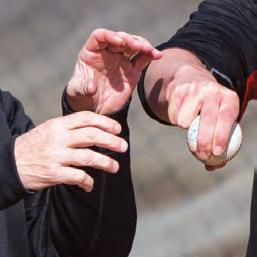
Walton was a finalist for the job, one that ultimately was given to Josh Holliday.
But life has a funny way of working out. Just days after being told he wasn’t being offered the job, the same man who didn’t peg Walton to lead the Cowboys, OSU athletic director Mike Holder, along with the man who did land the gig, took a trip to Tulsa. Their mission? To convince Walton to join Holliday as the Cowboys’ pitching coach.
If Walton felt scorned, he didn’t show it. And in fact, his decision — to go from a head coach to an assistant coach — came quick and easy.
“If it wasn’t Josh, it would have been hard,” Walton said. “Obviously, I interviewed for the job, but Josh is more than capable — he’s very, very smart. His uncle Dave and his dad were my coaches so it’s a much different situation when somebody like that is asking you to come on board.
“For me, it’s never been about whose name is on the front door. I just want to have a job where I can affect some young guys’ lives on and off the field, and I want to work with somebody that’s also on board with that. Josh is all about that, all about the human aspect of what we do, not just the baseball aspect of it.
IT MAKES WHAT WE DO WORTH IT AND MAKES IT A LOT OF FUN.”
“You say to yourself, ‘What are the important things?’ You want to work at a school that you enjoy being at, you want to work for people in the athletic department that you like being around and you want to be in a family atmosphere where you like being around each other at work and when you’re away from work.
“When those three things line up, you’ve got to feel pretty fortunate.”
And with that, Walton was back in orange and black.
FOR HOLLIDAY, GETTING WALTON ON BOARD
“WAS THE FIRST MOMENT OF TEAM BUILDING THAT OCCURRED HERE.”
“I was fortunate to get the opportunity to come back here as head coach, and Rob was certainly an awesome candidate and could have been the head coach here — I know that, he knows that,” Holliday said. “But what makes it special is, RIGHT FROM THE GET-GO, PEOPLE DISPLAYED A DESIRE TO BE HERE, A WILLINGNESS TO CHECK THEIR EGOS AT THE DOOR, A WILLINGNESS TO JOIN TOGETHER AND WORK AS A GROUP — that all started with Rob’s decision to come back to Oklahoma State.
“I give Coach Holder a lot of credit for encouraging me because he had so much respect for Rob. This isn’t about the title, it’s about the job and our love for Oklahoma State and our desire to do something fun and special.
“IT’S A PARTNERSHIP. I don’t care what I’m called or he’s called — we work together, and we work together with our staff and our players.”
And Walton’s work with the Cowboy pitching staffs over the last three years has only further solidified the universal belief that he is one of baseball’s top pitching coaches — at any level.
“Rob has the knowledge. He possesses the information, but what he does with the information is where he separates himself from others,” Holliday said. “What he does uniquely that so many can’t is he learns to get the best out of every single player.
“HE’S DEVELOPED A REALLY KEEN SENSE OF HOW TO MAXIMIZE EVERY PLAYER AND TURN GUYS INTO SUCCESSFUL, USABLE GUYS. Even if they don’t have 90-mile-per-hour stuff, he finds ways to create outs.
“He has guys always believing that they can. He has a ‘we can’ attitude vs. ‘we can’t’ — he always looks for the way to get it done.
“SOME PEOPLE ARE JUST GIFTED TEACHERS, AND ROB’S A GIFTED TEACHER. He’s able to relate well and explain things to kids in a way that they can understand. Even though he possesses a tremendous amount of knowledge, he knows how to deliver it in a way that a 20-year-old kid can actually do something with it. And THAT’S A TRUE ART IN COACHING.”
That art has been on full display. Over the last three years, Walton has turned a second baseman into a closer who set OSU’s career saves record, helped develop a hurler who wasn’t even on the Cowboys’ travel roster as a junior into the Big 12 pitcher of the year and molded his last pitching staff into one that turned in the lowest ERA by an OSU staff in over four decades.
IT’S WHY THE COWBOYS REFER TO WALTON AS “The Wizard.” No one can exactly pinpoint when or where the moniker was born, but everyone agrees it fits.
“The experience he has and the stories he has and all the players he’s coached that are in the big leagues — he’s helped develop so many guys,” said OSU junior pitcher Trey Cobb “Rob talks and you really pay attention because every time he talks, there’s a life lesson hidden in there somewhere. You’re like, ‘I can definitely take that and not only use it on the field but in life.’
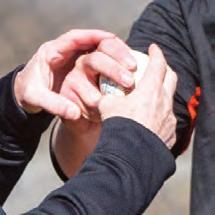
“HE CAN REALLY CAPTURE A ROOM WHEN HE TALKS. It’s different when you see him on the field and think he’s a quiet guy who keeps to himself. But when he’s in the room, when he talks, it’s like, wow, you’ve really got to listen.
“And the amount of work he puts in is unparalleled. Rob’s just one of those guys, he doesn’t give up on a player — he’s always going to try something new. He’s always looking at video, trying to compare you to a major leaguer. ‘Okay this guy did this and that worked for him, maybe that will work for this guy.’
66
SPRING 2016
“I’ve had a lot of great coaches growing up and all the coaches here are awesome, but THERE’S JUST SOMETHING ABOUT ROB THAT’S JUST DIFFERENT. The recruits that come in are like, ‘Tell us about Rob.’ And the only thing you can say is, ‘Man, he’s a wizard.’”
Cobb said his favorite Walton story sums up the coach’s “wizardry.”
“He was hitting fungoes one time, and he hit one and the bat sounded terrible, like it broke, a nasty break,” Cobb said. “He just tapped it on the ground and hit another one, and it sounded clean. We were like, ‘Did The Wizard just heal that bat?!’
“That’s Rob. That’s what I tell recruits. If the dude can heal bats, he can help you gain velocity.”
Magic and jokes aside, one thing is certain. Rob Walton knows pitching.
“Rob’s history of success speaks for itself and extends beyond the college game,” Holliday said. “There’s not a high school coach or amateur baseball coach in the country who doesn’t want to borrow information, or a professional organization that doesn’t hold him in the highest regard. He’s universally respected.”
Walton says he doesn’t necessarily have a pitching philosophy — he focuses on creating specific and basic plans for each individual.
“Ultimately what you’re trying to achieve is that they can pitch, that they can command the ball,” Walton said. “It wasn’t until I got hurt the first time and lost a little velocity that I understood what it means to pitch in, pitch out, when to do it, when you don’t do it, when to change speeds.
“There’s a lot of guys today with a lot of velocity going to the plate, but there’s a lot of high ERAs. Guys are throwing harder, but the ball is going out quicker. So you have to develop a pitcher, a guy that can command the ball and knows how to pitch. But what works for one guy, the same thing doesn’t necessarily work for the other and that’s what makes pitching really, really interesting.
“THE ART OF BEING ABLE TO MAKE A BALL MOVE AND CONSISTENTLY PUT IT IN A FOUR-INCH
AREA IS REALLY INTERESTING. You’re changing the speed and the plane with different pitches, but you’ve got to release the ball at a certain time at a certain spot to be able to get the ball where you want it to go.
“That challenge is what drives you.”
And while wins and losses and balls and strikes are often what define success, Walton doesn’t see it that way.
Sure he celebrates the achievements of Michael Freeman posting 10 wins and a 1.31 ERA as a senior and Brendan McCurry racking up 27 saves in two seasons, but that’s not what drives him.
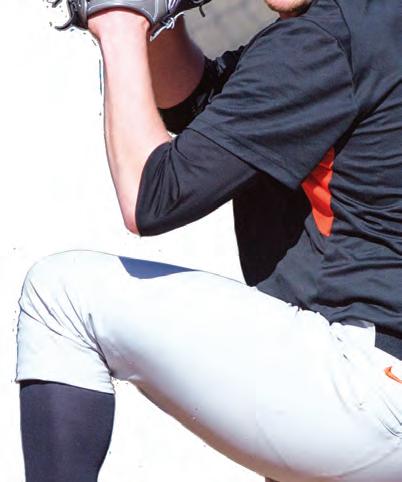
“THE JOY OF COACHING IS HELPING SOMEBODY FIND THEIR BEST AND WATCHING THEM HAVE FUN,” Walton said. “When it’s all said and done, nobody is going to remember the wins and the losses, it’s the relationships you have with your players. That’s the fun.
“The reason you go into it is because you want to help somebody achieve their dreams — keep them healthy and move them forward — because you know what it feels like. It’s a satisfying feeling. To see kids have that moment is really, really special.”
And doing it at Oklahoma State, the place he calls home, only adds to the gratification. “The Wizard” is quite content to be an assistant in Stillwater, sharing a dugout with his son Donnie, a senior short stop for the Cowboys. It’s why he turned down head coaching overtures from several prominent programs follow ing the 2015 season, to focus his attention on what matters most.

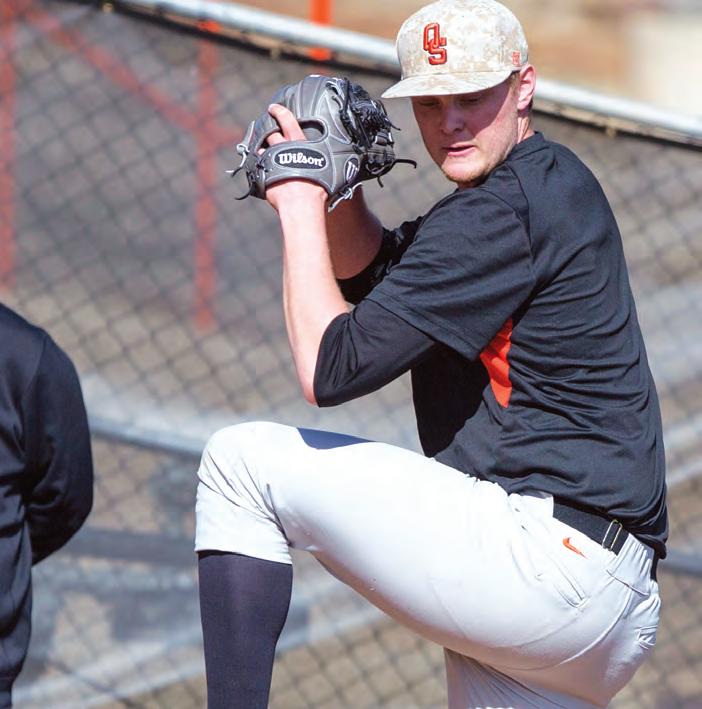
“I’m back where it all started for me,” Walton said. “It’s where I met my wife, it’s where I started to get educated on the baseball field; this is where I really started growing into a man.
“The first year taking a team to a regional was special. Watching guys like Jon Perrin and Vince Wheeland and Brendan McCurry and Michael Freeman develop — those are amazing things to watch. And then getting to watch my son (DONNIE) grow into a man and watch how hard he’s worked and succeeded on and off the field and had so much fun and the pride he feels in Oklahoma State and being a Cowboy, that same pride that I feel.
67
“IT’S JUST BEEN REALLY, REALLY SPECIAL AND SOMETHING I’M FORTUNATE TO BE A PART OF.”
Whatever is happening in your life, there’s a good chance your college experience helped you get to where you are today. When you reflect on that time, you may be overwhelmed by fond memories — meeting your spouse, celebrating a big football win, pulling an all-nighter to study or laughing with people who became your lifelong friends. Today’s Oklahoma State University students are having the same experiences as they pursue bright orange futures. Visit OSUgiving.com to learn how you can be a part of their journey.
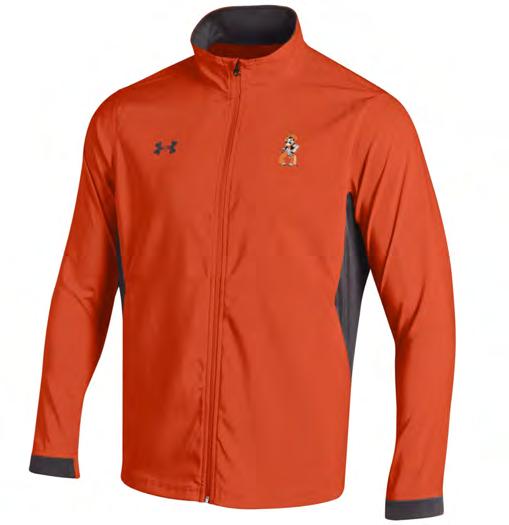


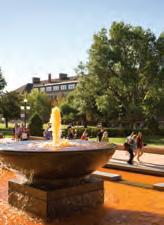

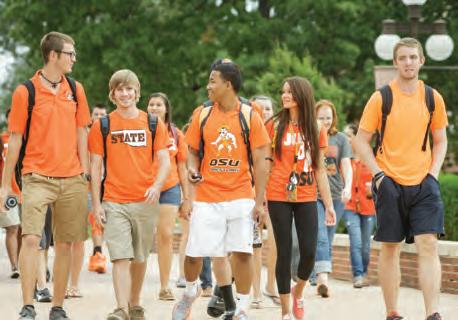


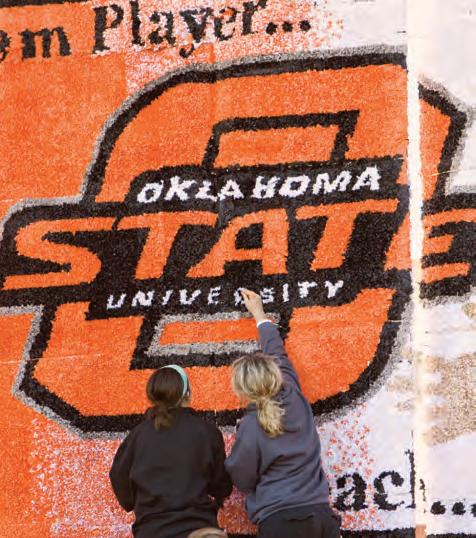
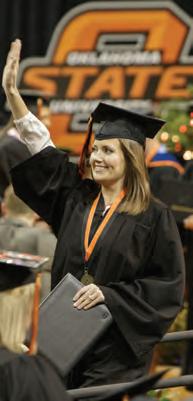
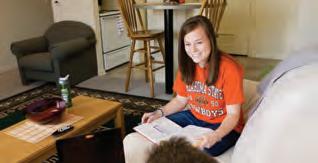





I Under Armour Apex Polo S-XXXL | $70.95 J Under Armour Long Sleeve Drapey Tee XS-XXL | $40.95 K Under Armour Tween Girls Baseball Tee


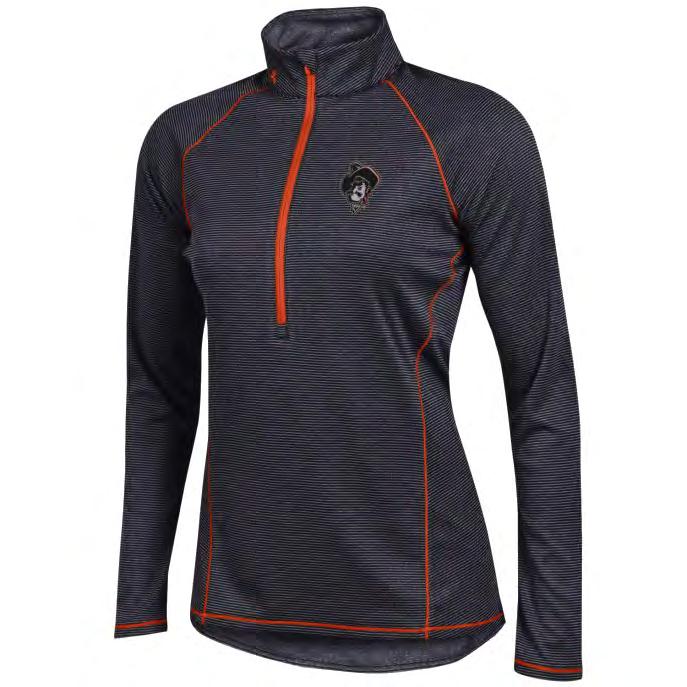
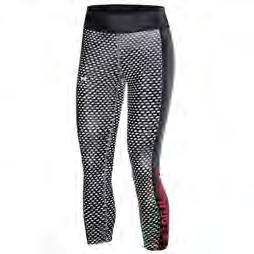

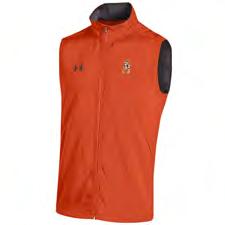







XS-XL | $30.95 L Under Armour Charged Cotton Tee S-XXL | $30.95 M Under Armour Woven Vest S-XXXL | $80.95 N Under Armour Youth Apex Tech Baseball Tee XS-XL | $30.95 O Under Armour Triblend Baseball Tee
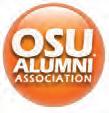
S-XXXL | $36.95 P Under Armour Limitless Show Me Tank S-XXL | $35

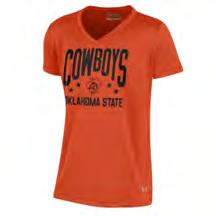
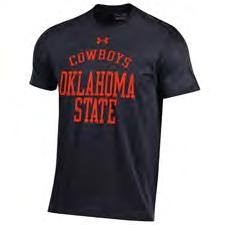

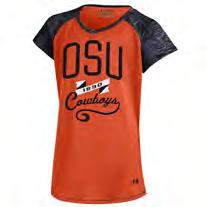



CELEBRATION STATION
THE Cowboy Track and Field team was recognized during a game at Gallagher-Iba Arena after capturing the 2016 Big 12 Indoor Championship THEIR SECOND TITLE IN THREE YEARS.

With a total team score of 130 points, the Pokes dethroned defending champ Texas by just 1.5 points in Ames, Iowa. Cowboys claimed four individual titles at the meet, including the mile, 1,000-meter run, 800m and 3,000m. In ONE OF THE MOST DRAMATIC FINISHES IN RECENT MEMORY, OSU placed four runners in the top six of the 3,000-meters to pull ahead of the Longhorns in the meet’s penultimate event. With four more points in the 4x400 meter relay, OSU was able to maintain its razor-thin margin of victory.
Meanwhile, the Cowgirl squad finished as the Big 12 Conference runner-up with 109 points, their HIGHEST TEAM TOTAL AND BEST FINISH IN SCHOOL HISTORY.
70
SPRING 2016
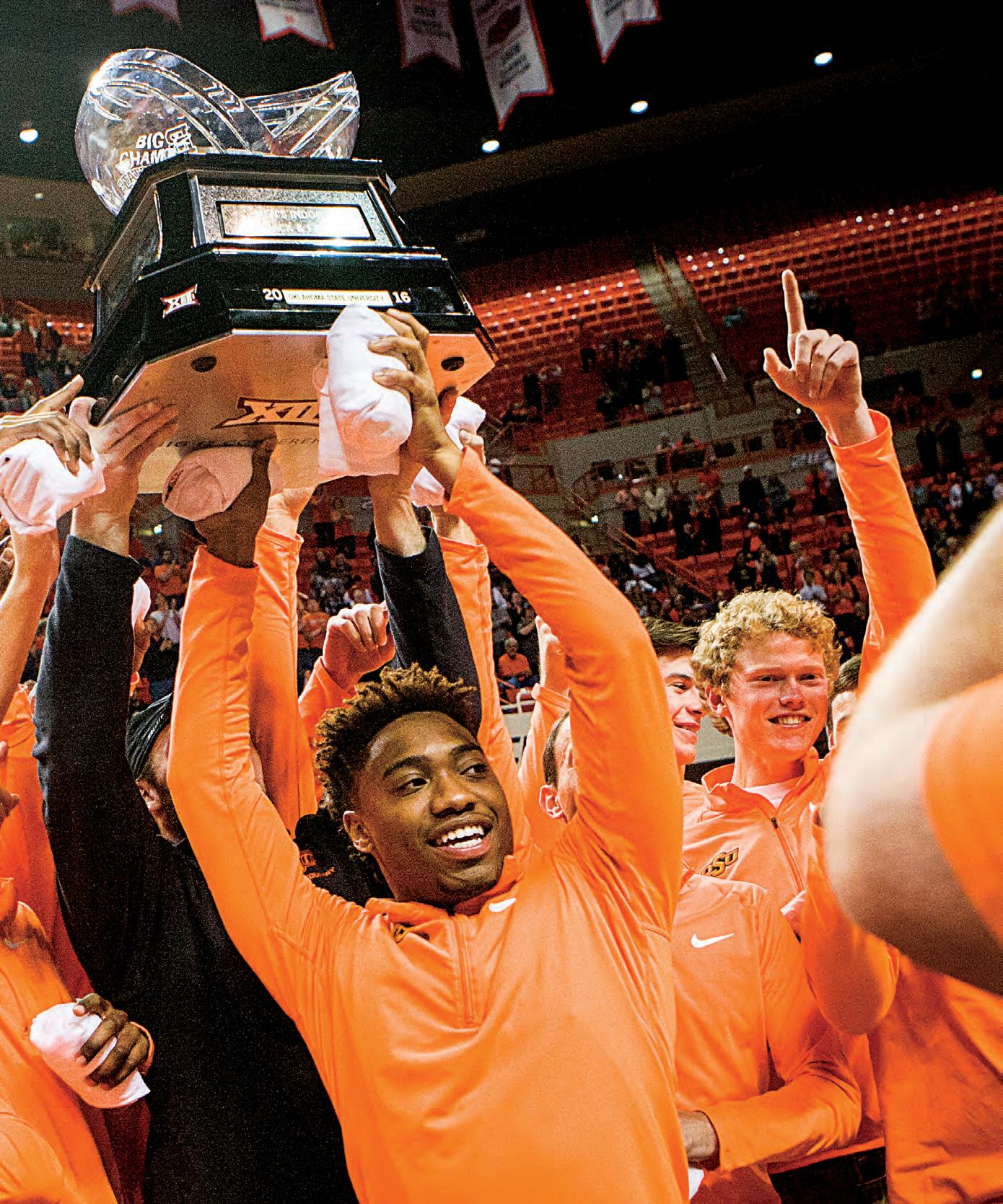
71
PHOTOGRAPHY BY GARY LAWSON
Honor Roll
When OSU announced its scholarship endowment initiative, the athletic program was last in the Big 12. Now, more than halfway through the 10-year program, OSU leads the conference.
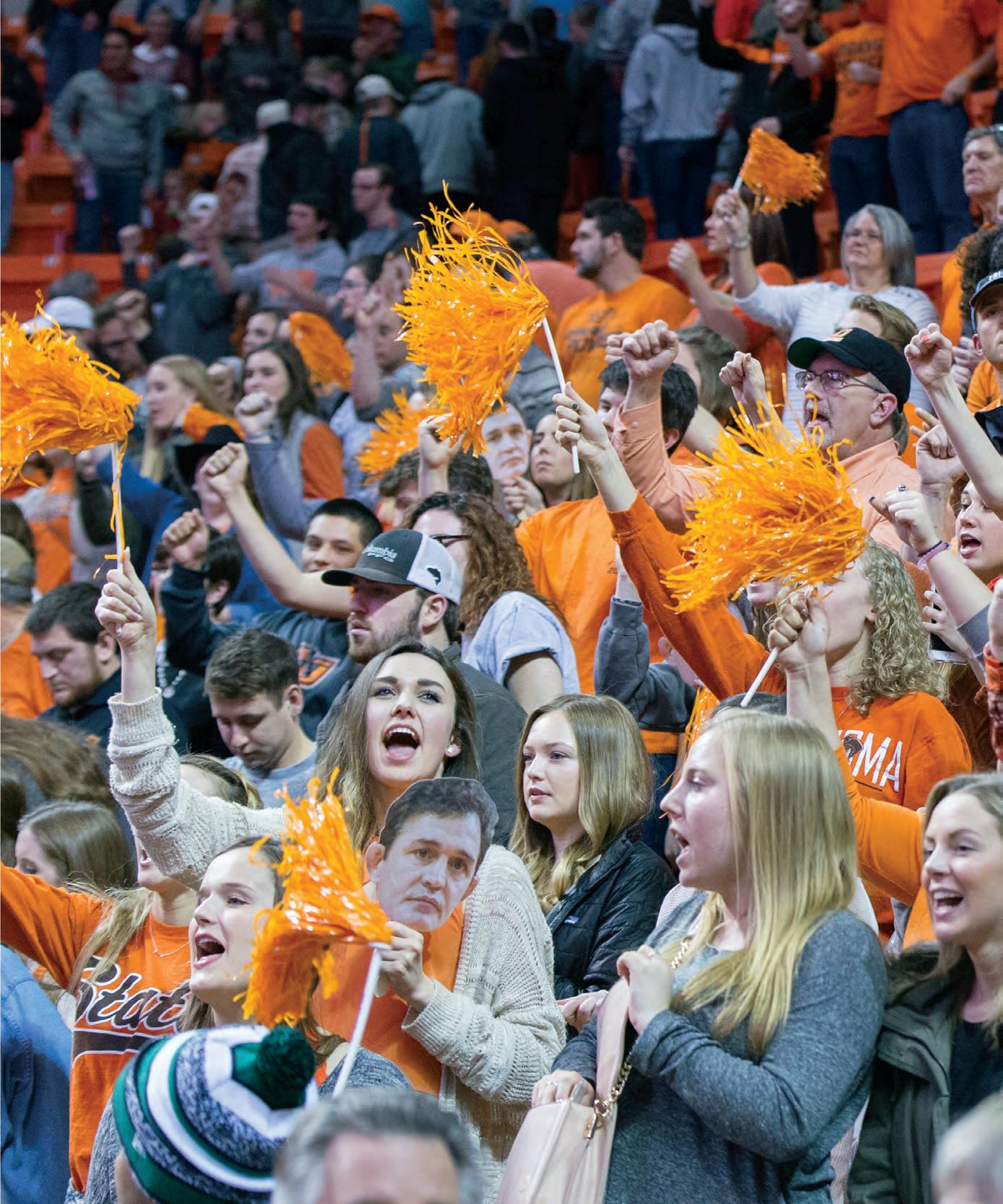
But we’re not finished yet.
OSU awards 229 full scholarships to student-athletes each year at a cost of $4.5 million. Each dollar freed up through endowed scholarships goes back into our PROGRAMS. BETTER EQUIPMENT. BETTER FACILITIES. BETTER SUPPORT. Each dollar has a direct impact on the lives of our student-athletes.
“Each scholarship we endow secures the future of OSU athletics and provides more opportunities for our studentathletes on and off the field , ” says Mike Holder, Vice President for Athletic Programs and Director of Intercollegiate Athletics.
This is the list of all the generous supporters who have helped to provide a bright Orange future. They are our HONOR ROLL .

To learn more about scholarship opportunities and how you may contribute, PLEASE CONTACT
Larry Reece (405-744-2824), Matt Grantham (405-744-5938) OR Shawn Taylor (405-744-3002).
“It has been amazing to see 315 donors step up to get us past the $58 million mark in commitments to the Leave A Legacy campaign.
The bottom line is OSU supporters get it … scholarships help our studentathletes today while strengthening our athletic budget forever.”
— LARRY REECE, SENIOR ASSOCIATE ATHLETIC DIRECTOR, DEVELOPMENT
BASEBALL 6.5
FULL SCHOLARSHIP
Dennis and Karen Wing (2)
Hal Tompkins
HALF SCHOLARSHIP
Mike Bode and Preston Carrier
Jennifer and Steven Grigsby
Sally Sparks
QUARTER SCHOLARSHIP
Bryant and Carla Coffman
David and Grace Helmer
Jill Rooker
Martha Seabolt
FOOTBALL 32.0
FULL SCHOLARSHIP
Bob and Kay Norris
Bryant and Carla Coffman / The Merkel Foundation

David LeNorman
Dennis and Karen Wing (2)
Dr. Mark and Beth Brewer
Jack and Carol Corgan Football Scholarship
Jim Click
John and Gail Shaw
HALF SCHOLARSHIP
Cindy Hughes
Donald Coplin
Doug Thompson
Ed and Helen Wallace
Greg Casillas
Ike and Marybeth Glass
Sandy Lee
Dr. Scott Anthony
John and Beverly Williams
Ken and Jimi Davidson
Leslie Dunavant
Mike and Kristen Gundy
Mike and Robbie Holder
Ron Stewart
Ross and Billie McKnight
Sandy Lee
Tom and Sandra Wilson
Wray and Julie Valentine
Jim and Lynne Williams
John and Patti Brett
Mike and Judy Johnson
Sally Sparks
State Rangers
Tom Naugle
QUARTER SCHOLARSHIP
Al and Martha Strecker
Arthur “Andy” Johnson, Jr.
Arthur Couch
Barry and Roxanne Pollard
Bill and Ruth Starr
Brad and Leah Gungoll
Brian K. Pauling
Bridgecreek Investment Management LLC
Bryan Close
David and Cindy Waits
David and Gina Dabney
Dr. Berno Ebbesson
Dr. Ron and Marilynn McAfee
Eddy and Deniece Ditzler
Flintco
Fred and Janice Gibson
GENERAL 1.25

HALF SCHOLARSHIP
Terry and Martha Barker
Fred and Karen Hall
Howard Thill
James and LaVerna Cobb
Jerry and Lynda Baker
Jerry and Rae Winchester
John P. Melot
John S. Clark
Ken and Leitner Greiner
Kent and Margo Dunbar
Paul and Mona Pitts
R. Kirk Whitman
Randal and Carol White
Roger and Laura Demaree
Shelli Osborn
Steve and Diane Tuttle
Tony and Finetta Banfield
72
AS OF 3/15/16 the SPRING 2016
QUARTER SCHOLARSHIP
David and Judy Powell
Kenneth and Susan Crouch
Sally Sparks
GRADUATE ATHLETE 0.75
QUARTER SCHOLARSHIP
Bob and Joan Hert
Neal Seidle
Tom and Cheryl Hamilton
MEN’S BASKETBALL 20.75
FULL SCHOLARSHIP
A.J. and Susan Jacques
Brett and Amy Jameson
Calvin and Linda Anthony
Chuck and Kim Watson
David and Julie Ronck (1.25)
Dennis and Karen Wing (2)
Douglas and Nickie Burns
HALF SCHOLARSHIP
Bill and Marsha Barnes
David and Julie Ronck
Dr. Mark and Susan Morrow
Jay and Connie Wiese
Griff and Mindi Jones
James and Mary Barnes
Jim Vallion
Ken and Jimi Davidson
Kent and Margo Dunbar
KimRay Inc.
Mitch Jones Memorial
Sally Sparks
Sandy Lee
Stan Clark
QUARTER SCHOLARSHIP
Dr. Scott and Lynne Anthony
Gary and Sue Homsey
Holloman Family
Michael and Heather Grismore
Rick and Suzanne Maxwell
Robert and Sharon Keating
Steve and Suzie Crowder
Terry and Donna Tippens
MEN’S GOLF 4.25
FULL SCHOLARSHIP
David and Julie Ronck
Dennis and Karen Wing
HALF SCHOLARSHIP
Stillwater National Bank
Jack and Carol Corgan Men’s Golf Scholarship
QUARTER SCHOLARSHIP
Bob and Elizabeth Nickles
Garland and Penny Cupp
Richard and Joan Welborn
MEN’S TENNIS 0.25
QUARTER SCHOLARSHIP
Tom and Cheryl Hamilton
MEN’S TRACK 0.75
QUARTER SCHOLARSHIP
Dr. Mark and Susan Morrow
Susan Anderson
Ken and Leitner Greiner
SOFTBALL 0.25
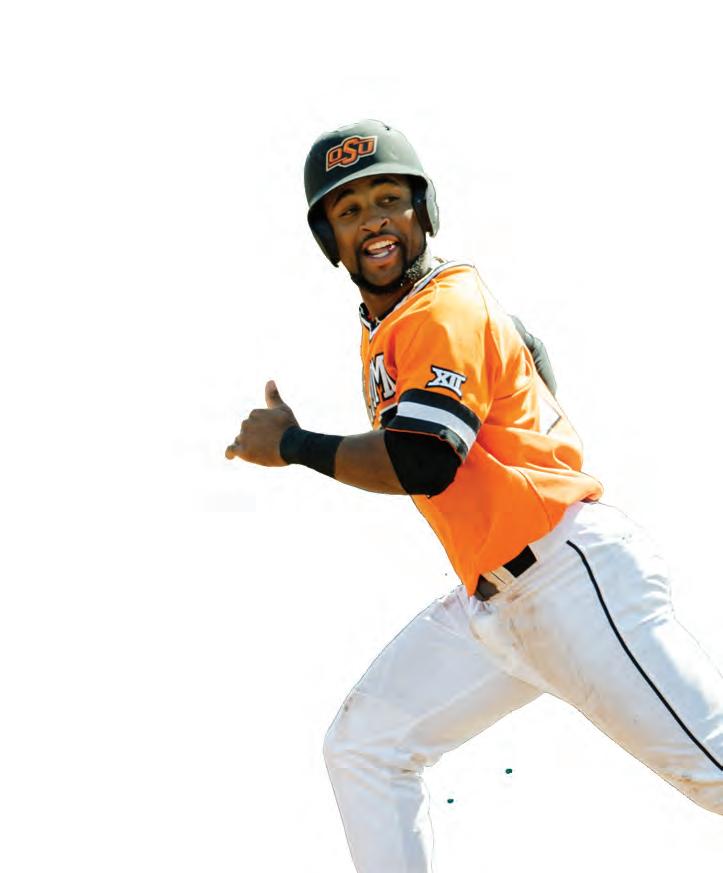
QUARTER SCHOLARSHIP
Tom and Cheryl Hamilton
WOMEN’S BASKETBALL 6.25
FULL SCHOLARSHIP
Brad and Margie Schultz
Ken and Jimi Davidson
Mike Bode and Preston Carrier
HALF SCHOLARSHIP
Baloo and Maribeth Subramaniam
Don and Mary McCall
John and Caroline Linehan
QUARTER SCHOLARSHIP
Bill and Roberta Armstrong
Bill and Sally Cunningham
Calvin and Linda Anthony
Donald Coplin
Jill Rooker
Jon and Nancy Patton
Richard and Linda Rodgers
WOMEN’S EQUESTRIAN 0.25
QUARTER SCHOLARSHIP
David and Gina Dabney
WOMEN’S GOLF 1.0
HALF SCHOLARSHIP
David and Julie Ronck
QUARTER SCHOLARSHIP
Amy Weeks
Kent and Margo Dunbar
WOMEN’S TENNIS 0.25
QUARTER SCHOLARSHIP
Jamie Maher
WRESTLING 10.75
FULL SCHOLARSHIP
A.J. and Susan Jacques
Bruce and Nancy Smith
Chuck and Kim Watson
Lon and Jane Winton
OSU Wrestling – White Jacket Club / Gallagher Endowed Wrestling Scholarship
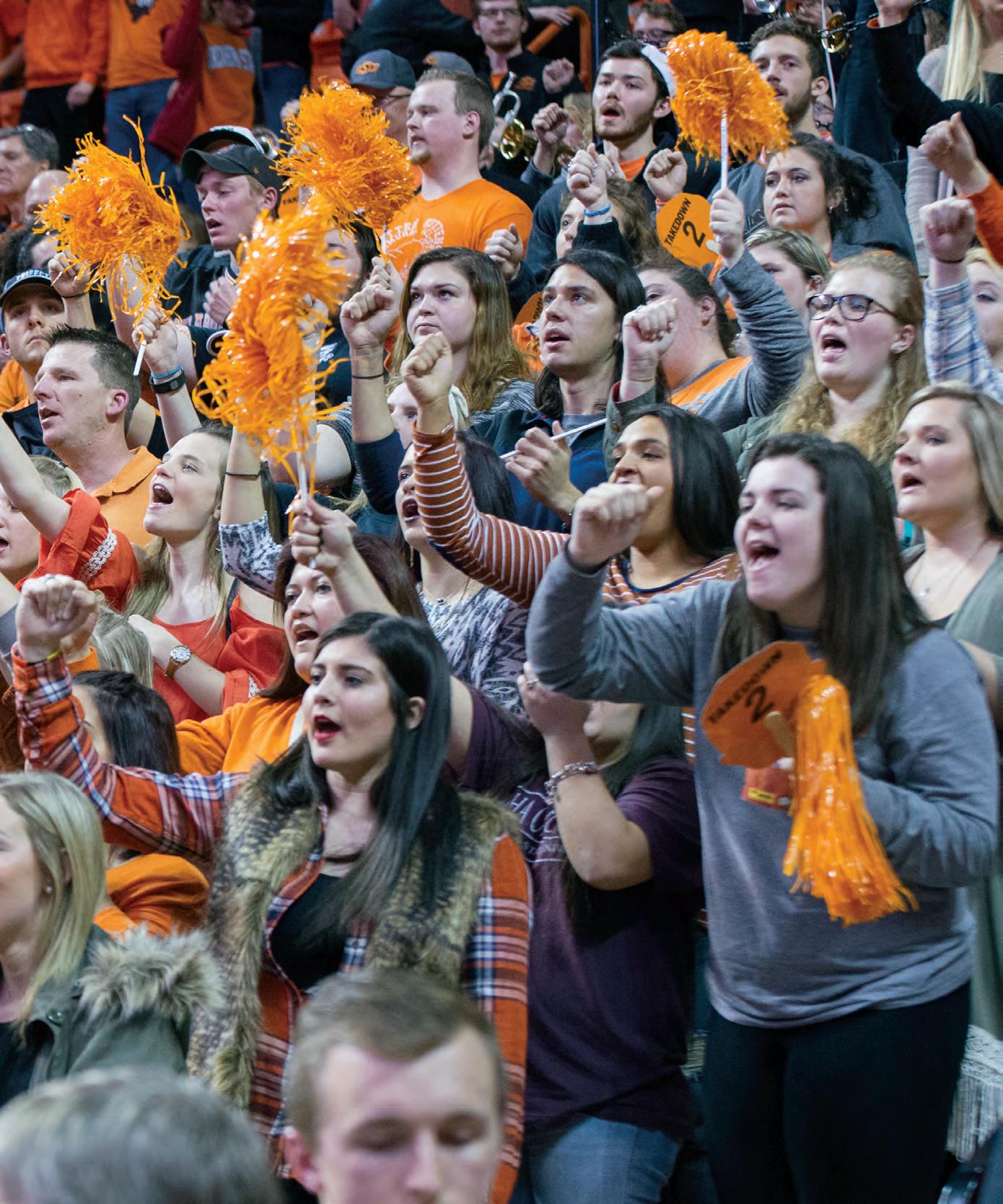
OSU Wrestling – White Jacket Club / Myron Roderick Endowed Wrestling Scholarship
HALF SCHOLARSHIP
Mark and Lisa Snell
Bobby and Michelle Marandi
QUARTER SCHOLARSHIP
Danny and Dana Baze / Cory and Mindy Baze
John and Beverly Williams
R.K. Winters
OSU Wrestling – White Jacket Club / Ray Murphy Endowed Wrestling Scholarship
OSU Wrestling – White Jacket Club / Tommy Chesbro Endowed Wrestling Scholarship
The Cobb Family
73
J.R. DAVIS
Nathan Gilsleider’s unlikely athletic journey features nearly as many twists and turns as the mile-long bobsled run near Lake Placid, New York.

 STORY BY CLAY BILLMAN
STORY BY CLAY BILLMAN
74
Former Cowboy Trades Turf for Ice
PHOTO COURTESY / WIKIMEDIA USER ERMENTRUDE
SPRING 2016
NESTLED AMONG WHITE PINE AND
SUGAR MAPLES on the western slope of the Adirondacks’ MT. VAN HOEVENBERG, the site of the 1980 WINTER OLYMPICS is now the TRAINING CENTER FOR USA BOBSLED AND SKELETON A young athlete from Claremore, Okla., CALLS THAT TRACK HOME as a member of TEAM USA
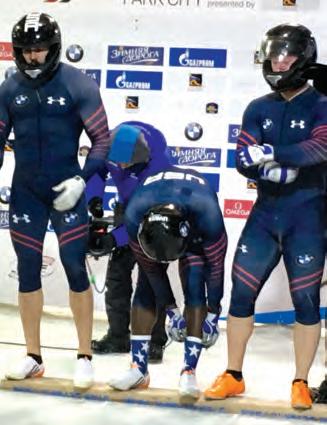
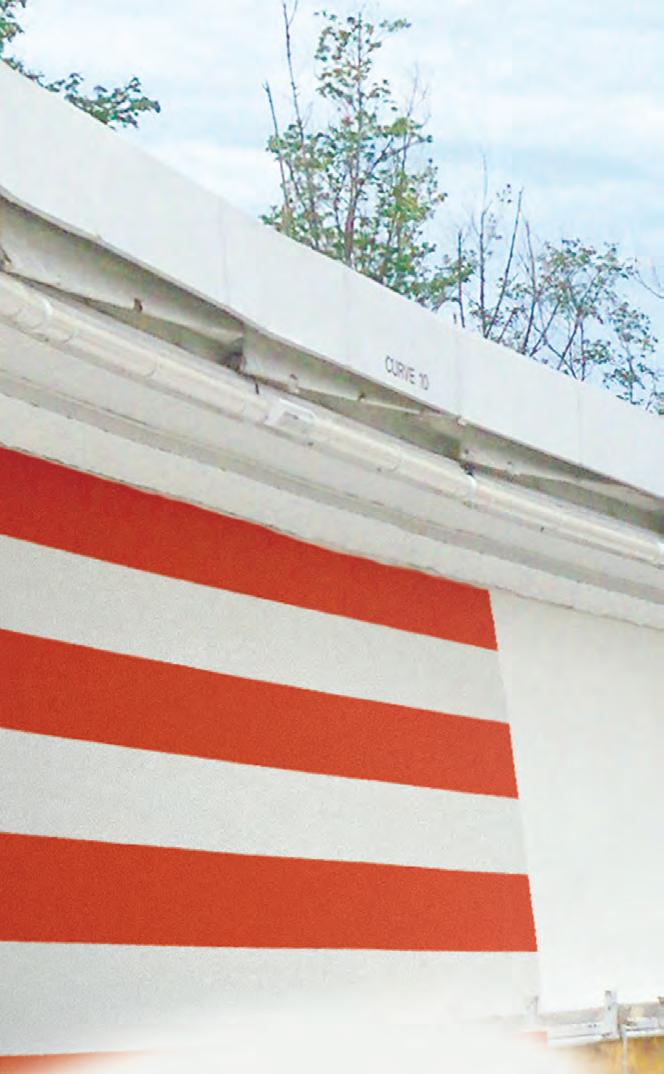
HOW A SMALL-TOWN OKLAHOMA KID ended up as an Olympic hopeful going 85 miles-per-hour down an icy chute in a RED, WHITE AND BLUE “TIN CAN” is remarkable, considering his rural roots.
The 15-man Team USA roster is larger than Gilsleider’s graduating class of a dozen at Claremore Christian School. There, the six-foot-three teenager EXCELLED IN BASEBALL, BASKETBALL AND SOCCER, earning all-state honors in all three sports (the private school didn’t field a football team until 2005, the year Gilsleider graduated).
“I HAD OFFERS TO PLAY ALL THREE OF THOSE SPORTS OUT OF HIGH SCHOOL, BUT I DECIDED TO TAKE A BASEBALL AND BASKETBALL SCHOLARSHIP
TO JUNIOR COLLEGE because I was left-handed and figured I would see what I could do out on the bump,” said Gilsleider.
Gilsleider pitched and played shooting guard at Hesston College in Kansas before transferring to Eastern Oklahoma State College in Wilburton his sophomore year to concentrate on baseball. Unfortunately, a shoulder joint injury (torn labrum) ended the lefthander’s promising pitching career.
“I tore up my shoulder and had to have surgery,” he says. “I spent the following year trying to rehab it, but I knew I couldn’t pitch anymore.”
BUT THE SPORTS BUG WOULDN’T DIE. Gilsleider enrolled at Oklahoma State in the spring of 2008 and set his sights on another athletic endeavor: FOOTBALL.

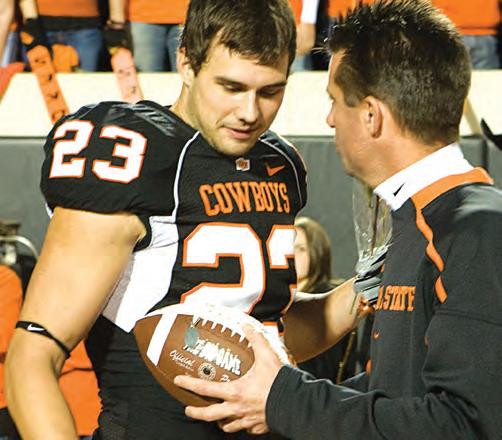
“THEY HAD A DAY WHERE YOU COULD COME AND TRY OUT AS A WALK-ON, SO I WENT Basically it’s like a mini (pro) combine. You do your 40, your bench press, your vertical. I’ve always been able to run fast and jump — those things have always come natural to me, so I WAS PRETTY CONFIDENT.”
Gilsleider excelled at the speed and agility drills but was worried his complete lack of football experience would be exposed.
“I was pretty leery of exposing the fact that I had never played football because I didn’t want that stigma,” he says. “I’m sure it stuck out like a sore thumb, but I just kind of worked my way around the questions, like ‘Where are you from? Where did you play?’”
75
With a 4.5 second 40-yard dash time, the lanky junior earned a spot on the roster with the wide receivers. His introduction to Division I football — or any football for that matter — came from Rob Glass , OSU’s assistant athletic director for athletic performance.
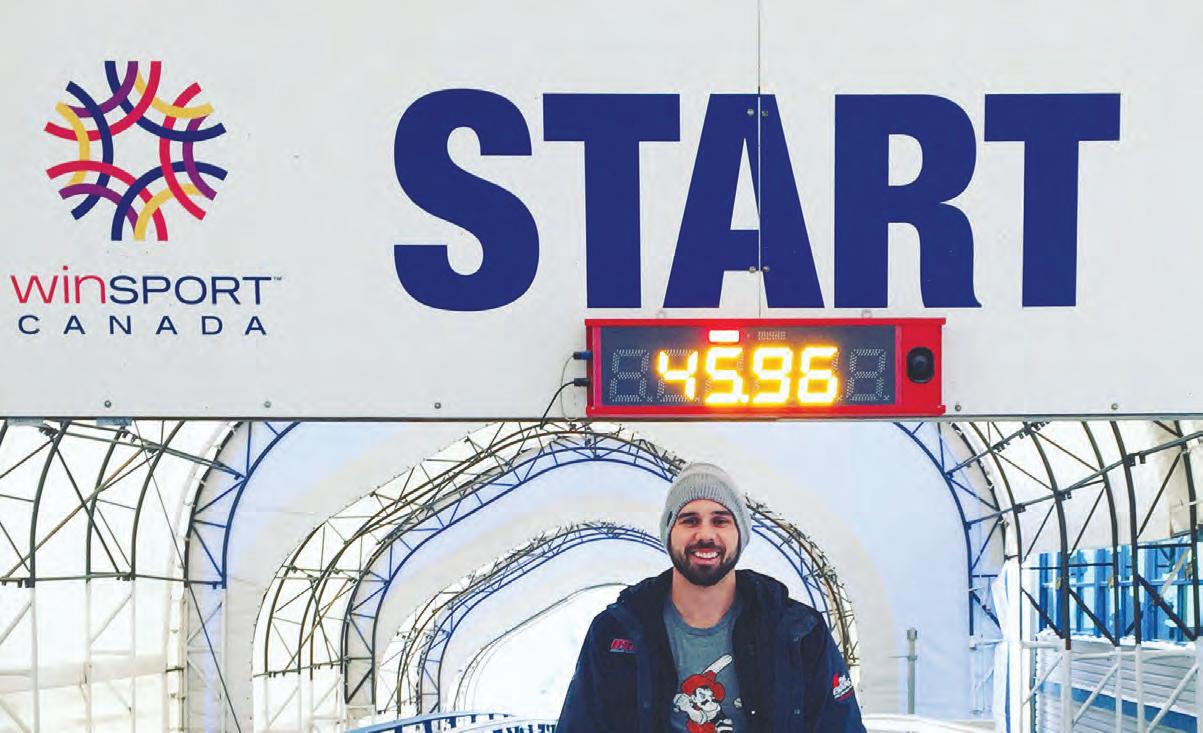
“To be honest, I HAD NEVER SPENT ANY TIME IN A WEIGHT ROOM UNTIL MY FIRST WORKOUT with Coach Glass,” Gilsleider admits. “OH, MAN! I DIDN’T UNDERSTAND WHAT WAS GOING ON. He was asking me to do stuff that should’ve been normal for anybody that had lifted weights, and I’M OVER HERE LOOKING LIKE I HAVE NO CLUE ABOUT WHAT’S GOING ON. That was quite the experience. Because I went to such a small school and played every sport, it wasn’t like I had any off time to ever get in the weight room. And junior
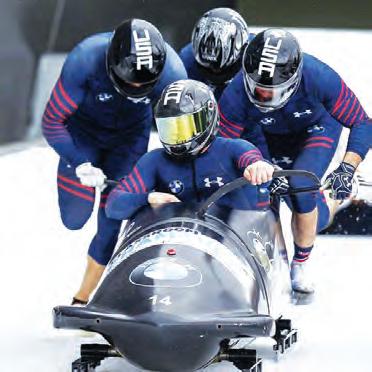
college was just about playing baseball, and then I got hurt. So I never got into it.
“When I got to OSU I was six-three, 190 pounds, and by the time I left after my twoand-a-half years there with Coach Glass, I was about 215.”
Gilsleider saw limited duty on the gridiron, but says he cherishes the time he spent in a Cowboy uniform, INCLUDING TRIPS TO THE Pacific Life Holiday Bowl AND AT&T Cotton Bowl. A number of his teammates will go down as all-time greats at OSU.
“ Dez Bryant and Justin Blackmon, Brandon Pettigrew, Russell Okung, Zac Robinson and Brandon Weeden is one of my really good friends. At the time, he was an unknown, so we were just hanging out, talking baseball.”
76
SPRING 2016
Being able to go to the Olympics and represent your country is something that very few people are able to do.
The former pitchers would warm up together on the sideline, where Gildsleider got to experience Weeden’s rifle arm firsthand.
“When we’d warm up, Zac would warm up with Dez, and Weeden would just chunk it to me. I was like, ‘My gosh!’ PLAYING BASEBALL IN OKLAHOMA YOU HEARD THE WEEDEN NAME. He and his younger brother were high draft picks. I had played summer ball against TY (Weeden) so I knew of the family and their baseball ability. It wasn’t any surprise to me that he could absolutely hum it.”
As a senior, Gilsleider became a valuable contributor on the sideline, thanks to an inventive play calling technique pioneered by the OSU staff. The offensive coaches asked Gilsleider to hold the LARGE, ILLUSTRATED SIGNS THAT INCLUDED A CODED SYSTEM OF COLORFUL LETTERS, NUMBERS AND SYMBOLS eventually evolving into humorous pop culture pictures including Hollywood stars and cartoon characters.
“WE WERE THE FIRST TEAM TO DO THE WHOLE CARD SYSTEM,” he says. “You raise it up, and the offense looks over … Depending on which card I flipped over in which slot, it told them what we were doing.”
That same year, Gilsleider began experiencing knee trouble.
“I started having some pretty bad knee problems,” he says. “I knew it was more than tendinitis. Something else was wrong. I went from running a 4.5 to about a 4.7, and my vertical dropped from a 38-and-ahalf inches to a 35 … After I finished playing, I went to a specialist and he discovered
that MY KNEECAP WAS ACTUALLY OFF-CENTER Every time I walked or did anything, it blew up on me.
“To be honest, after having a careerending shoulder surgery, I was a little scared that all of a sudden I was going to have another so I didn’t really divulge that to the coaches or training staff. I JUST TRIED TO TOUGH IT OUT AND NOT LET IT AFFECT ME. But it obviously did. I just tried to go up there every day and show the coaches that I was willing to be out there.”
Majoring in health promotion and education with an emphasis on exercise science, Gilsleider gravitated back toward the west end zone football facilities during his final semester on campus.
“Thanks to Coach Glass and Coach (Gary) Calcagno , I REALLY JUST FELL IN LOVE WITH THE WEIGHT ROOM ,” he says. “I saw the transformation that it put on my body. And knowing who those two are in the strength and conditioning world, there’s no better people to learn from. So right after I got done playing, I interned down there for a semester.”
A stint in Dallas at the MICHAEL JOHNSON PERFORMANCE CENTER followed, and a chance encounter changed the course of his athletic pursuits once again.
“When I was down there, I met an athlete by the name of JOHNNY QUINN . He played football at North Texas and had a ‘cup of coffee’ in the NFL with the Packers and Bills. He ended up hurting his knee and was in the process of rehabbing it. I got to know him, and we stayed in touch.”
By 2012, Gilsleider was living and working in Oklahoma City when he finally decided to get his own knee fixed.
“It got to the point where I couldn’t keep my knee bent for longer than 15-20 minutes without it starting to throb,” he says.
“Looking back, it was a very simple knee procedure. Within a month I was back to sprinting and playing basketball and doing things pain-free that I hadn’t done painfree in four or five years.”
Not only did he get back to playing pick-up basketball, he later latched on with the OKLAHOMA DEFENDERS , a professional arena football team in Tulsa.
“THAT WAS FUN, PLAYING ATHLETICS PAIN-FREE AGAIN,” he says.
“I actually got to play with Hubert Anyiam and Isaiah Anderson , both teammates of mine from OSU.”
Meanwhile, Gilsleider learned that Quinn had traded in his football cleats for a pair of bobsled spikes. Seeing his old friend in red, white and blue piqued his own interest in the sport.
“JOHNNY ACTUALLY MADE THE 2014 SOCHI GAMES,” Gilsleider says.

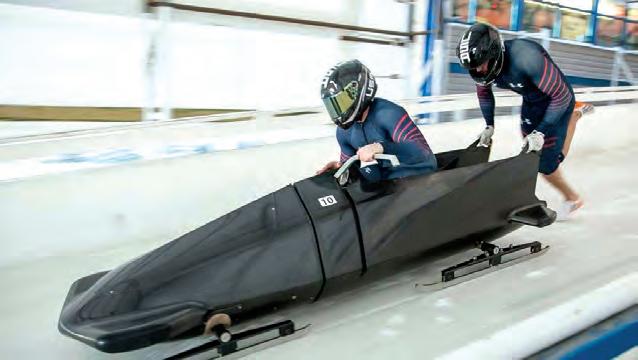
“SO I REACHED OUT TO HIM AND GOT HIS FEEL FOR IT … ‘WHAT DOES IT TAKE? WHAT’S IT LIKE? IS IT WORTH IT?”’
Gilsleider got the answers and encouragement he was seeking and drove to Colorado Springs to participate in a Team USA regional combine
77
“Basically, like most athletes, I WAS BLINDLY SELF-CONFIDENT,” he says. “I went into it like, ‘If you’re asking me to run, jump and push weight, I’m pretty confident I can do that with the best of them because of everything Coach Glass did for me.’
“It’s a point system,” he added. “You run your 30-meter dash and get points based on your time and so on … I did very well. WITH MY POINTS ADDED UP, I GOT LIKE SECOND OR THIRD OUT OF ALL THE COMBINES SO THEY WERE EAGER TO HAVE ME COME OUT TO LAKE PLACID AND GIVE IT A GO. I could just tell they were very keen on me, and that gave me confidence in my ability. Also, knowing the type of athlete that Johnny Quinn is, that’s who I size myself up with.
“IF YOU MEET ALL THE CRITERIA THEN THEY GET PRETTY EXCITED BECAUSE NOW THEY CAN JUST MOLD YOU AND TEACH YOU THE ACTUAL ART OF BOBSLEDDING.”
Gilsleider quickly caught on to the unique sport, earning an official roster spot on Team USA.
“After I made the World Cup team in my rookie season, that’s where those Olympic dreams started becoming a reality. You start thinking, ‘Hey, there’s a real possibility here.’”
Gilsleider is part of a youth movement for Team USA, which has opened the door for firsttime Olympic hopefuls.
“There were about eight guys who had been here a long time and were very successful in the sport so there wasn’t a whole
lot of movement,” he says. “But nearly all of them decided it was time to move on and pursue other ventures in life. Now, most of us are rookies or second-year guys, so things move quite a bit. There are opportunities to move up or down.”
One of a dozen brakemen on the roster, Gilsleider has been running in the No. 3 two-man sled, paired with driver NICK CUNNINGHAM , a sergeant in the Army and former track athlete at Boise State. The duo recently took sixth at the 2016 World Championships on their home course, finishing as the second-fastest Americans.
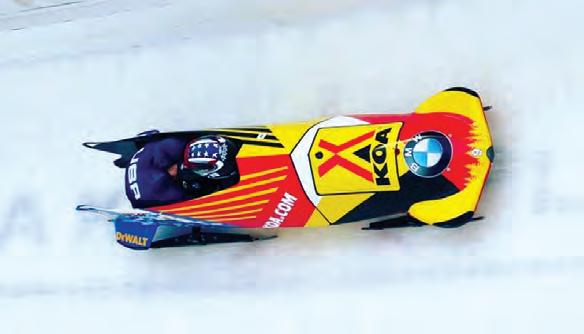
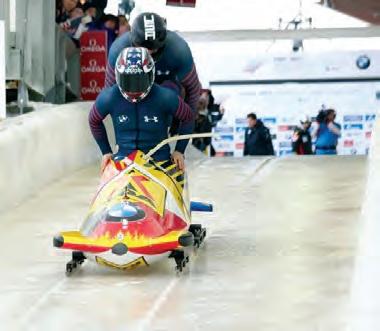
The top two Team USA sleds will earn a trip to the 2018 Winter Games in PyeongChang, South Korea.
“MY GOAL NEXT YEAR IS TO HOPEFULLY BE ON SLED 2 OR SLED 1. Right now, with the growth that I made in my rookie season, it’s very possible. I’m just trying to work my way up so it’s just a grind. I’ve just got to continue to grow, continue to learn. Really, it sounds cliché, but so much of what I learned from Coach (Mike) Gundy and Coach Glass I apply it every day here. It’s helped me out so far.”
Typically, bobsled pilots will command both a two- and four-man sled, Gilsleider explains, with brakemen chosen from among the remaining roster. It’s the brakemen’s job to give an all-out push at the start of a race, get in and then just hang on, only engaging the brake after the sled crosses the finish line.
“ THE HARD PART OF THE FOURMAN IS THE LOAD,” he says. “YOU’RE TRYING TO GET FOUR LARGE
HUMAN BEINGS — anywhere from 200- to 245-pound men — JUMPING IN A CARBON-FIBER SHELL AT THE SAME TIME so that can get kind of complicated when you’re doing it full speed on ice. They start you out on a two-man, and you take it pretty slow your first time. There are places in there for you to hold on, and you try to get as aerodynamic as possible, nice and low.
“IT’S BASICALLY A BAPTISMBY-FIRE KIND OF THING. If you can get over the fact that you’re running on ice, it’s really no different than running on anything else as long as you stay on your spikes, which are just on your forefoot. Other than that, you just don’t think about it and run like you normally would.”
Depending on the track, speeds can exceed 90 miles per hour.
“ WHISTLER, CANADA , has the fastest track in the world,” Gilsleider says. “IN TWO-MAN, WE HIT 94, 95 MILES AN HOUR. Here in LAKE PLACID , you’re typically in the low 80s because it’s so technical with so many turns.
“OUR HOME TRACK IS KNOWN AS THE MOST TECHNICAL AND ROUGHEST ON OUR BODIES, SO IT’S AN ADVANTAGE IN A WAY, THAT WHENEVER WE DO RACE HERE, WE’RE WELL PREPARED. It’s also an advantage that when you go other places, you’re kind of like, ‘Oh wow, that was easy. My body’s fine.’”
Gilsleider admits he wasn’t ready for his first bobsled run.
“It’s really hard to describe,” Gilsleider says. “It’s so violent and rough and you

78
SPRING 2016
can’t see anything, and you’ve just got to hold on and do your best. I THINK SOMEONE LIKENED IT TO GETTING PLACED IN A TIN TRASHCAN AND GETTING KICKED DOWN A HILL. I think that’s probably the best analogy I’ve heard for it.”
And that’s just the successful runs. Crashes are not uncommon in the sport.

“I’ve crashed once … pretty good. We were going at Whistler, the fastest track in the world. There’s a section of turn called ‘50/50’ because you’ve got a 50 percent chance of coming out of there … we flipped all the way upside down. We were riding on our backs. YOU WEAR THESE BURN VESTS UNDERNEATH THAT BASICALLY KEEP YOU FROM GETTING ROAD RASH so luckily we had that. It was pretty scary.”
Gilsleider says he doesn’t dwell on the inherent dangers.
“To be honest, I don’t really think about it much. For me, it’s just another sport. You do crash, but that’s just what happens. For me, it’s a question of whether I feel like this is what I’m supposed to be doing. Do I feel like doors are opening up? I’ve prayed about it a lot so I feel very comfortable with it. I’M DOING WELL HERE. ”
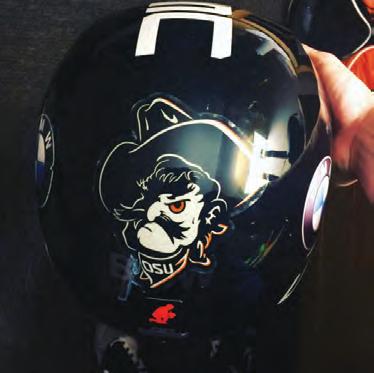
There are no big money contracts for Olympic bobsled hopefuls. No lucrative endorsement deals.
“It’s a sacrifice,” Gilsleider says. “But for me, I’ve come to the realization that IF YOU DON’T ENJOY YOUR JOB, IT DOESN’T MATTER THE AMOUNT OF MONEY YOU MAKE. I know this is the realm I need to be in to be happy. If this leads to a strength and conditioning job down the line or to opening up my own performance facility, I don’t know. But I know that I just need to be around it. IS IT A SACRIFICE FINANCIALLY? YES,
BUT IT’S ALSO A BLESSING FOR ME BECAUSE IT’S THE OPPORTUNITY OF A LIFETIME. Being able to go to the Olympics and represent your country is something that very few people are able to do.”
GILSLEIDER SPENDS MUCH OF THE YEAR IN LAKE PLACID, TRAINING AND TRAVELING FOR COMPETITIONS. It’s become his home-away-from-Oklahoma.
“Whenever you’re in season, you’re traveling so much, but our home base is here in Lake Placid and they have a training center here. We have rooms they’ll let you stay in between races. In the summer, in the offseason, depending on your ranking, you also may have housing here. They have training table — three meals a day, all the snacks you want — so it’s very good.”
Bobsledders consume — and burn — a lot of calories in a typical day.
“When you do training runs, it’s typically just two runs a day because of the time it takes. In the mornings I sprint, in the afternoons I lift and we have a practice push track here. IT’S A FULL DAY … YOU’RE LOOKING AT 6-8 HOURS A DAY OF TRAINING.”
The pursuit of Olympic dreams is often a full-time job that doesn’t pay like one.
“Some guys will work in the offseason, some won’t if they’re lucky enough to find funding in other ways. For me, I’ve been fortunate enough to have some funding through a non-profit Olympic training fund to help with travel and other expenses. Also, if you make it to certain levels on the national team, they give you stipends so you can make a little bit of money to help you out. I’M DEFINITELY NOT IN THIS FOR THE MONEY! ”
Throughout his journey, Gilsleider has stayed true to his roots.
“I’m really proud of where I’m from,” he says, “TO MAKE IT AS FAR AS I HAVE TO THIS POINT, A LOT OF THAT HAS TO DO WITH GROWING UP IN OKLAHOMA, my family, my school … AS WELL AS MY TIME AT OSU. Coach Glass always says, ‘THERE’S NO SUBSTITUTE FOR HARD WORK AND DEDICATION.’ THAT’S SOMETHING I LIVE BY EVERY DAY, to try to be dedicated to my craft and outwork the next person.
79
THE PURSUIT OF OLYMPIC DREAMS IS OFTEN A FULL-TIME JOB THAT DOESN’T PAY LIKE ONE … BUT IT’S ALSO THE OPPORTUNITY OF A LIFETIME.
I BELIEVE THAT WILL GET ME TO THE OLYMPICS.”



Connecting Students, Alumni, and Employers Oklahoma State University Career Services 360 Student Union, Stillwater, Oklahoma 74078 careers@okstate.edu 405-744-5253 HireOSUgrads.com Career Fairs - Job Postings - Online Résumés - On-Campus Recruiting



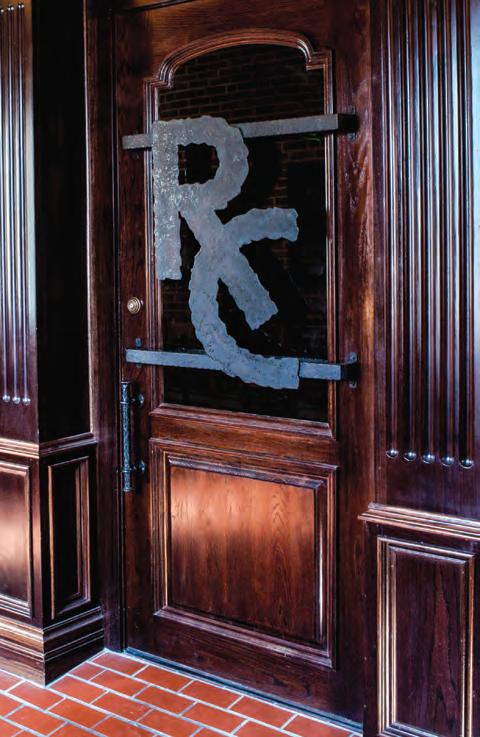

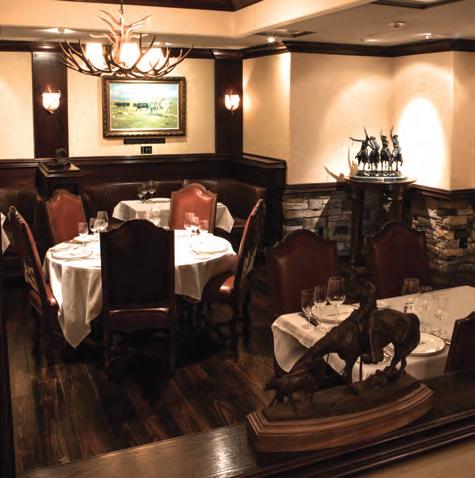
Lunch served Monday thru Friday, 11 a.m.–2 p.m. Dinner served Tuesday thru Saturday 5 p.m.–9 p.m. 405-744-BEEF (2333) theRanchersClub.com 405-744-6835 AthertonHotelatOSU.com Where STATE ly T radiTion Meets ModernElegance
SPRING IS A TIME OF RENEWAL AND REGENERATION. It’s when icy winter melts into a hundred new colors, shapes and allergy inducing spores. The grass begins to grow, even without fertilizer. Especially on a baseball diamond. A poet once said, “I think that I shall never see, a thing as lovely as a tree.” That guy must have never seen a FRESHLY MOWED BASEBALL FIELD. Do you recall what it was like the first time you walked into a baseball park? One that was well taken care of? Beautiful. Allie P. Reynolds baseball field is such a place
If an alien landed in your back yard and asked you to explain baseball ... could you?
IT’S A GAME WHERE a guy with a club stands next to a plate that’s buried in the ground while another guy who is perched on an elevated mound hurls a hard ball at the other guy at speeds of up to 100 MPH. The second guy’s job is to defend himself with the club and hit the ball past a bunch of other guys randomly standing in a field. Then you run to a series of bases before they tag you out, a blending of another unrelated childhood game.
THERE IS MANDATORY ATTIRE. Modified pajamas. Knickers on steroids. They may be short or they may be long. It depends on the team and the player. Hats are worn. Back in the good old days, they had curved bills. No longer. The flat bill is in.
Baseball even has its own brand of language. Eccentric phrases like: Ducks on the pond. Rock and fire. Gap band. Touch them all. It’s a no no. Come on, blue!
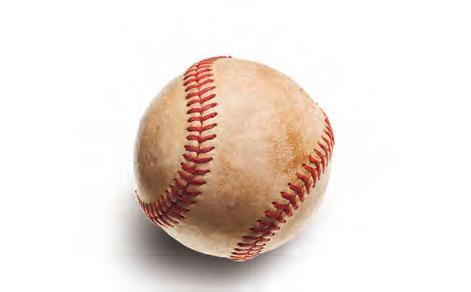
Some forms of communication are exhibited by inaudible hand signals. A potpourri of gestures, winks, claps, brushes, pointing and stomps.
THEN THERE IS THE FOOD. Can someone explain to me why a hotdog tastes so much better in a ballpark than it does anywhere else? I mean, it’s processed meat and bread with a little mustard
and ketchup. But we wolf them down in record numbers in baseball parks across the country. Peanuts and sunflower seeds have come and gone, and come back again. I played in a sixteen-and-under game once where a friend of mine was enjoying a huge handful of sunflower seeds. The problem was he was playing rightfield at the time and had a fly ball hit to him. The results were not good. It seems we always have to be shoving some type of munchie into our mouths between innings.
THE MEMORIES OF THIS PHENOMENON takes us all the way back to little league baseball. Remember Big League Chew, FunDip (a candy stick you dipped into flavored powder) and those long thin sticks of green apple and grape flavored gum? GOOD TIMES.
EVERY SPORT HAS ITS OWN EMOTION, and emotions spill out at times. Those displays are hard to miss in baseball. Sometimes coaches get upset at the umpires. Yankee Skipper Billy Martin and Oriole Manager Earl Weaver were both Picassos of petulance. Their spitting, cursing, entertaining, funny onelined assaults on umpires were just part of the show. And who can forget
the explosion that was famous Kansas City Royal George Brett, as he came rocketing out of the dugout in Yankee Stadium after his homer was called an out because of pine tar on his bat. Now that was emotion spilled out! Google it. George Brett was worn out after that tirade.
Whether the alien would understand your description of the great game of baseball is up for debate. What’s not is how much fun it is to just relax, sit back and experience the game. It’s slower paced. And that’s ok. All the stuff causing you stress will wait. ONE OF THE MOST PLEASANT PLACES TO WATCH BASEBALL IS RIGHT HERE IN STILLWATER, OKLAHOMA. Coach Holliday does a fantastic job and our team represents Oklahoma State well. Take me out to the ball game, with a curved bill baseball cap IN ORANGE.
GO
 POKES!
POKES!
SPRING 2016
82
KYLE WRAY VICE PRESIDENT ENROLLMENT MANAGEMENT & MARKETING KYLEWRAYOSU @KYLEWRAYOSU
A IN Walk PARKTHE
Beginning August 23, you’ll be able to access the world with two daily hassle-free flights to D/FW from Stillwater. Factor in free parking and quick boarding with short lines. Factor out travel time and expense to either OKC or Tulsa, and you’ll see the convenience and simplicity of Stillwater Regional Airport and American Airlines.

is money. Save both. Fly Stillwater.
Time
Aircraft operated by Envoy ®





















































 PHOTOS BY BRUCE WATERFIELD
STORY BY JOHN HELSLEY
PHOTOS BY BRUCE WATERFIELD
STORY BY JOHN HELSLEY





































































































 STORY BY CLAY BILLMAN
STORY BY CLAY BILLMAN






















 POKES!
POKES!

